Hangzhou Hikvision Digital Technology K1A801EF Fingerprint Time Attendance Terminal User Manual
Hangzhou Hikvision Digital Technology Co., Ltd. Fingerprint Time Attendance Terminal
User Manual

Fingerprint
1
Fingerprint Time Attendance Terminal
User Manual
V1.0
UD02461B
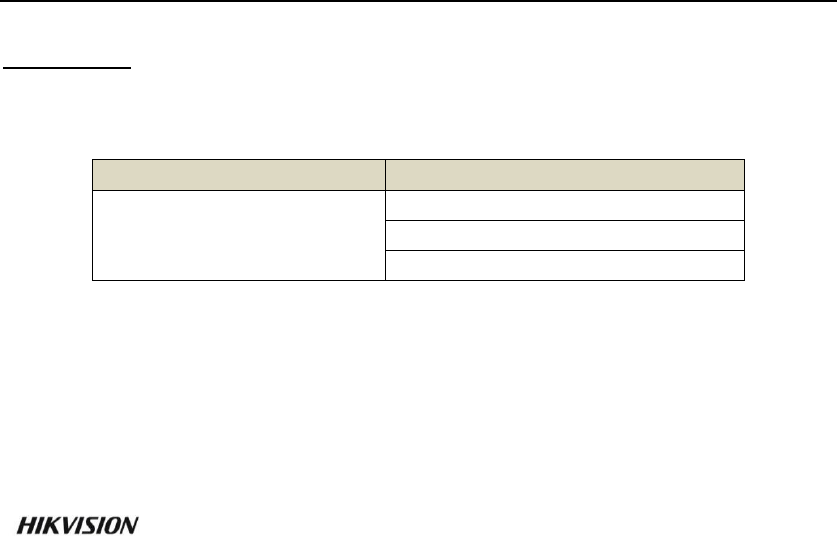
Fingerprint Time Attendance Terminal
i
User Manual
©2016 Hangzhou Hikvision Digital Technology Co., Ltd.
This Manual is intended for users of the series below:
Name
Model
Fingerprint Time
Attendance Terminal
DS-K1A801F
DS-K1A801MF
DS-K1A801EF
It includes instructions on how to use the Product. The software embodied in the
Product is governed by the user license agreement covering that Product.
About this Manual
This Manual is subject to domestic and international copyright protection. Hangzhou
Hikvision Digital Technology Co., Ltd. (“Hikvision”) reserves all rights to this manual.
This manual cannot be reproduced, changed, translated, or distributed, partially or
wholly, by any means, without the prior written permission of Hikvision.
Trademarks
and other Hikvision marks are the property of Hikvision and are
registered trademarks or the subject of applications for the same by Hikvision and/or
its affiliates. Other trademarks mentioned in this manual are the properties of their
respective owners. No right of license is given to use such trademarks without
express permission.
Legal Disclaimer
TO THE MAXIMUM EXTENT PERMITTED BY APPLICABLE LAW, THE PRODUCT
DESCRIBED, WITH ITS HARDWARE, SOFTWARE AND FIRMWARE, IS PROVIDED “AS IS”,
WITH ALL FAULTS AND ERRORS, AND HIKVISION MAKES NO WARRANTIES, EXPRESS
OR IMPLIED, INCLUDING WITHOUT LIMITATION, MERCHANTABILITY, SATISFACTORY
QUALITY, FITNESS FOR A PARTICULAR PURPOSE, AND NON-INFRINGEMENT OF THIRD
PARTY. IN NO EVENT WILL HIKVISION, ITS DIRECTORS, OFFICERS, EMPLOYEES, OR
AGENTS BE LIABLE TO YOU FOR ANY SPECIAL, CONSEQUENTIAL, INCIDENTAL, OR
INDIRECT DAMAGES, INCLUDING, AMONG OTHERS, DAMAGES FOR LOSS OF
BUSINESS PROFITS, BUSINESS INTERRUPTION, OR LOSS OF DATA OR
DOCUMENTATION, IN CONNECTION WITH THE USE OF THIS PRODUCT, EVEN IF
HIKVISION HAS BEEN ADVISED OF THE POSSIBILITY OF SUCH DAMAGES.
REGARDING TO THE PRODUCT WITH INTERNET ACCESS, THE USE OF PRODUCT SHALL
BE WHOLLY AT YOUR OWN RISKS. HIKVISION SHALL NOT TAKE ANY RESPONSIBILITIES
FOR ABNORMAL OPERATION, PRIVACY LEAKAGE OR OTHER DAMAGES RESULTING
FROM CYBER ATTACK, HACKER ATTACK, VIRUS INSPECTION, OR OTHER INTERNET
SECURITY RISKS; HOWEVER, HIKVISION WILL PROVIDE TIMELY TECHNICAL SUPPORT
IF REQUIRED.
SURVEILLANCE LAWS VARY BY JURISDICTION. PLEASE CHECK ALL RELEVANT LAWS IN
YOUR JURISDICTION BEFORE USING THIS PRODUCT IN ORDER TO ENSURE THAT
YOUR USE CONFORMS THE APPLICABLE LAW. HIKVISION SHALL NOT BE LIABLE IN THE
EVENT THAT THIS PRODUCT IS USED WITH ILLEGITIMATE PURPOSES.

Fingerprint Time Attendance Terminal
ii
IN THE EVENT OF ANY CONFLICTS BETWEEN THIS MANUAL AND THE APPLICABLE
LAW, THE LATER PREVAILS.
Support
Should you have any questions, please do not hesitate to contact your local dealer.

Fingerprint Time Attendance Terminal
iii
Regulatory Information
FCC Information
Please take attention that changes or modification not expressly approved by the
party responsible for compliance could void the user’s authority to operate the
equipment.
FCC compliance: This equipment has been tested and found to comply with the
limits for a Class B digital device, pursuant to part 15 of the FCC Rules. These limits
are designed to provide reasonable protection against harmful interference in a
residential installation. This equipment generates, uses and can radiate radio
frequency energy and, if not installed and used in accordance with the instructions,
may cause harmful interference to radio communications. However, there is no
guarantee that interference will not occur in a particular installation. If this
equipment does cause harmful interference to radio or television reception, which
can be determined by turning the equipment off and on, the user is encouraged to
try to correct the interference by one or more of the following measures:
—Reorient or relocate the receiving antenna.
—Increase the separation between the equipment and receiver.
—Connect the equipment into an outlet on a circuit different from that to which the
receiver is connected.
—Consult the dealer or an experienced radio/TV technician for help.
This equipment should be installed and operated with a minimum distance 20cm
between the radiator and your body.
FCC Conditions
This device complies with part 15 of the FCC Rules. Operation is subject to the
following two conditions:
1. This device may not cause harmful interference.
2. This device must accept any interference received, including interference that may
cause undesired operation
EU Conformity Statement
This product and - if applicable - the supplied accessories too are
marked with "CE" and comply therefore with the applicable harmonized
European standards listed under the RE Directive 2014/53/EU, the EMC
Directive 2014/30/EU, the RoHS Directive 2011/65/EU.
2012/19/EU (WEEE directive): Products marked with this symbol cannot
be disposed of as unsorted municipal waste in the European Union. For
proper recycling, return this product to your local supplier upon the
purchase of equivalent new equipment, or dispose of it at designated
collection points. For more information see: www.recyclethis.info.
2006/66/EC (battery directive): This product contains a battery that cannot be
disposed of as unsorted municipal waste in the European Union. See
the product documentation for specific battery information. The battery
is marked with this symbol, which may include lettering to indicate
cadmium (Cd), lead (Pb), or mercury (Hg). For proper recycling, return
the battery to your supplier or to a designated collection point. For
more information see: www.recyclethis.info.
Industry Canada ICES-003 Compliance
This device meets the CAN ICES-3 (B)/NMB-3(B) standards requirements.

Fingerprint Time Attendance Terminal
iv
This device complies with Industry Canada licence-exempt RSS standard(s).
Operation is subject to the following two conditions:
(1) this device may not cause interference, and
(2) this device must accept any interference, including interference that may cause
undesired operation of the device.
Le présent appareil est conforme aux CNR d'Industrie Canada applicables aux
appareils radioexempts de licence. L'exploitation est autorisée aux deux conditions
suivantes :
(1) l'appareil ne doit pas produire de brouillage, et
(2) l'utilisateur de l'appareil doit accepter tout brouillage radioélectrique subi, même
si le brouillage est susceptible d'en compromettre le fonctionnement.
Under Industry Canada regulations, this radio transmitter may only operate using an
antenna of a type and maximum (or lesser) gain approved for the transmitter by
Industry Canada. To reduce potential radio interference to other users, the antenna
type and its gain should be so chosen that the equivalent isotropically radiated
power (e.i.r.p.) is not more than that necessary for successful communication.
Conformément à la réglementation d'Industrie Canada, le présent émetteur radio
peut
fonctionner avec une antenne d'un type et d'un gain maximal (ou inférieur) approuvé
pour l'émetteur par Industrie Canada. Dans le but de réduire les risques de brouillage
radioélectrique à l'intention des autres utilisateurs, il faut choisir le type d'antenne et
son gain de sorte que la puissance isotrope rayonnée équivalente (p.i.r.e.) ne dépasse
pas l'intensité nécessaire à l'établissement d'une communication satisfaisante.
This equipment should be installed and operated with a minimum distance 20cm
between the radiator and your body.
Cet équipement doit être installé et utilisé à une distance minimale de 20 cm entre le
radiateur et votre corps.
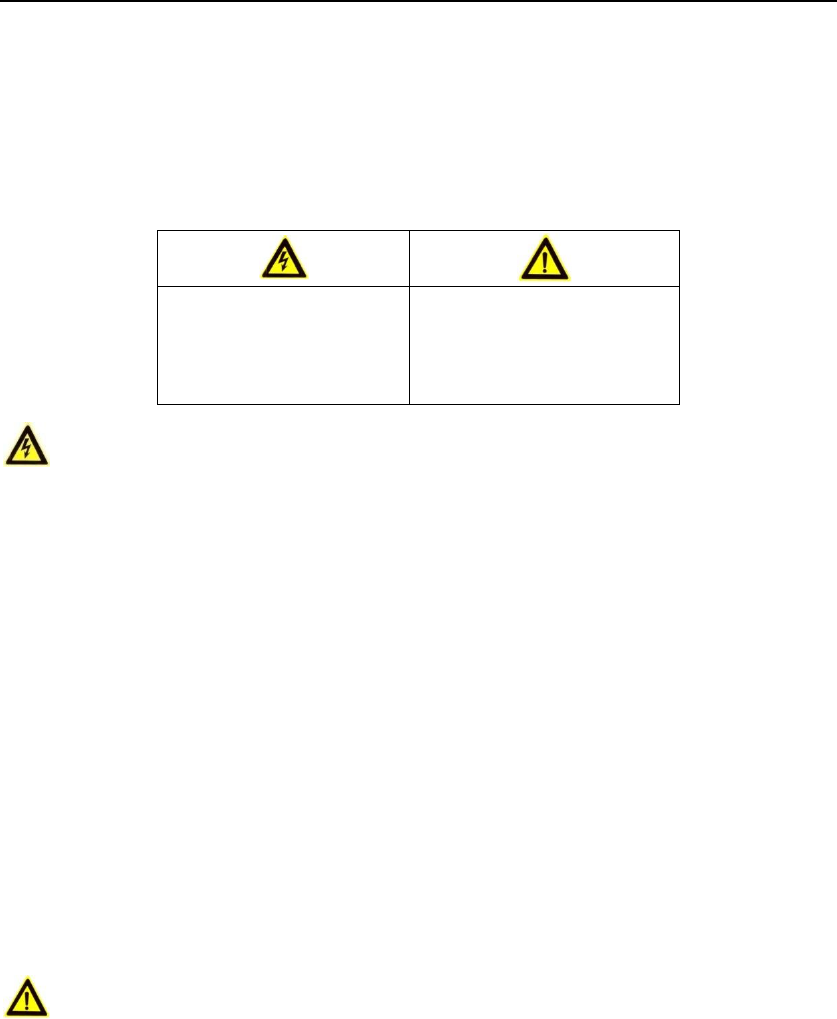
Fingerprint Time Attendance Terminal
v
Safety Instruction
These instructions are intended to ensure that user can use the product correctly to
avoid danger or property loss.
The precaution measure is divided into Warnings and Cautions:
Warnings: Neglecting any of the warnings may cause serious injury or death.
Cautions: Neglecting any of the cautions may cause injury or equipment damage.
Warnings
All the electronic operation should be strictly compliance with the electrical safety
regulations, fire prevention regulations and other related regulations in your local
region.
Please use the power adapter, which is provided by normal company. The power
consumption cannot be less than the required value.
Do not connect several devices to one power adapter as adapter overload may
cause over-heat or fire hazard.
Please make sure that the power has been disconnected before you wire, install or
dismantle the device.
When the product is installed on wall or ceiling, the device shall be firmly fixed.
If smoke, odors or noise rise from the device, turn off the power at once and
unplug the power cable, and then please contact the service center.
If the product does not work properly, please contact your dealer or the nearest
service center. Never attempt to disassemble the device yourself. (We shall not
assume any responsibility for problems caused by unauthorized repair or
maintenance.)
Cautions
Do not drop the device or subject it to physical shock, and do not expose it to high
electromagnetism radiation. Avoid the equipment installation on vibrations surface
or places subject to shock (ignorance can cause equipment damage).
Do not place the device in extremely hot (refer to the specification of the device
for the detailed operating temperature), cold, dusty or damp locations, and do not
expose it to high electromagnetic radiation.
The device cover for indoor use shall be kept from rain and moisture.
Exposing the equipment to direct sun light, low ventilation or heat source such as
heater or radiator is forbidden (ignorance can cause fire danger).
Do not aim the device at the sun or extra bright places. A blooming or smear may
occur otherwise (which is not a malfunction however), and affecting the endurance
of sensor at the same time.
Warnings Follow these
safeguards to prevent
serious injury or death.
Cautions Follow these
precautions to prevent
potential injury or
material damage.

Fingerprint Time Attendance Terminal
vi
Please use the provided glove when open up the device cover, avoid direct contact
with the device cover, because the acidic sweat of the fingers may erode the
surface coating of the device cover.
Please use a soft and dry cloth when clean inside and outside surfaces of the
device cover, do not use alkaline detergents.
Please keep all wrappers after unpack them for future use. In case of any failure
occurred, you need to return the device to the factory with the original wrapper.
Transportation without the original wrapper may result in damage on the device
and lead to additional costs.
Improper use or replacement of the battery may result in hazard of explosion.
Replace with the same or equivalent type only. Dispose of used batteries according
to the instructions provided by the battery manufacturer.

Fingerprint Time Attendance Terminal
1
Contents
Chapter 1 Overview ........................................................................................... 3
1.1 Introduction ....................................................................................................... 3
1.2 Main Features .................................................................................................... 3
1.3 Appearance ........................................................................................................ 4
1.4 Keypad Description ............................................................................................ 5
Chapter 2 Installation ........................................................................................ 6
2.1 Wall Mounting.................................................................................................... 6
2.2 Wall Mounting with Mounting Plate ................................................................. 7
Chapter 3 Basic Operation ................................................................................. 8
3.1 Device Activation ............................................................................................... 8
3.1.1 Activating via SADP Software ....................................................................... 9
3.1.2 Activating via Client Software .................................................................... 10
3.2 Login ................................................................................................................. 13
3.3 Parameters Configuration ................................................................................ 13
3.3.1 Communication Settings ............................................................................ 13
3.3.2 System Settings .......................................................................................... 15
3.3.3 Setting Time ............................................................................................... 20
3.4 User Management ........................................................................................... 20
3.4.1 Adding User ................................................................................................ 21
3.4.2 Managing the User ..................................................................................... 24
3.5 Department Management ............................................................................... 25
3.5.1 Editing and Resetting the Department ...................................................... 25
3.5.2 Searching the Department ......................................................................... 26
3.5.3 Resetting the Department ......................................................................... 27
3.6 Shift Management ........................................................................................... 27
3.6.1 Normal Shift ............................................................................................... 28
3.6.2 Man-Hour Shift .......................................................................................... 29
3.7 Holiday Management ....................................................................................... 31
3.7.1 Adding the Holiday ..................................................................................... 31
3.7.2 Searching the Holiday ................................................................................ 31
3.7.3 Editing and Deleting the Holiday ............................................................... 31
3.8 Shift Schedule Management ............................................................................ 32
3.8.1 Scheduling Shift by Department ................................................................ 32
3.8.2 Scheduling Shift by Individual .................................................................... 34
3.9 Other Management ......................................................................................... 36
3.9.1 Report Management .................................................................................. 36
3.9.2 Data Transfer .............................................................................................. 38
3.9.3 Searching the Log ....................................................................................... 39
3.9.4 Testing ........................................................................................................ 40
3.9.5 System Information .................................................................................... 42
Chapter 4 Client Operation ............................................................................... 44
4.1 Overview of Access Control System ................................................................. 44
4.1.1 Description ................................................................................................. 44
4.1.2 Configuration Flow ..................................................................................... 44
4.2 Device Management ........................................................................................ 45

Fingerprint Time Attendance Terminal
2
4.2.1 Controller Management............................................................................. 45
4.2.2 Access Control Point Management ............................................................ 60
4.3 Permission Management ................................................................................. 62
4.3.1 Person Management .................................................................................. 62
4.3.2 Card Management ..................................................................................... 65
4.3.3 Schedule Template ..................................................................................... 68
4.3.4 Door Status Management .......................................................................... 72
4.3.5 Interact Configuration ................................................................................ 74
4.3.6 Access Permission Configuration ............................................................... 77
4.3.7 Advanced Functions ................................................................................... 82
4.4 Attendance Management ................................................................................ 86
4.4.1 Shift Group Management .......................................................................... 86
4.4.2 Shift Management ..................................................................................... 88
4.4.3 Holiday Management ................................................................................. 91
4.4.4 Shift Schedule Management ...................................................................... 92
4.4.5 Attendance Check Point Management ...................................................... 93
4.4.6 Adjustment Management .......................................................................... 94
4.4.7 Card Swiping Log Query ............................................................................. 99
4.4.8 Statistic Analysis ......................................................................................... 99
4.4.9 Parameters Configuration ........................................................................ 101
4.4.10 Data Management ................................................................................ 101
4.5 Checking Status and Event ............................................................................. 102
4.5.1 Status Monitor ......................................................................................... 102
4.5.2 Access Control Event ................................................................................ 104
4.5.3 Event Search ............................................................................................. 104
4.6 System Maintenance ...................................................................................... 105
4.6.1 Log Management ..................................................................................... 105
4.6.2 System Configuration ............................................................................... 108
Chapter 5 Appendix ........................................................................................ 112
5.1 Tips for Scanning Fingerprint ......................................................................... 112
5.2 Attendance Record Delete Rule ..................................................................... 113
5.2.1 Enabling Record Delete ............................................................................ 113
5.2.2 Disabling Record Delete ........................................................................... 113
5.3 Attendance Performance ............................................................................... 114
5.4 Attendance Report Table ............................................................................... 115
5.4.1 Description of Attendance Report File Name .......................................... 115
5.4.2 Attendance Report Table Description ...................................................... 116
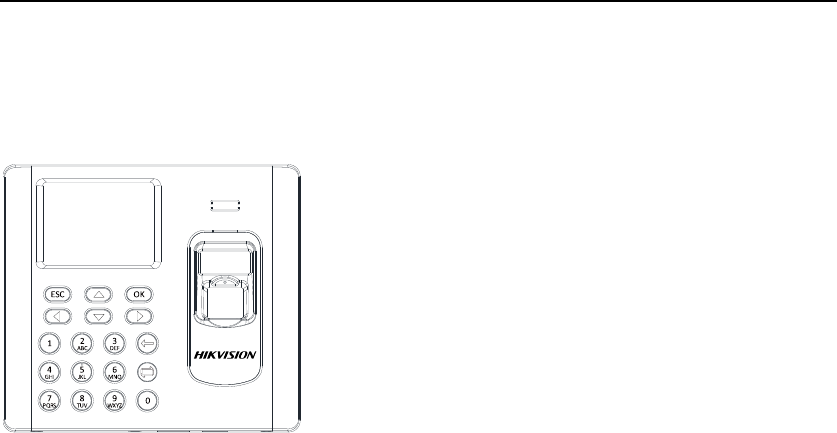
Fingerprint Time Attendance Terminal
3
Chapter 1 Overview
1.1 Introduction
DS-K1A801 Series Fingerprint Time Attendance
Terminal is designed with a 2.8-inch LCD display
screen. It supports swiping card or scanning
fingerprint for attendance, generating the
attendance report automatically. Offline operation,
wired network (TCP/IP) and wireless network
transmission modes are supported as well.
1.2 Main Features
2.8-inch LCD display screen
Transmission modes of wired network (TCP/IP) and wireless network
Max. 3,000 users, 3,000 fingerprints and 100,000 access control events
records storage
Configure attendance type by device or by person
Locally add the user information (User Name, Card No., Fingerprint, etc.), and
configure the shift, shift schedule and the attendance rule
Max. 32 normal shifts, 32 man-hour shifts and 32 holiday schedules
Set the shift schedule by department or by person
Generate the attendance report automatically via the device and the client
software
Export the report and upgrade the device via the USB disk.
Inputting Chinese characters, upper-case and lower-case letters, numbers and
symbols is available
Hint for full report memory
Authenticate via ID No. + password, card or fingerprint for the admin
Different authentication types according to different device models:
1. Fingerprint (DS-K1A801F)
2. EM card reading and fingerprint (DS-K1A801EF)
3. Mifare card reading and fingerprint (DS-K1A801MF)
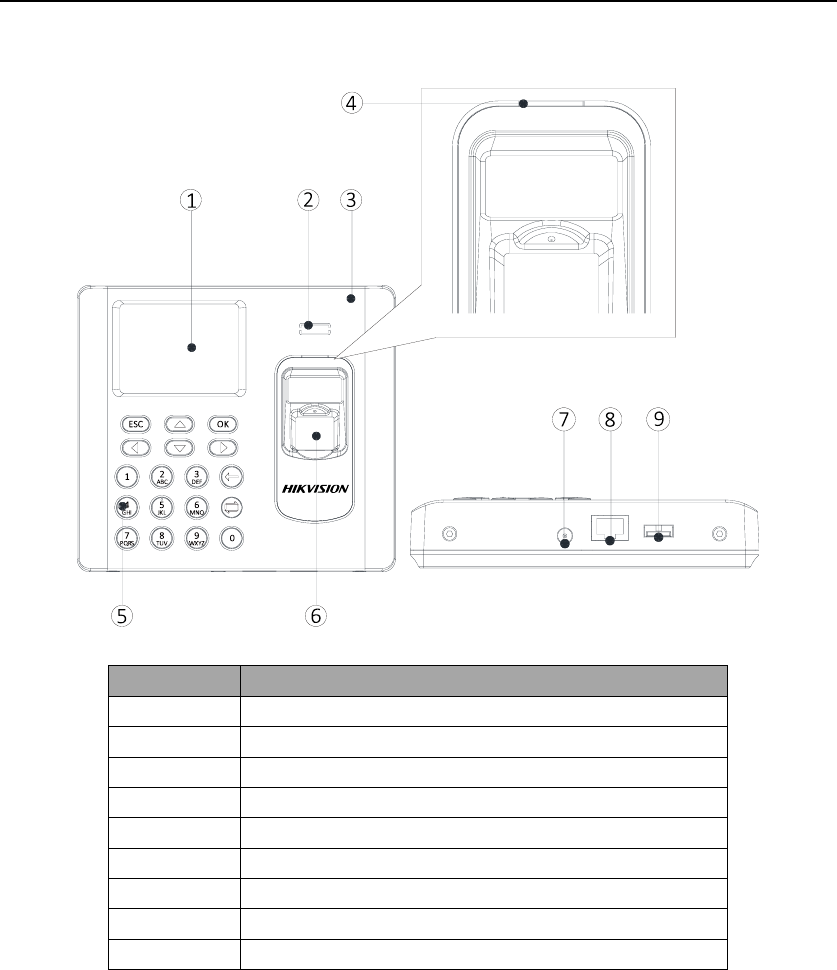
Fingerprint Time Attendance Terminal
4
1.3 Appearance
Description of DS-K1A801 Series Model Table 1. 1
No.
Description
1
2.8-inch LCD Display Screen
2
Loudspeaker
3
Front Cover
4
Indicator
5
Keypad
6
Fingerprint Reading Module
7
12V Power Interface
8
Ethernet Port
9
USB Interface
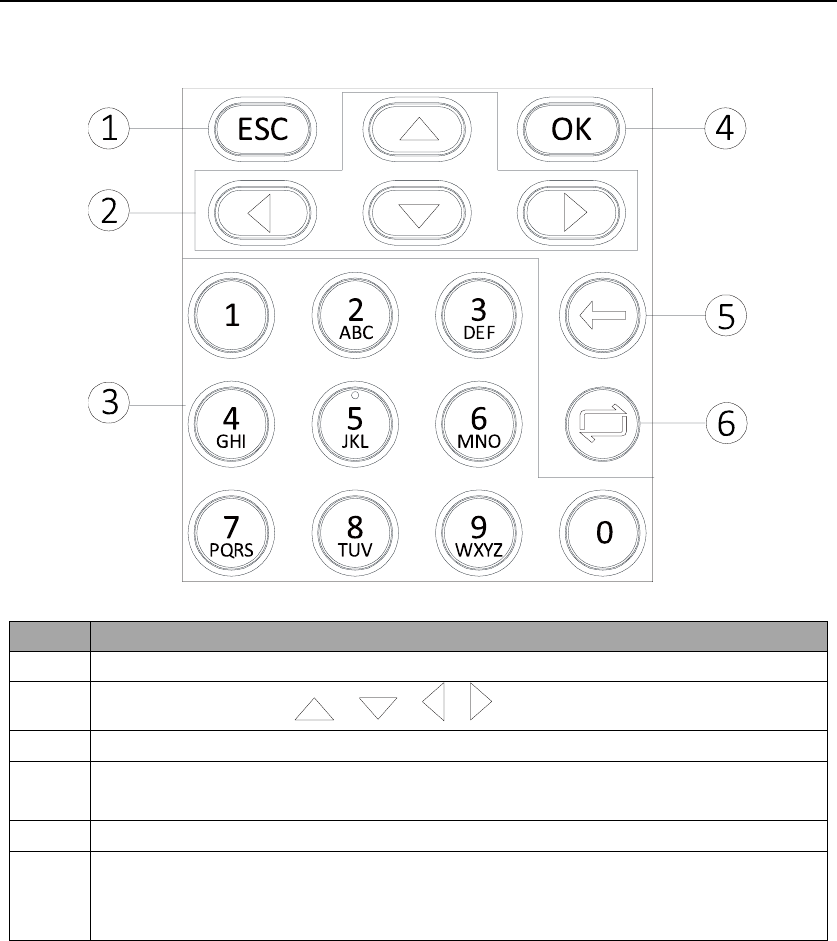
Fingerprint Time Attendance Terminal
5
1.4 Keypad Description
Keypad Description Table 1. 2
No.
Description
1
Exiting Key: Press the button to exit the menu.
2
Direction Keys: Use , , , to move the cursor in the menu.
3
Numeric Keys/Letter Keys: Press to input numbers or letters.
4
Confirming Key: Press to confirm operations. Press and hold the key for
3s to login the main interface.
5
Deleting Key: Delete the contents in the textbox.
6
Editing Key: Press to enter the editing status.
Press to shift among Chinese, numbers/lowercases, numbers/uppercases
and symbols.
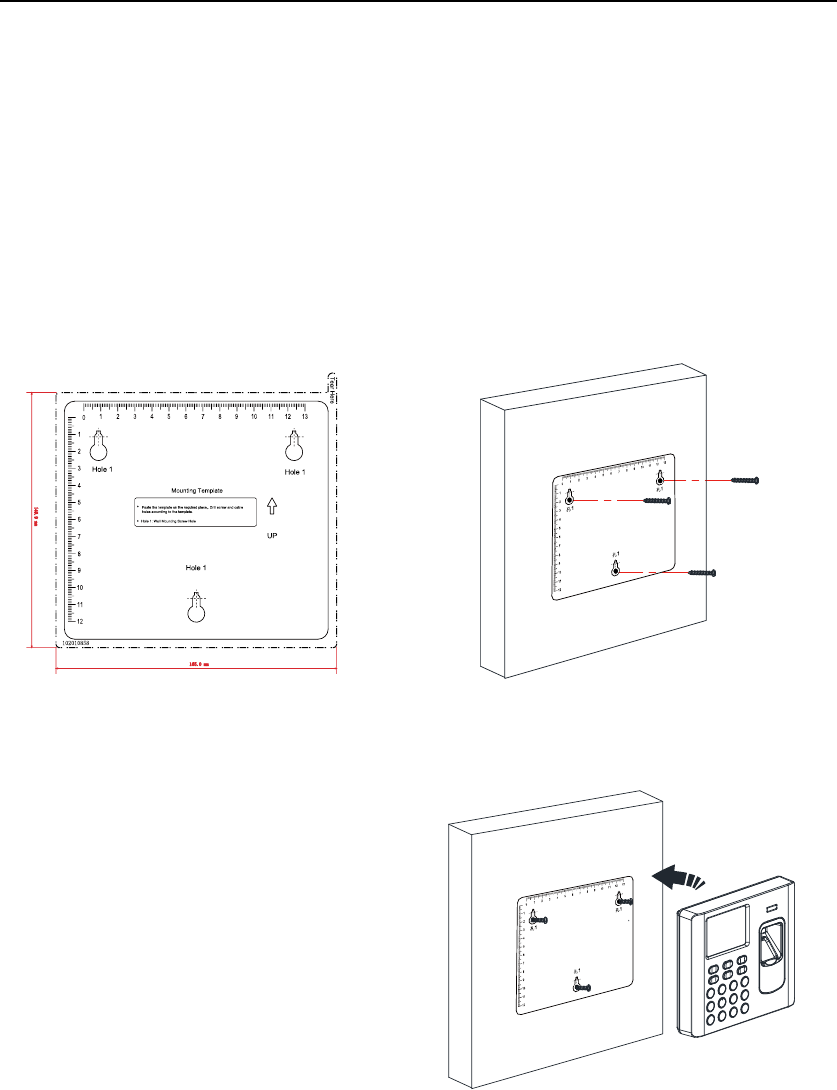
Fingerprint Time Attendance Terminal
6
Chapter 2 Installation
2.1 Wall Mounting
Steps:
1. Drill holes on the wall or other places according to the mounting template
(supplied).
Note: The minimum bearing weight of the wall or other places should be three
times heavier than the device weight.
2. Insert the screw sockets of the setscrews in the drilled holes.
3. Fix and fasten the screws in the sockets on the wall or other places.
4. Align the three holes on the device
plate with the fixed screws and hang
the device on the wall.
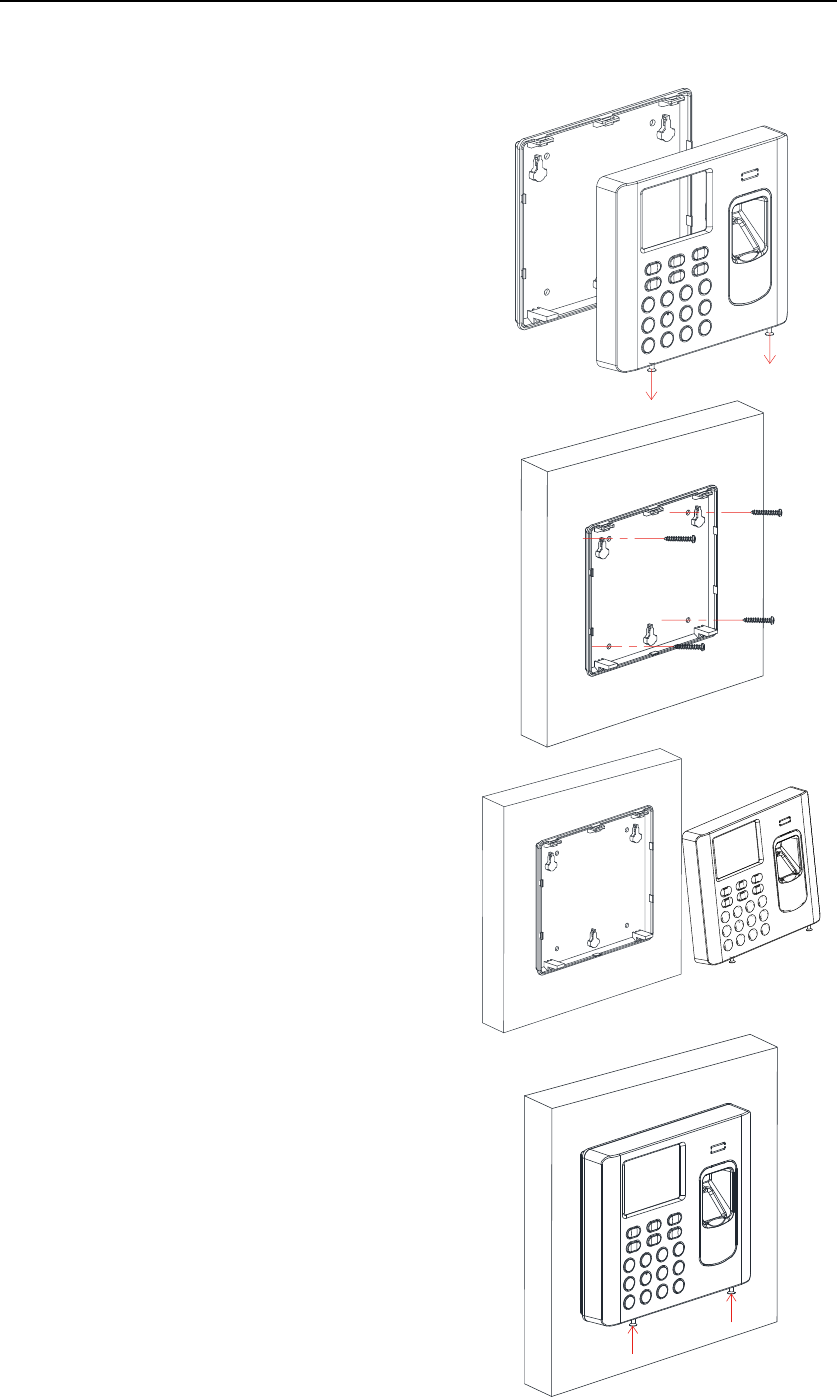
Fingerprint Time Attendance Terminal
7
2.2 Wall Mounting with Mounting Plate
Steps:
1. Remove the two screws at the bottom of
the front cover and remove the back
cover.
2. Align the back cover on the level on the
wall or other places.
3. Drill through the holes at the four corners
of the back cover.
4. Insert the screw sockets of the setscrews
in the drilled holes.
5. Fasten the screws in the sockets to fix the
back cover on the wall or other places.
6. Align the front cover to the back cover and
buckle them together.
7. Fix and fasten the screws at the bottom of
the front cover.
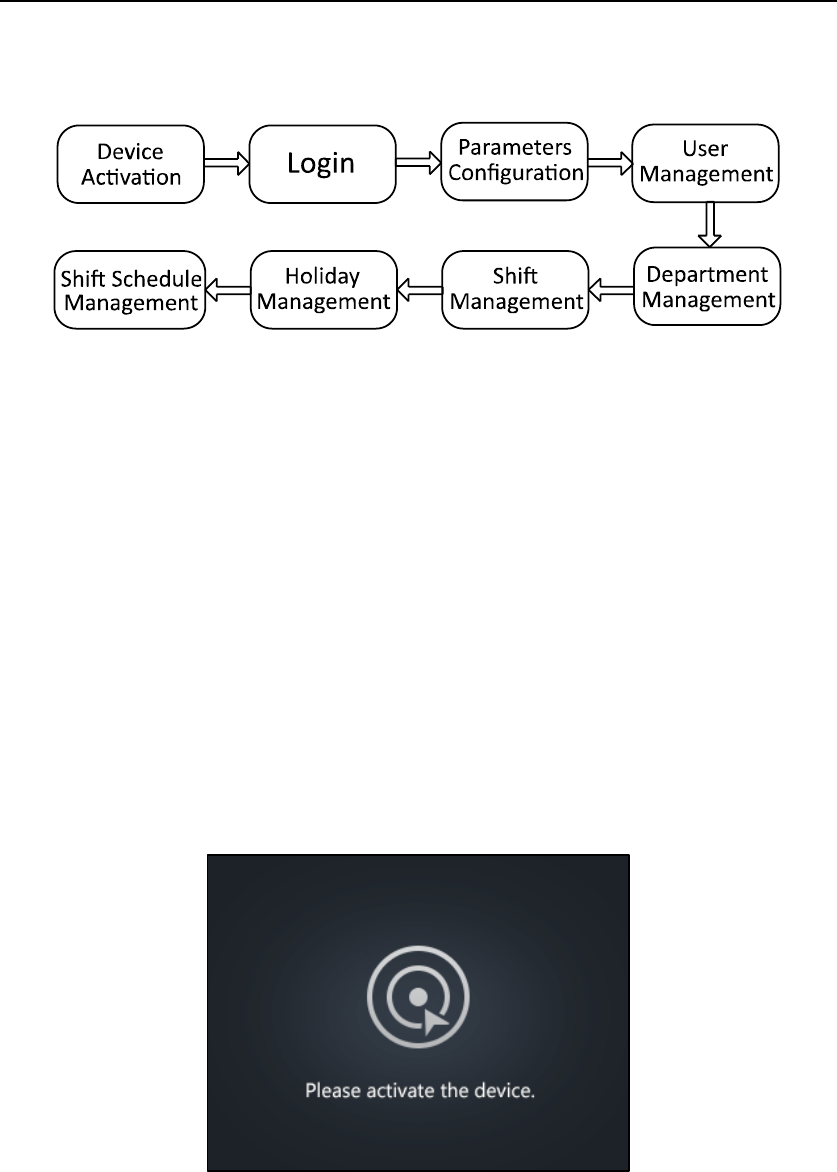
Fingerprint Time Attendance Terminal
8
Chapter 3 Basic Operation
The suggested working flow is as follows:
Device Activation: Activate the device before first using.
Login: Hold the OK key for 3s to login the device main interface.
Parameters Configuration: Configure the communication, the system, and the time.
User Management: Add, edit and delete the users.
Department Management: Edit the default department.
Shift Management: Configure the normal shift and the man-hour shift.
Holiday Management: Configure the holiday.
Shift Schedule Management: Schedule by department or by individual.
Note: The device has configured the default department, the default shift, the
default shift schedule and the default system information. You are able to use the
device directly after adding the user.
3.1 Device Activation
Purpose:
You should activate the device before the first login. After powering on, the system
will switch to activate notifying interface.
Activation via SADP and activation via the iVMS-4200 Client Software are supported.
The default values of the terminal are as follows:
The default IP address: 192.0.0.64
The default port No.: 8000
The default user name: admin
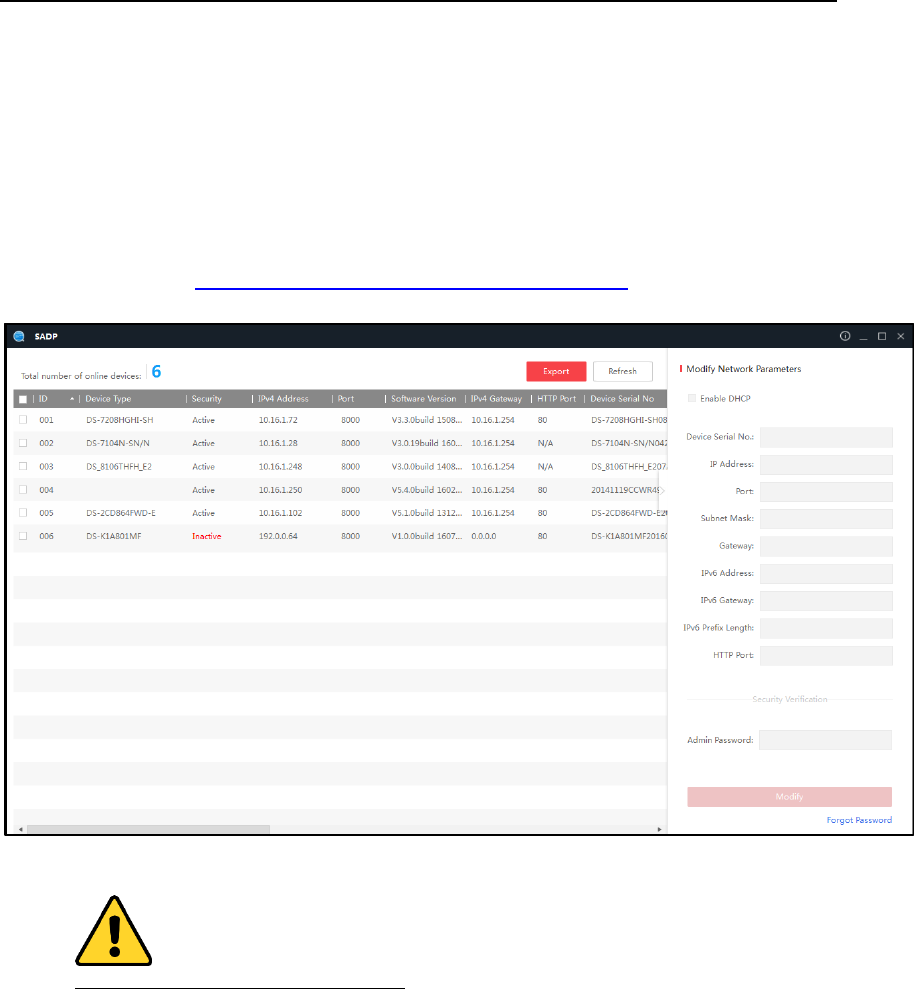
Fingerprint Time Attendance Terminal
9
3.1.1 Activating via SADP Software
Purpose:
SADP software is used for detecting the online device, activating the device, and
resetting the device password.
Steps:
1. Get the SADP software from the supplied disk or the official website. Install
and run the software.
Note: Go to http://www.hikvision.com/en/tools_82.html to download the
SADP software.
2. Check the inactive device from the device list.
3. Create a password in the right side of the interface and confirm the password.
STRONG PASSWORD RECOMMENDED– We highly recommend you create a strong
password of your own choosing (using a minimum of 8 characters, including upper case
letters, lower case letters, numbers, and special characters) in order to increase the
security of your product. And we recommend you reset your password regularly,
especially in the high security system, resetting the password monthly or weekly can
better protect your product.
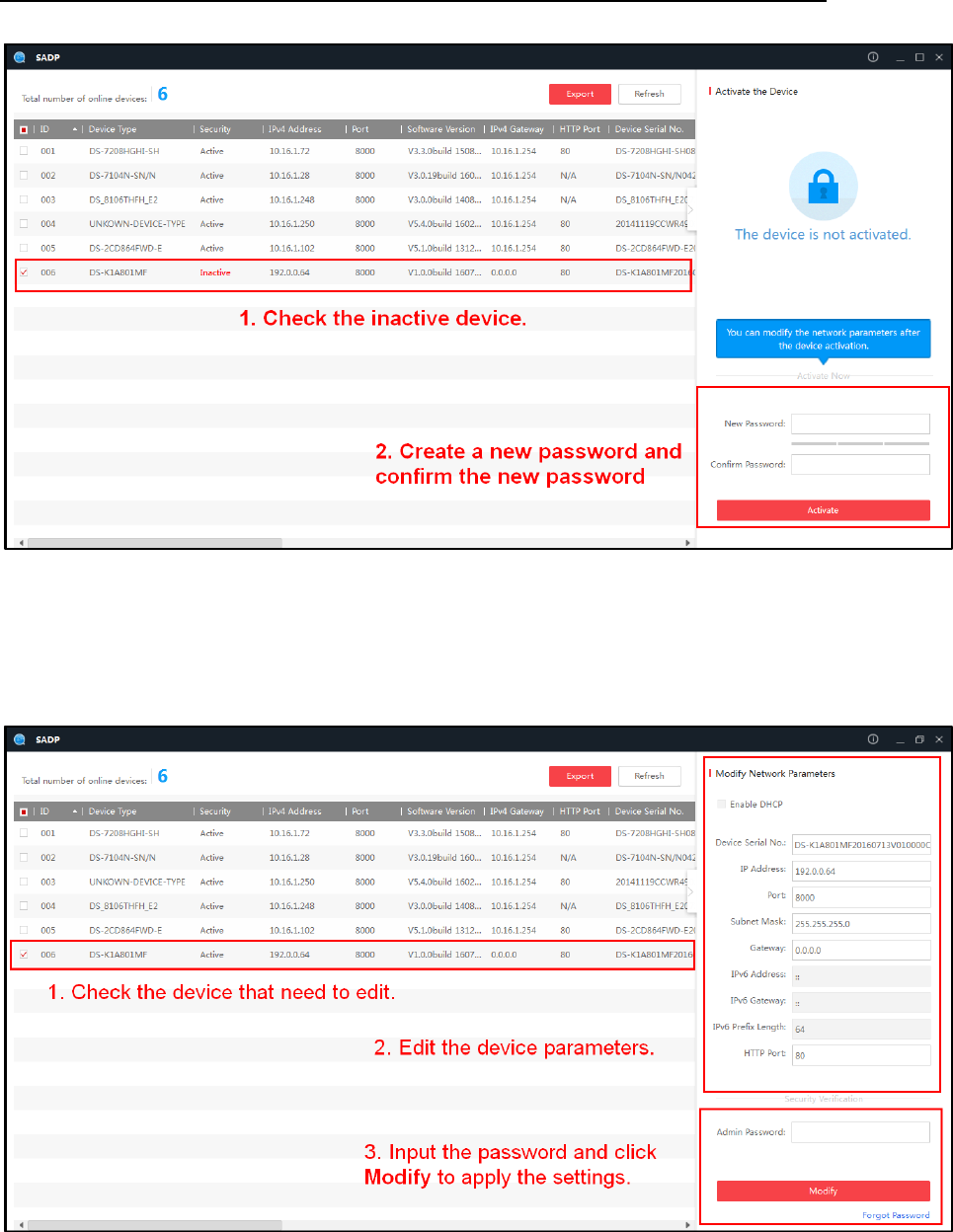
Fingerprint Time Attendance Terminal
10
4. Click Activate. The device will be active.
Or click Fresh to fresh the device status.
5. Check the device and manually edit the device IP address, Port No., Subnet
Mask, Gateway, etc. Or check DHCP to enable DHCP.
6. Input the password and click Modify to apply the settings.
Note: The device IP address should be the same with the PC’s.
3.1.2 Activating via Client Software
Purpose:
The client software is versatile video management software for multiple kinds of
devices.
Steps:
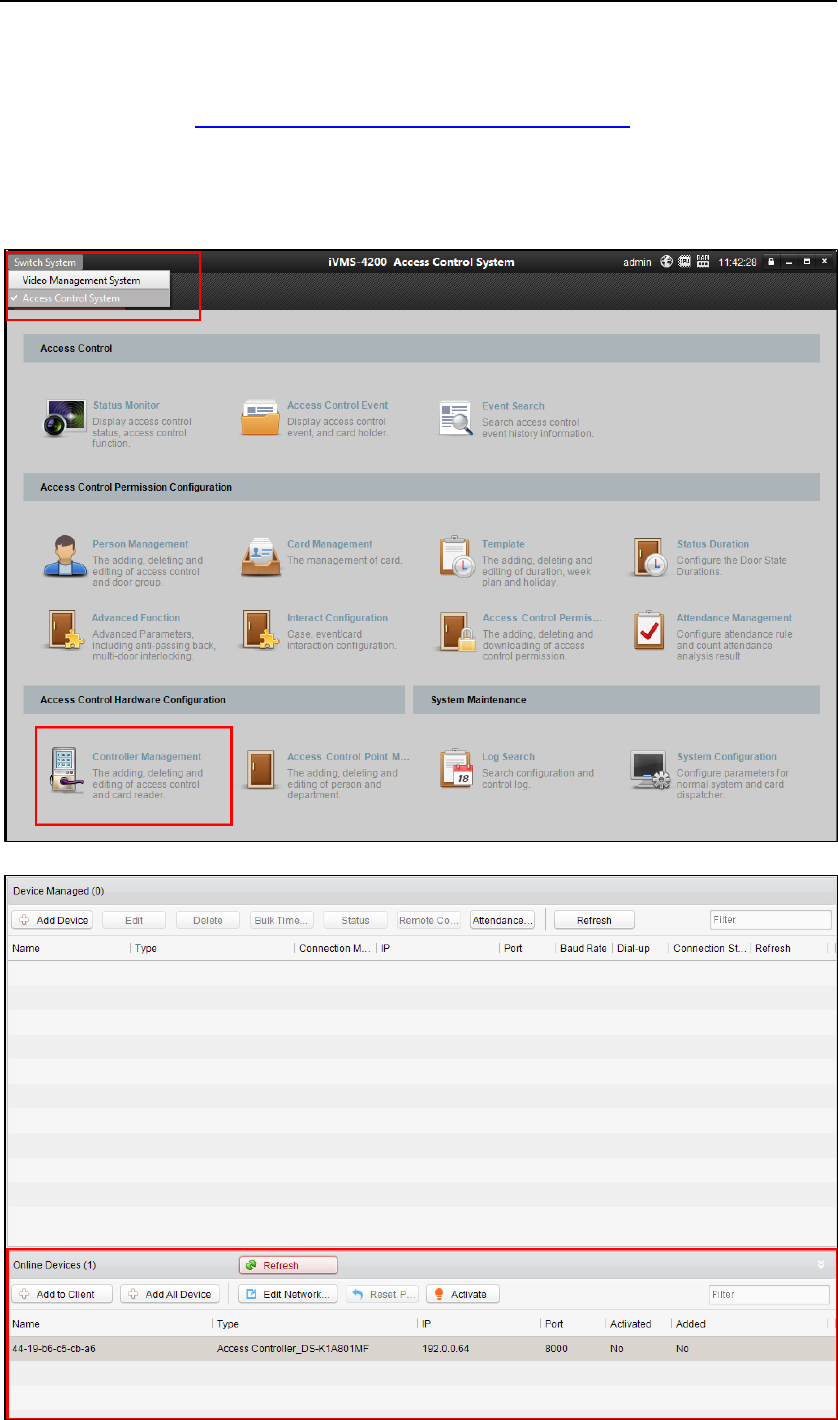
Fingerprint Time Attendance Terminal
11
1. Get the client software from the supplied disk or the official website. Install
and run the client software.
Note: Go to http://www.hikvision.com/en/Tools_84.html to download the
client software.
2. Click Switch System -> Access Control System at the upper left corner of the
interface to enter the Access Control System interface.
3. Click Controller Management to enter the Controller Management interface.
You can check the online device, as shown in the figure displayed below:
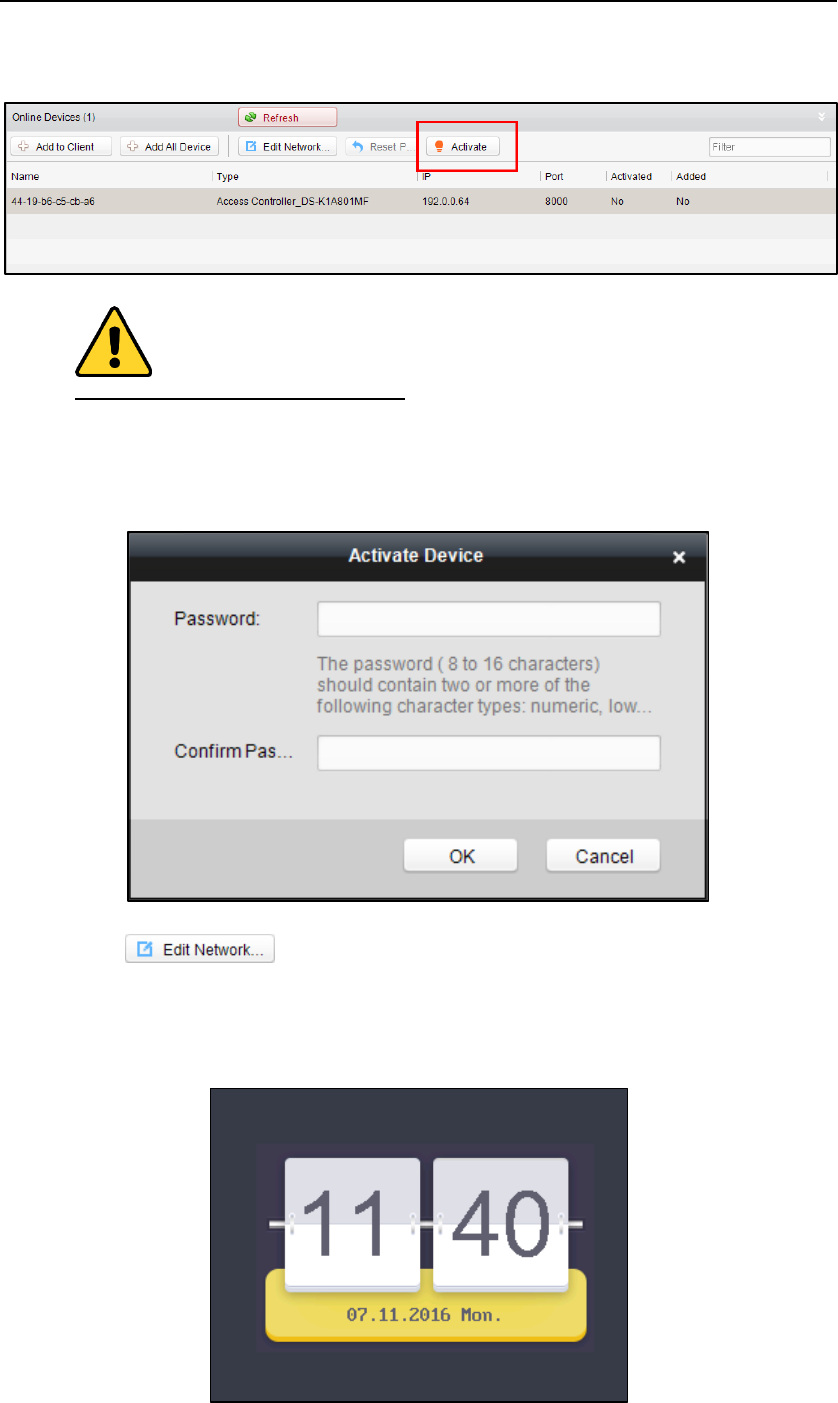
Fingerprint Time Attendance Terminal
12
4. Select an inactive device from the device list.
5. Click Activate to pop up the Activation interface.
6. Create a password and confirm the new password.
STRONG PASSWORD RECOMMENDED– We highly recommend you create a strong
password of your own choosing (using a minimum of 8 characters, including upper case
letters, lower case letters, numbers, and special characters) in order to increase the
security of your product. And we recommend you reset your password regularly,
especially in the high security system, resetting the password monthly or weekly can
better protect your product.
7. Click OK to start activate.
8. Click to configure the device IP address, mask address,
gateway address, port No.
9. Input the password and click OK to apply.
Note: The device IP address should be the same with the PC.
The device will switch to the initial interface:
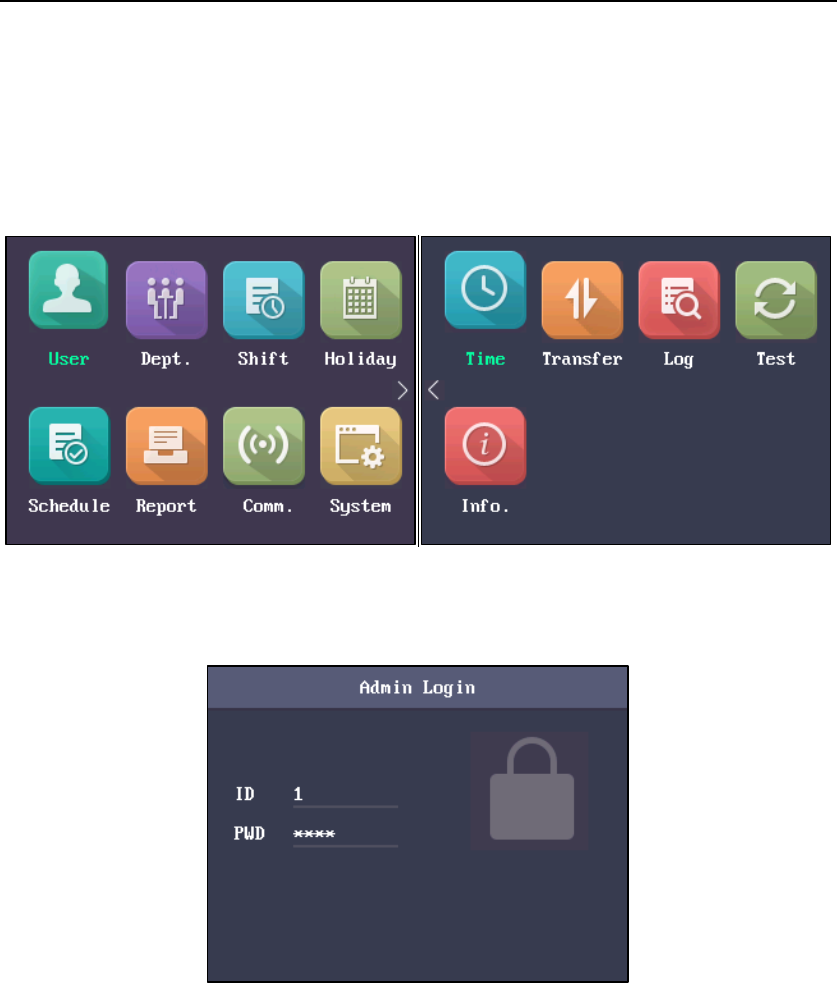
Fingerprint Time Attendance Terminal
13
3.2 Login
Steps:
1. For the first time login, long-press the OK key for 3s to enter the main
interface.
You can manage the user, the department, the shift, the holiday, the shift
schedule, the report, the communication, the system, the time, etc.
If you have configured the admin in the User interface, then
1) Long-press OK key to enter the Admin Login interface.
2) Enter the admin ID No. and password, scan the fingerprint or swipe the
card to enter the main interface.
3.3 Parameters Configuration
3.3.1 Communication Settings
Purpose:
You can set the network parameters and the Wi-Fi.
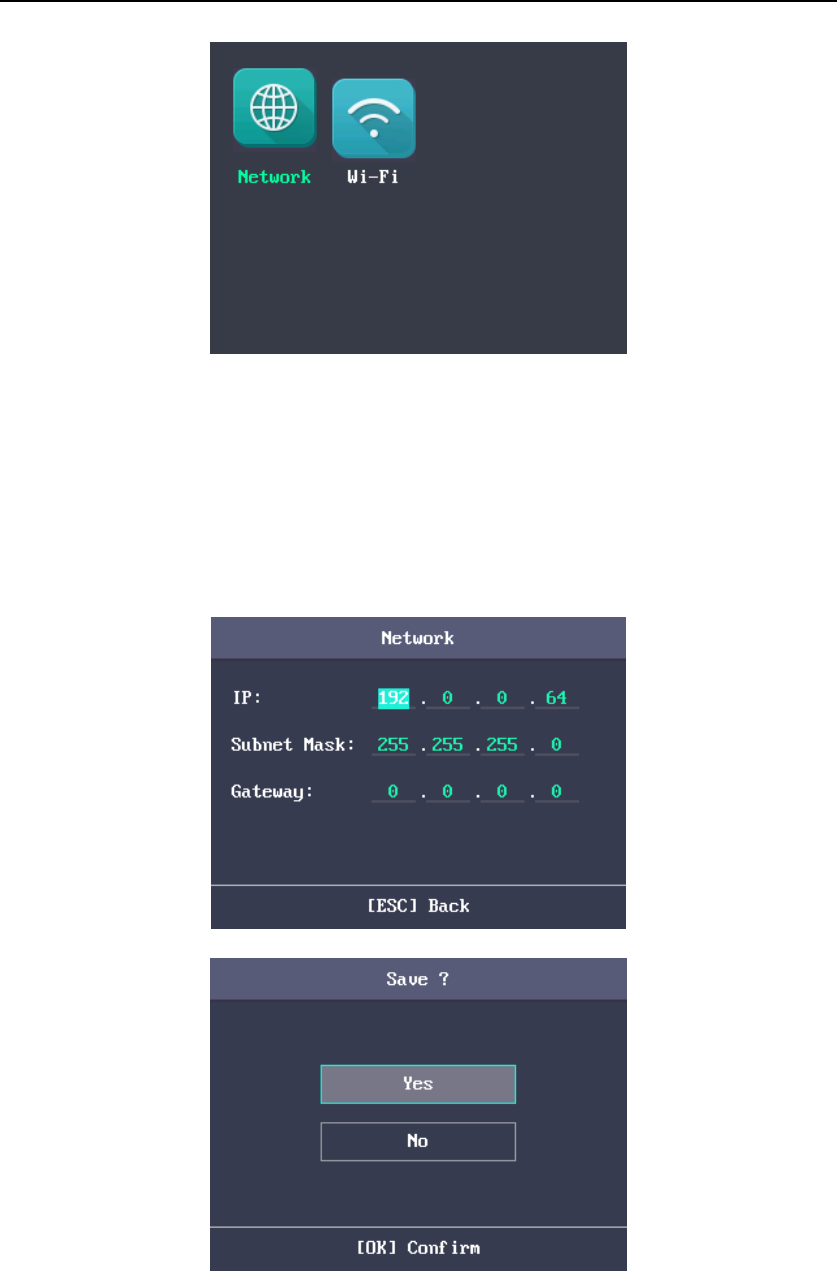
Fingerprint Time Attendance Terminal
14
Setting Network
You can set the device network parameters, including the IP address, the subnet
mask and the gateway address.
Steps:
1. Move the cursor to the Network and press the OK key to enter the Network
interface.
2. Edit the IP address, the subnet mask and the gateway.
Note: The IP address should be the same with the PC’s.
3. Press the ESC key and select Yes to save the parameters.
Setting Wi-Fi
Purpose:
You can enable the Wi-Fi and configure the Wi-Fi parameter.
Steps:
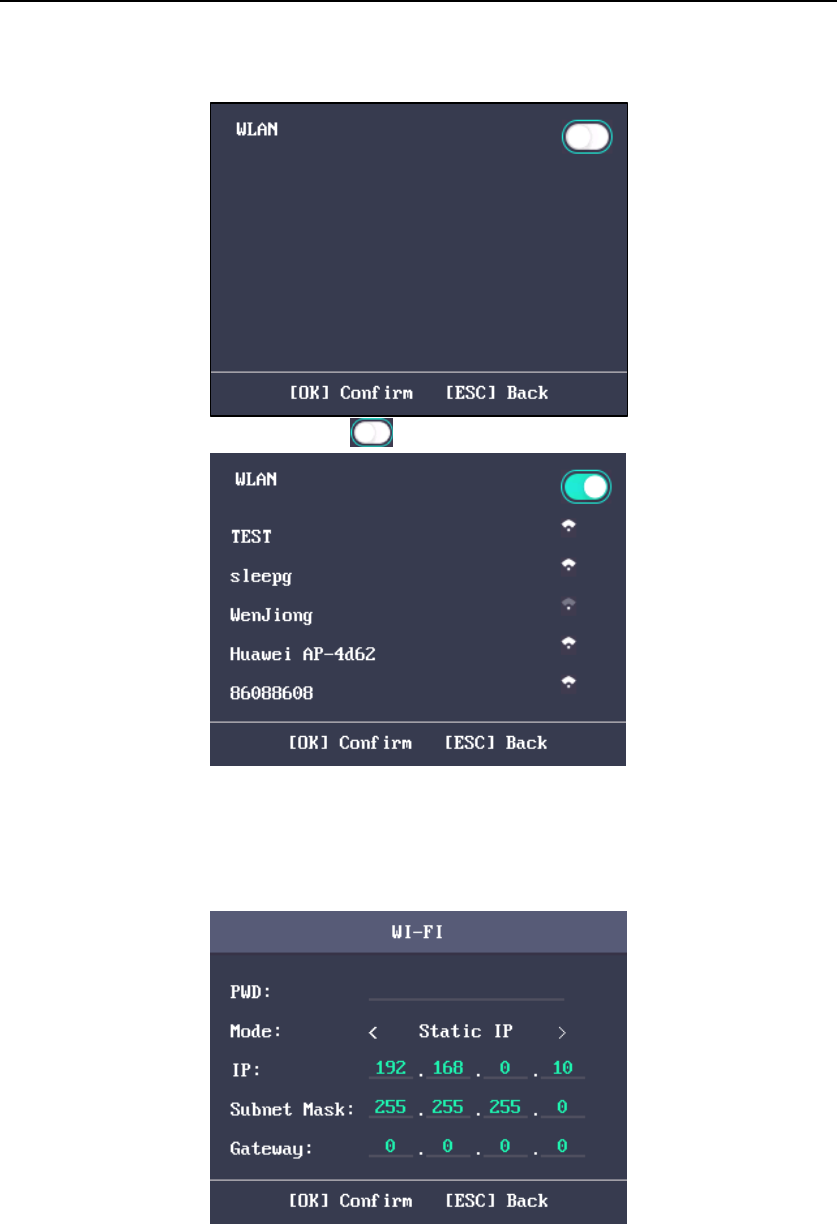
Fingerprint Time Attendance Terminal
15
1. Move the cursor to the Wi-Fi, and press the OK key to enter the Wi-Fi
interface.
2. Move the cursor to the icon and press the OK key to enable the WLAN.
3. Select a network and press the OK key to enter the Wi-Fi Setting interface.
4. Input the Wi-Fi password, and configure the IP mode the IP address, the
subnet mask and the gateway.
Note: The password supports numbers, uppercase letters, lowercase letters
and symbols.
5. Press the ESC key and select Yes to save the parameters and exit the interface.
3.3.2 System Settings
Purpose:
You are able to set the system parameters, manage the data, restore default
parameters and upgrade the device.
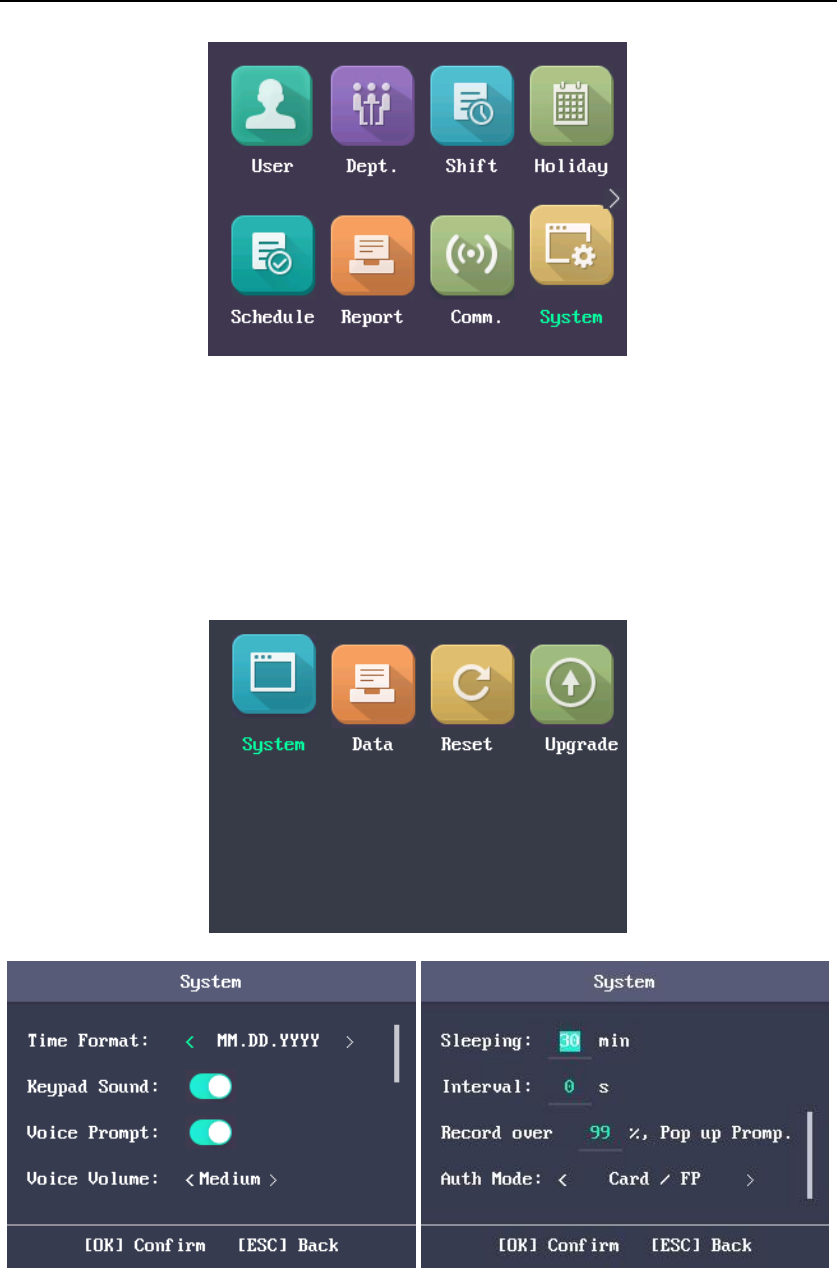
Fingerprint Time Attendance Terminal
16
Setting System Parameters
Purpose:
Set the system parameters, including the device time format, the keypad sound, the
voice prompt, the volume, the sleeping, the attendance repeating time interval, the
attendance record prompt and the authentication mode.
Steps:
1. Move the cursor to System and press the OK key to enter the System
interface.
2. Edit the parameters.
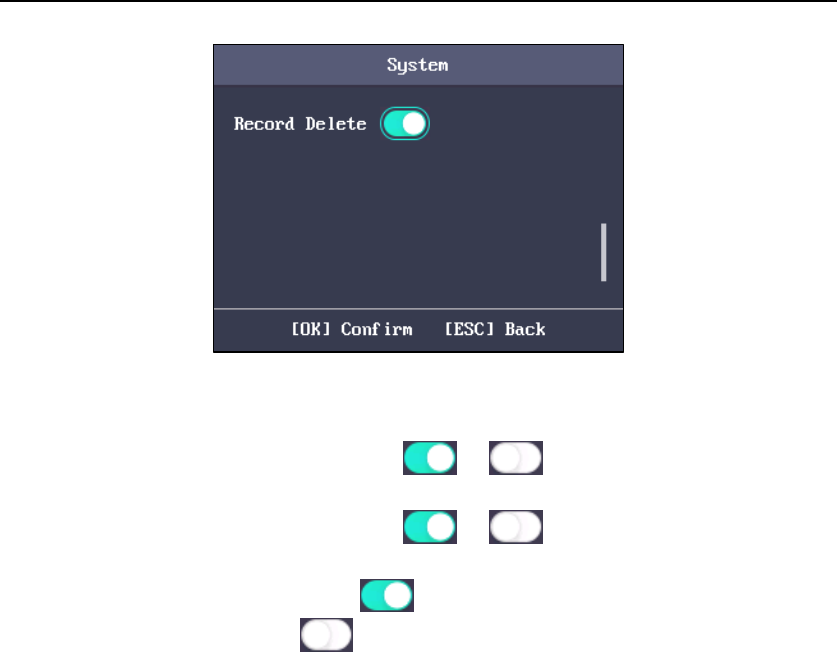
Fingerprint Time Attendance Terminal
17
Time Format:
MM/DD/YYYY, MM.DD.YYYY, DD-MM-YYYY, DD/MM/YYYY,
DD.MM.YYYY, YYYYMMDD, YYYY-MM-DD, YYYY/MM/DD,
YYYY.MM.DD and MM-DD-YYYY are available.
Keypad Sound:
Move the cursor to or and press the OK key to
enable or disable the keypad sound.
Voice Prompt:
Move the cursor to or and press the OK key to
enable or disable the prompt audio.
Note: The icon represents the keypad sound is enabled.
The icon represents the keypad sound is disabled.
Voice Volume:
High, Medium and low can be selected.
Sleeping:
Set the device sleeping waiting time (Minute). If you set the
sleeping time to 30min, the device will sleep after 30 min
without any operation.
Note: If you set the sleeping time to 0, the device will not sleep.
Interval:
Set the attendance repeating time interval (Second) of a
person. The attendance is invalid if you swipe the card
repeatedly within the time interval. (Set the authentication
mode to Card).
Note: The time interval should be between 0 and 255s.
Record over
Threshold Prompt:
If the attendance record memory reaches the configured value,
the system will pop up a prompt to remind you.
Authentication
Mode:
The authentication mode can be switched among
“card/fingerprint”, “card”, “fingerprint”, “card & password”,
“card & fingerprint”, “fingerprint & password”, “card &
fingerprint” and “password”, and “card/password (The
password here refers to the card ID No. and the user
password)”.
Record Delete:
When the function is enabled, the terminal will delete the first
3000 attendance records when the memory is full, in order to
save the new attendance records. By default, the function is
enabled. See Section 5.2 Attendance Record Delete Rule.
3. Press the ESC key and select Yes to save the settings and exit the interface.
Managing Data
Purpose:
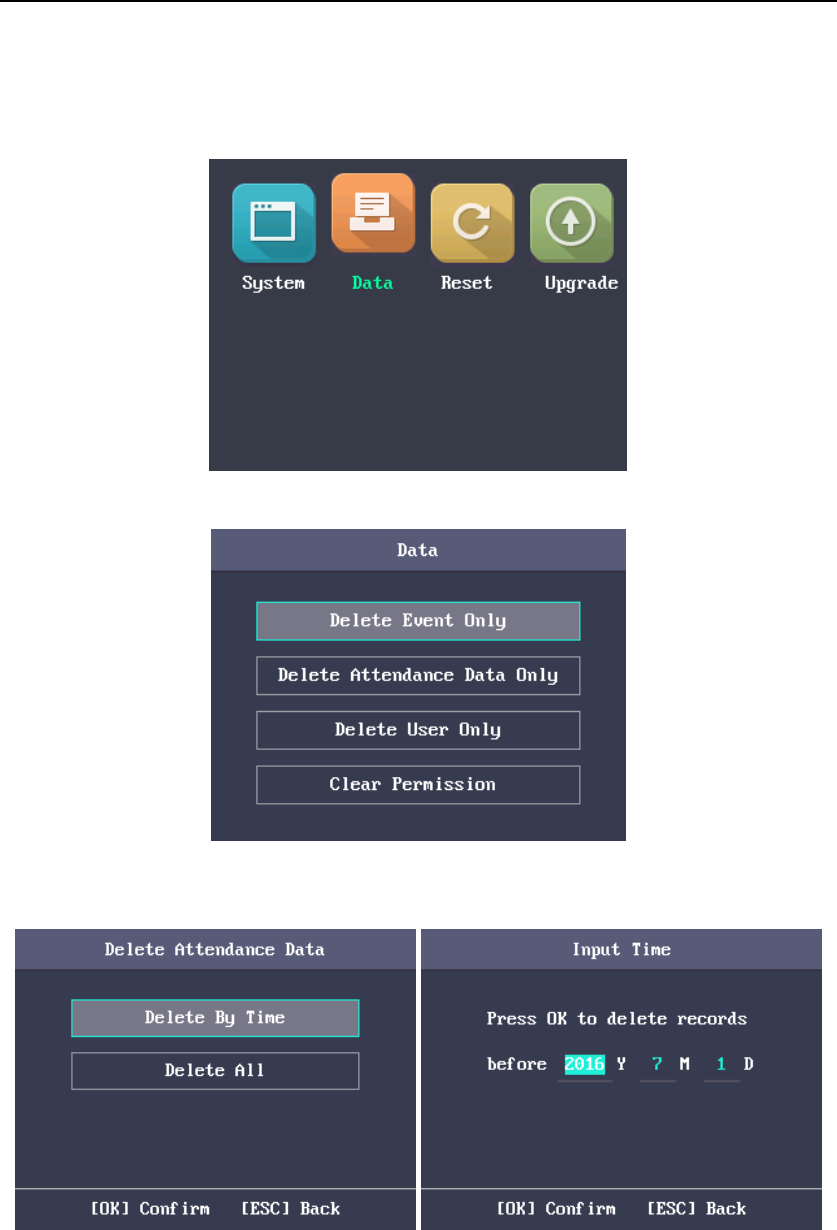
Fingerprint Time Attendance Terminal
18
You are able to delete the storage data of the device, including the event, the
attendance data, the user, and the permission.
Steps:
1. Move the cursor to Data and press the OK key to enter the Data interface.
2. Select a data type and press the OK key to delete.
Or press the ESC key to exit the interface.
Delete Event Only:
Delete all recorded events in the device.
Delete Attendance
Data Only:
Delete all attendance data in the device.
Delete Attendance Data Interface Figure 3. 1
Delete User Only:
Delete all user data in the device, including the
attendance records.
Clear Permission:
Clear the admin management permission. The admin will
turn to the normal user. The user will not be deleted.
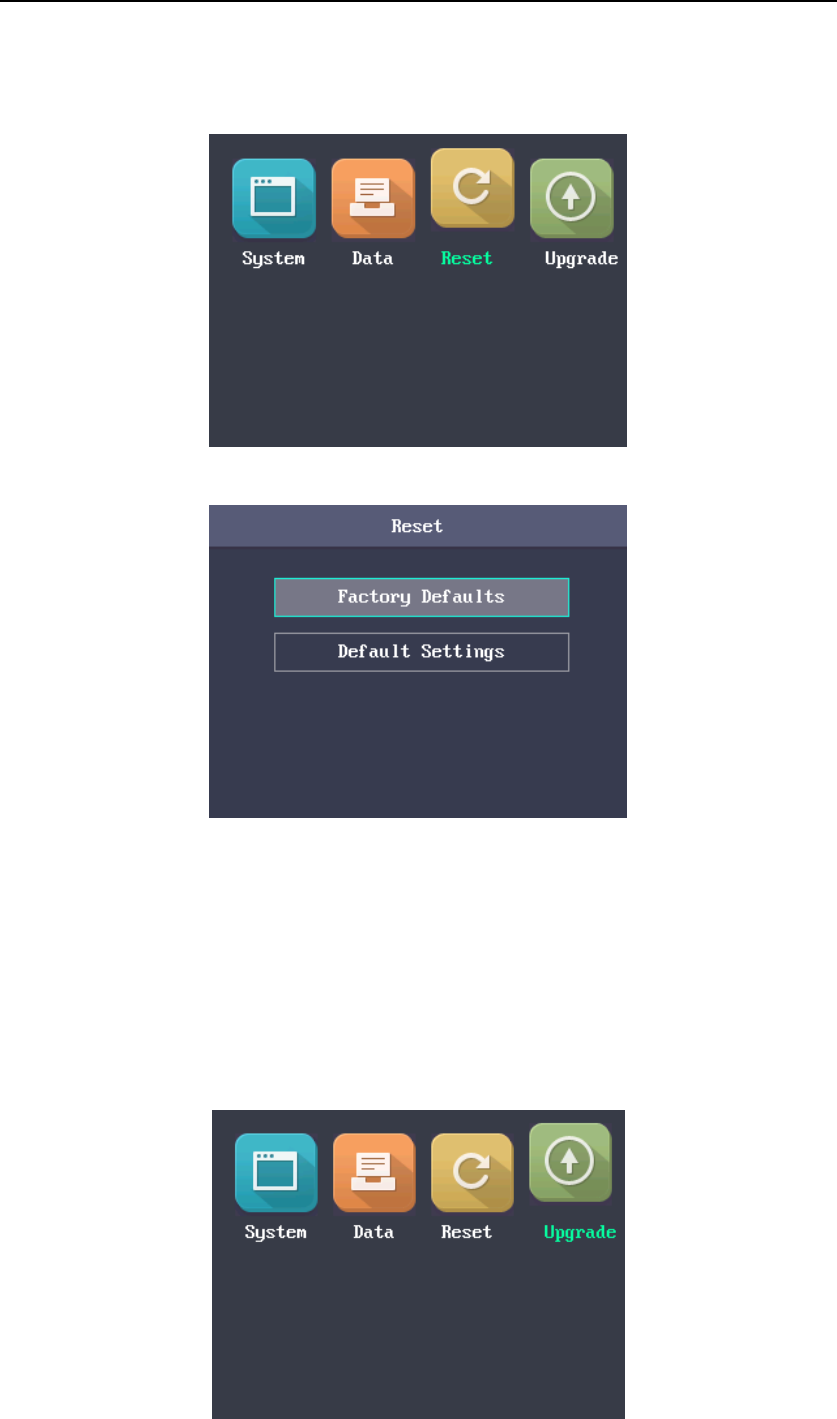
Fingerprint Time Attendance Terminal
19
Restoring Settings
Purpose:
You can restore Factory Defaults or Default Settings.
Steps:
1. Move the cursor to Reset and press the OK key to enter the Reset interface.
2. Select Factory Defaults or Default Settings.
Factory Defaults:
All parameters of the device will restore to the factory
condition.
Default Settings:
All parameters, excluding the communication
parameters and the remote user management, will
restore to the factory condition.
Upgrading Device
The system can automatically read the upgrading file from the plugged USB disk to
upgrade the device.
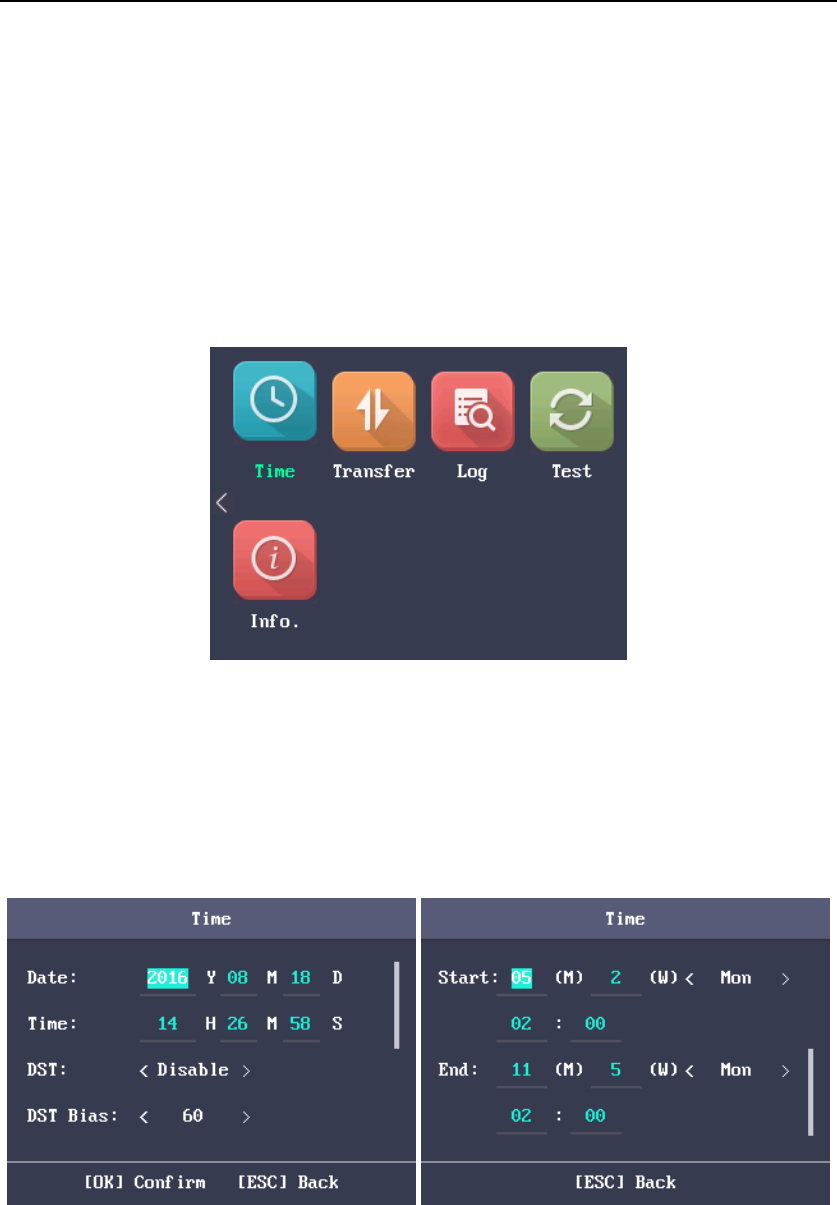
Fingerprint Time Attendance Terminal
20
Notes:
The upgrading file should be put in the root directory.
The upgrading file name in the USB disk should be digicap.dav.
3.3.3 Setting Time
Purpose:
You are able to set the device time and the DST.
Steps:
1. Move the cursor to Time in the main interface.
2. Press the OK key to enter the Time interface.
3. Edit the parameters.
Date:
The displayed date on the device.
Time:
The displayed time on the device.
DST:
Select to enable or disable the DST. When the DST is enabled, you
can set the DST bias time, the start time and the end time.
DST Bias: you can select 30min, 60min, 90min and 120min.
Start: Set the start time of the DST.
End: Set the end time of the DST.
4. Press the ESC key and select Yes to save the settings and exit the interface.
3.4 User Management
Purpose:
You are able to add, edit, delete and search the user.
Move the cursor to User in the main interface and press the OK key to enter the User
interface.
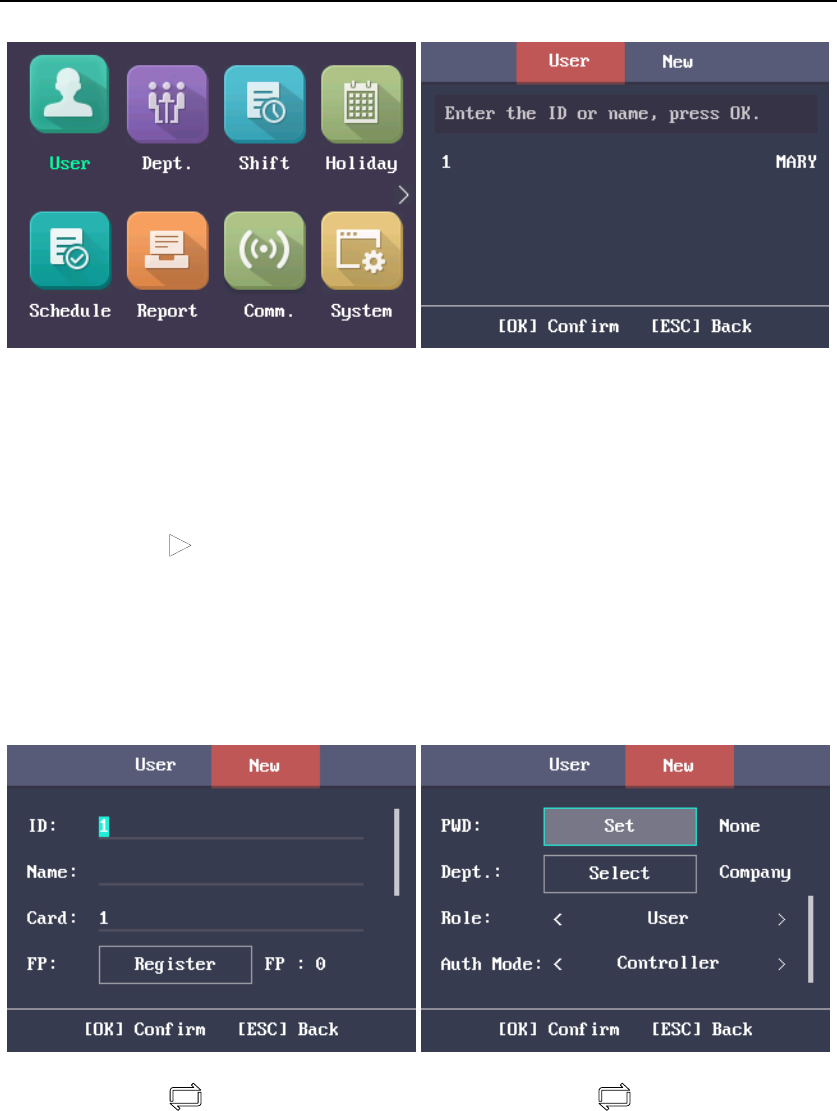
Fingerprint Time Attendance Terminal
21
3.4.1 Adding User
You can add users by editing the ID No., the user name, the card No. You can also
scan the user fingerprint, set the password, the department, the role and the
authentication mode.
Steps:
1. Press the key to enter the New (new user) interface and input the ID No.
Notes:
The ID No. refers to the user attendance serial No.
The ID No. should be between 1 and 99999999 and should not start
with 0.
The ID No. can be used for once.
By default, the ID No. will be increased in sequence.
2. Enter the new user name.
1) Press key to enter the editing interface. Press key to shift input
mode. Chinese, Digits/Lowercase Letters, Digits/Uppercase Letters and
symbols are supported.
2) Enter the use name and press the OK key to confirm and exit the
interface.
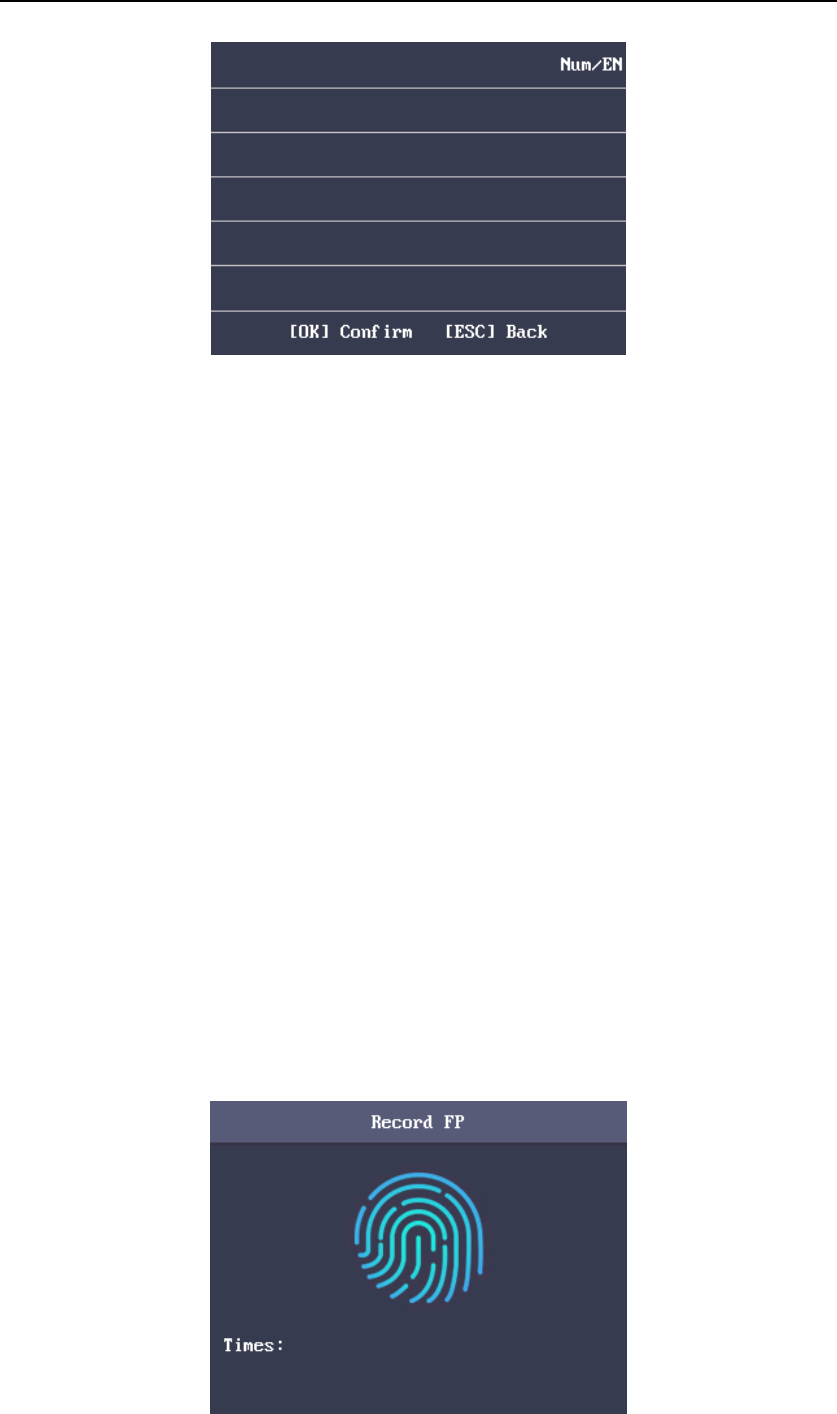
Fingerprint Time Attendance Terminal
22
Notes:
Digits, uppercase letters, lowercase letters, Chinese characters and
symbols are supported.
The user name supports up to 32 characters.
Each user name can be used for once.
3. Enter the card No.
Notes:
The card No. is required.
The card No. can start with 0 when it contains more than one
numbers. E.g. 012345.
The card No. can be used for once.
The device of DS-K1A801F model supports manually entering the card
No. The device of DS-K1A801MF and DS-K1A801EF model supports
manually entering card No. and swiping card to get the card No.
4. Move the cursor to Register and press the OK key scan the fingerprint.
Place the finger on the scanner, rise and confirm your fingerprint by following
the voice prompt.
Notes:
The same fingerprint cannot be repeatedly registered.
The same ID No. supports adding up to 10 fingerprints.
The device supports the optical fingerprint recording.
You can also scan the fingerprint via the external device and apply the
fingerprint to the device by the client software.
For detailed information about scanning the fingerprint, see Section
5.1Tips for Scanning Fingerprint.
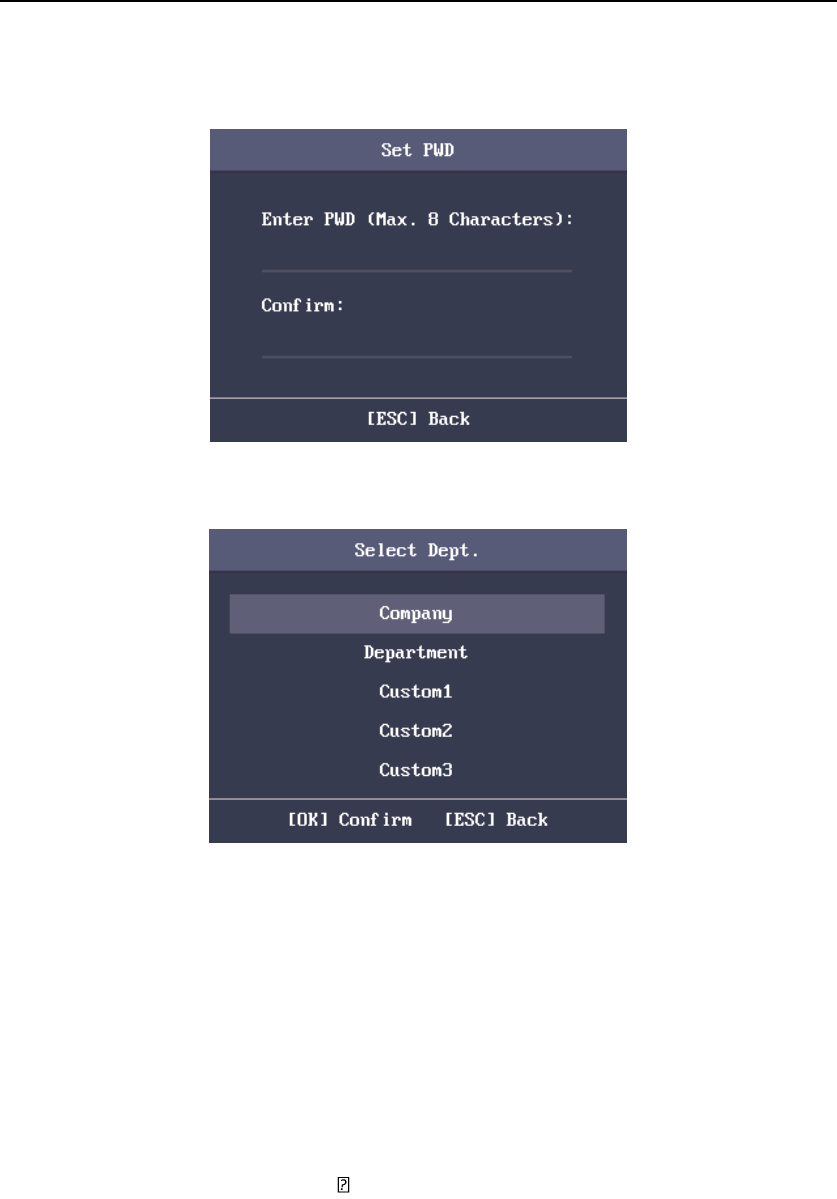
Fingerprint Time Attendance Terminal
23
5. Move the cursor to Set and press the OK key to edit the user password.
1) Enter the password and confirm the password in the Set Password
interface.
2) Press the ESC key and select Yes to save the password.
Note: Up to 8 digits can be entered.
6. Move the cursor to Select and press the OK key to select a department.
Note: For detailed information about editing the department, see Section
3.5.1 Editing and Resetting the Department.
7. Move the cursor and press the OK key to select the user role.
Admin: The admin has all permissions to operate the device.
User: The user can check attendance in the initial interface.
Notes:
All people can enter the main interface to operate if there is no Admin
configured.
After configuring the admin, you have to authorize the admin ID to
enter the main interface.
You can user the USB interface to import the user information. For
details, see Section The USB disk memory should be from 1G to 32G.
Make sure the free space of the USB disk is more than 512M.
For details about the exported tables descriptions, see Section 5.4
Attendance Report Table.
Data Transfer.
8. Move the cursor to select an authorize mode.
You can select Card/Fingerprint, Card, Fingerprint, Card &Password, Card and
Fingerprint, Fingerprint &Password, Card & Fingerprint & Password,
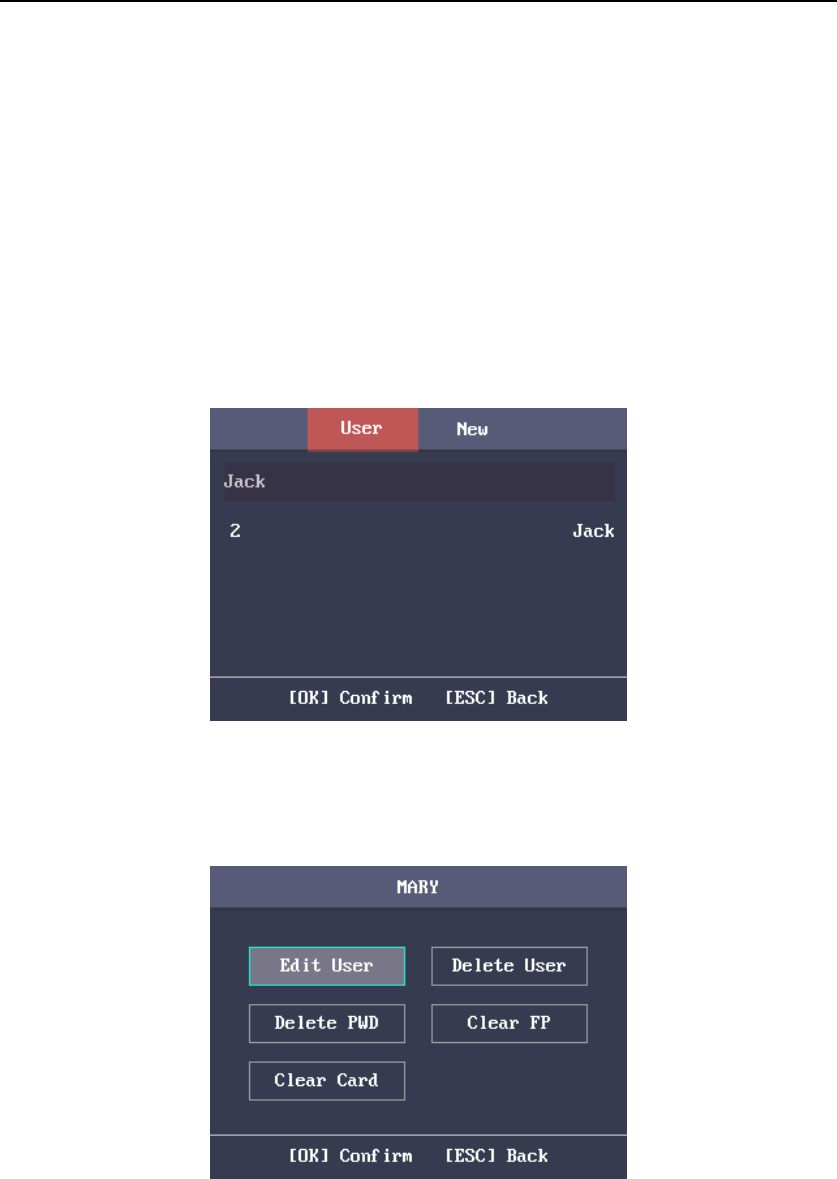
Fingerprint Time Attendance Terminal
24
Card/Password (The password here refers to the card ID No. and the user
password), and Controller.
9. Press the ESC key and select Yes to save the settings and exit the interface.
3.4.2 Managing the User
Searching the User
Purpose:
Enter the user ID No. or the user name to search the target user.
Steps:
1. Enter the user ID or the user name in the searching bar of the user list
interface,
2. Press the OK key to search.
Editing the User
Steps:
1. Select a target user in the user list and press the OK key.
2. Select Edit User in the User Configuration interface.
3. Follow Section 3.4.1 Adding User to edit the user information.
4. Press the ESC key and select Yes to save the settings and exit the interface.
Note: The user ID cannot be edited.
Deleting Operation
Steps:
1. Select the target user for deleting in the User interface.
2. Press the OK key to enter the configuration interface.
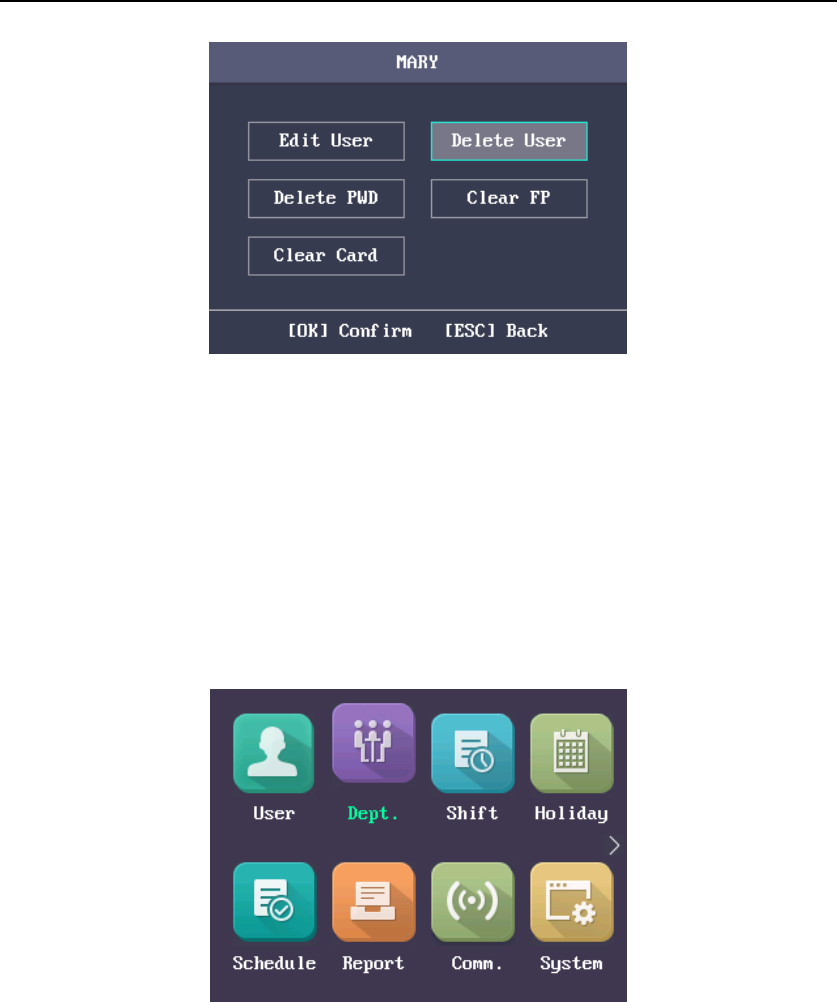
Fingerprint Time Attendance Terminal
25
3. Select Delete User and press the OK key to delete the target user. The linked
user information will be deleted.
Or press Delete Password and press the OK key to delete the target user
password.
Or press Clear Fingerprint and press the OK key to clear the target user
fingerprint.
Or press Clear Card and press the OK key to delete the user card No.
3.5 Department Management
Purpose:
Editing, searching and resetting the department are available.
3.5.1 Editing and Resetting the Department
Steps:
1. Select a target department to edit.
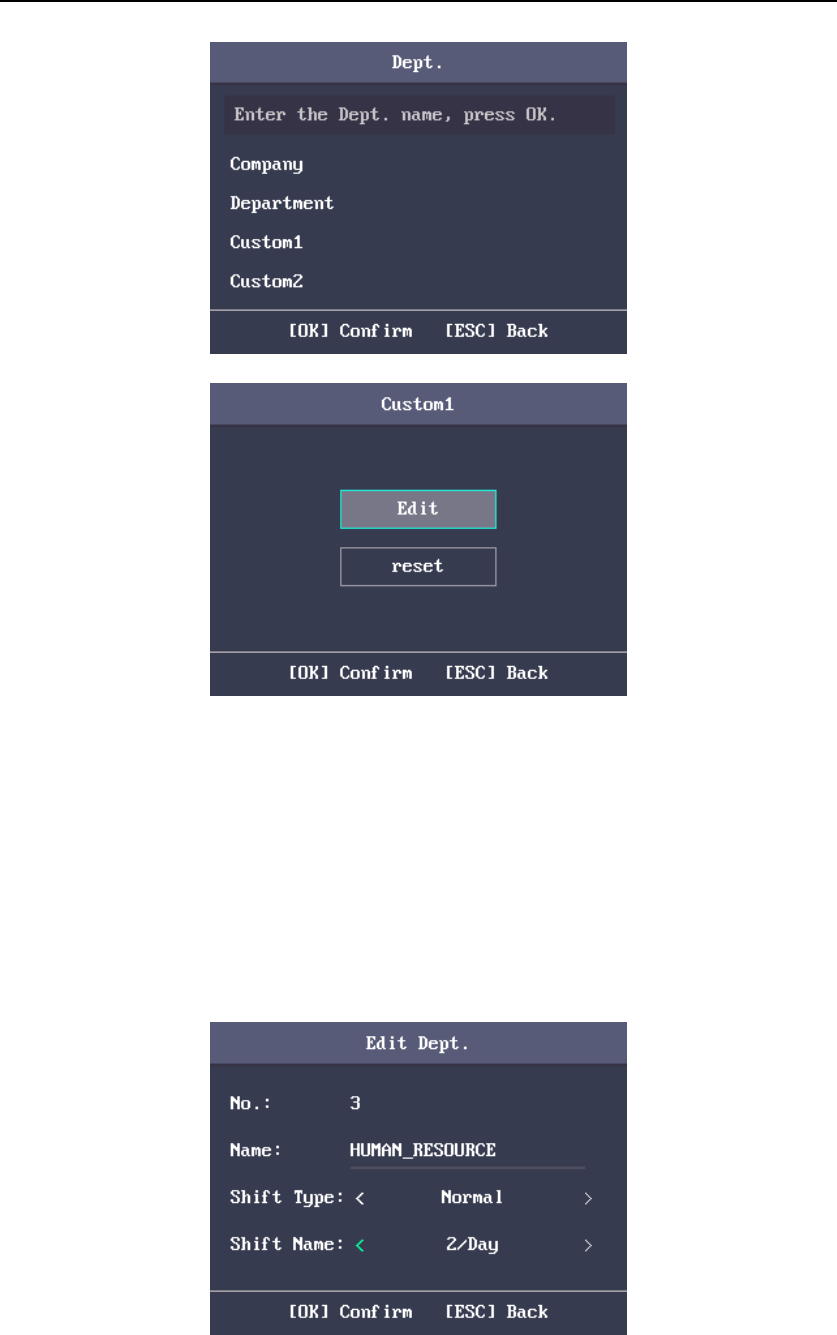
Fingerprint Time Attendance Terminal
26
2. Press the OK key to enter the configuration interface.
3. Select Edit and press the OK key.
4. Edit the department name, the shift type and the shift name.
5. Press the ESC key and select Yes to save the settings and exit the interface.
Notes:
The department name supports numbers, uppercase letters,
lowercase letters, Chinese characters and symbols.
The department name supports up to 32 characters.
You can configure the shift in the Shift Management. For detailed
information, see Section 3.6 Shift Management.
By default, the system contains 32 departments.
You can also select Reset to reset the settings.
3.5.2 Searching the Department
Purpose:
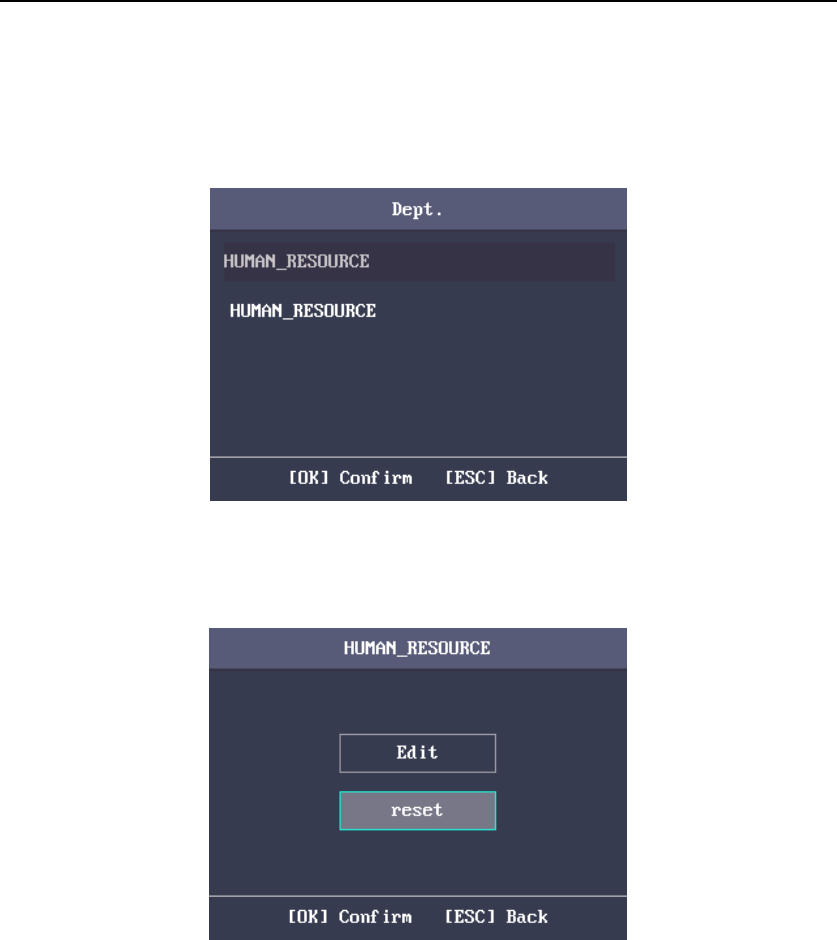
Fingerprint Time Attendance Terminal
27
Search the target department by entering the department name.
Steps:
1. Enter the target department name in the searching bar of the department list
interface.
2. Press the OK key to search.
3.5.3 Resetting the Department
Purpose:
Reset all parameters of the target department to the default ones.
3.6 Shift Management
Purpose:
The normal shift and the man-hour shift are available to be configured. You can set the
attendance rule and the attendance checking times in the normal shift. You can also set
the working hours per day in the man-hour shift.
The normal shift can be applied to the normal attendance situation, while the man-hour
shift can be applied to the situation with flexible working hours.
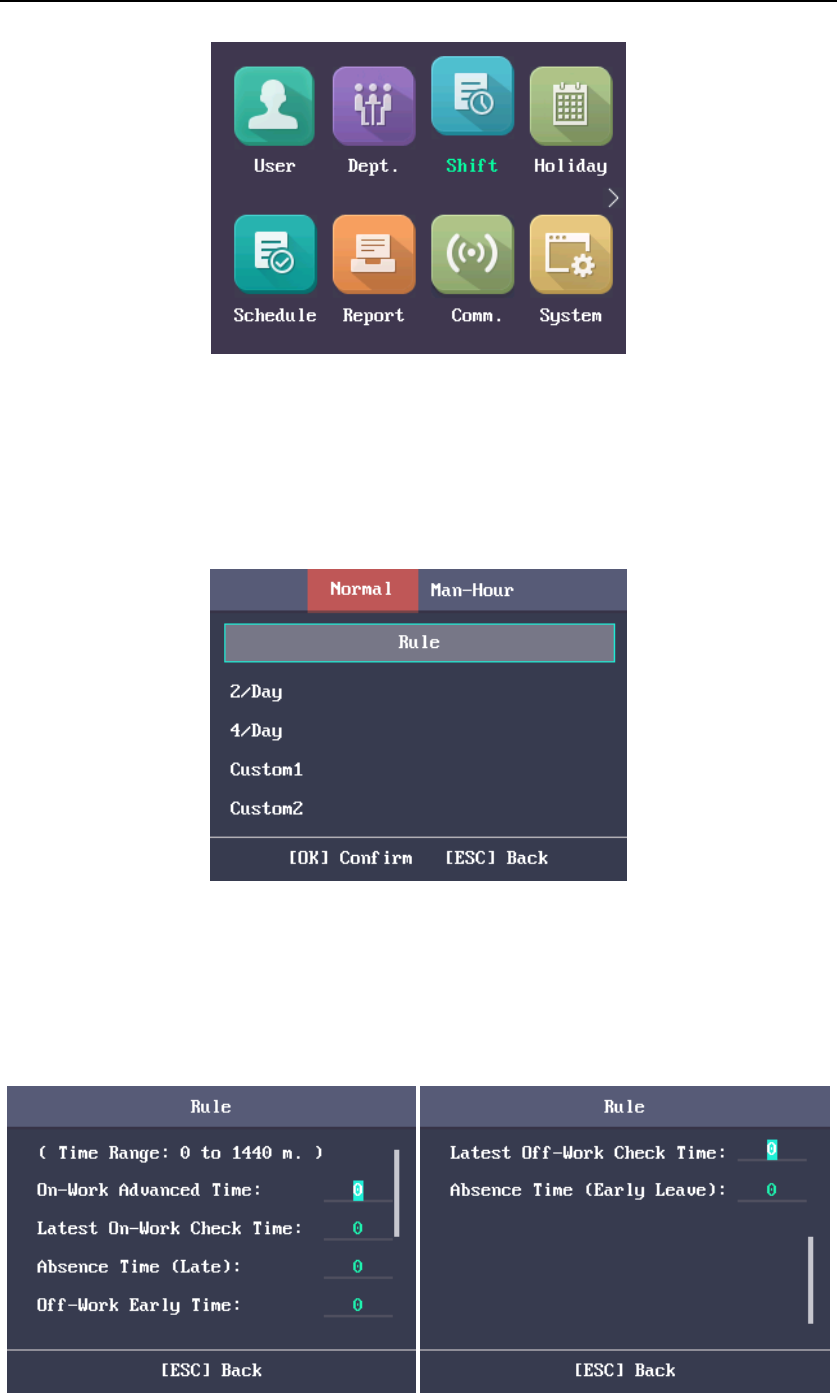
Fingerprint Time Attendance Terminal
28
Note: Support up to 32 normal shifts and 32 man-hour shifts.
3.6.1 Normal Shift
Setting the Attendance Rule
Steps:
1. In the Normal (Normal Shift) interface, select Rule.
2. Configure the attendance rule.
On-work Advanced Time: The allowable early duration to go to work.
Latest On-Work Check Time: The allowable late duration to go to work.
Absence Time (Late): The late arrival threshold duration.
Off-Work Early Time: The allowable early duration to get off work.
Latest Off-Work Check Time: The allowable late duration to get off work.
Absence Time (Early Leave): The early leave threshold duration.
3. Press the ESC key and select Yes to save the settings and exit the interface.
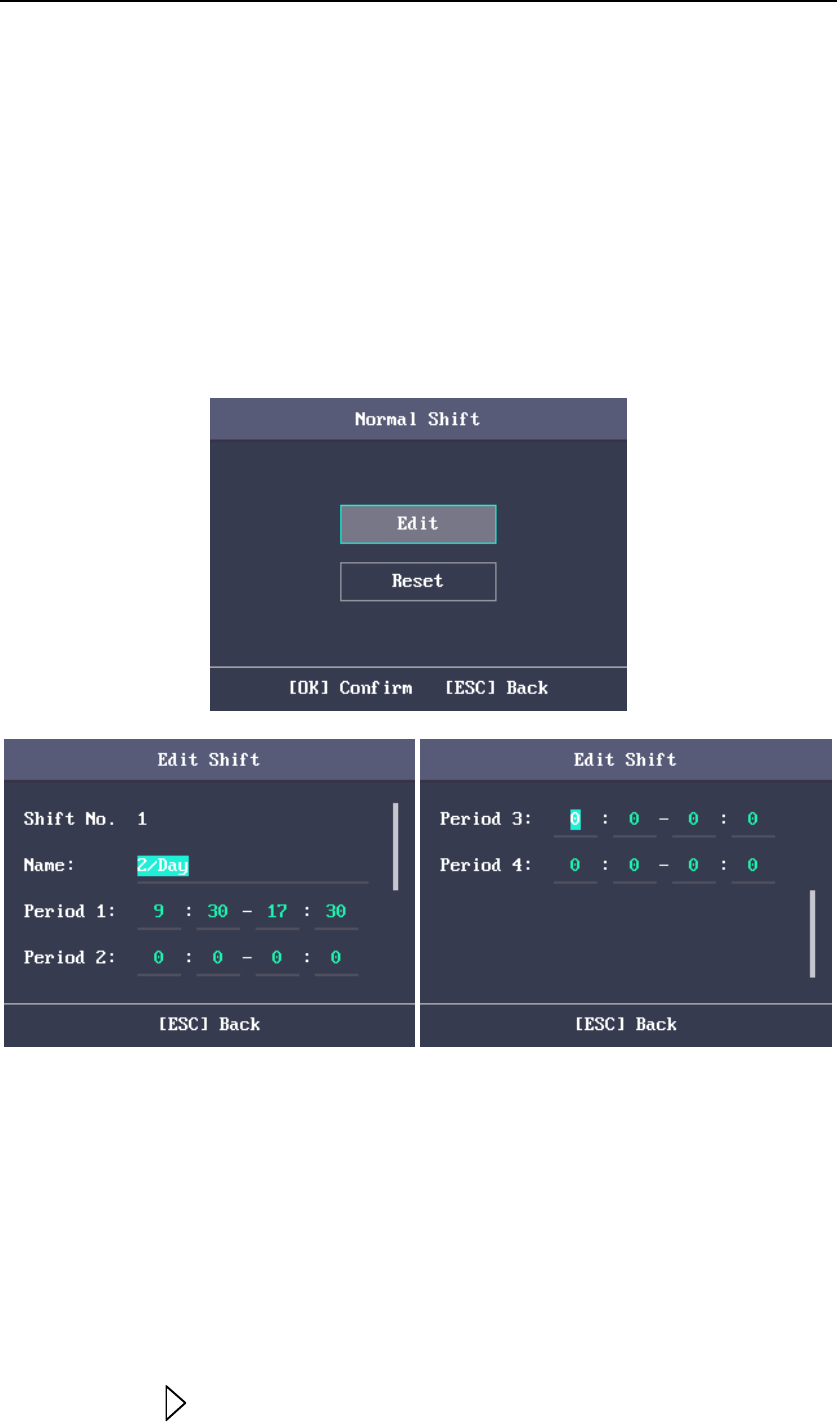
Fingerprint Time Attendance Terminal
29
Notes:
Unit: minute.
The available time range is from 0 to 1440 minutes.
Setting Normal Shift Attendance
Steps:
1. Select an attendance type in the Normal (Normal Shift) interface.
Notes:
By default, the normal shift type includes 2/Day (2 times per day), 4/Day
(4 times per day), and 30 custom types.
The following steps will take Custom 1 as an example.
2. Select Edit and press the OK key to enter the Edit Shift interface.
3. Edit the shift name, and the period in order.
Notes:
The shift No. cannot be edited.
The shift name supports numbers, uppercase letters, lowercase letters,
Chinese characters and symbols.
The shift name supports up to 32 characters.
Up to 4 time periods can be edited.
You can also select Reset to reset the settings.
4. Press the ESC key and select Yes to save the settings and exit the interface.
3.6.2 Man-Hour Shift
Steps:
1. Press the key to enter the Man-Hour interface.
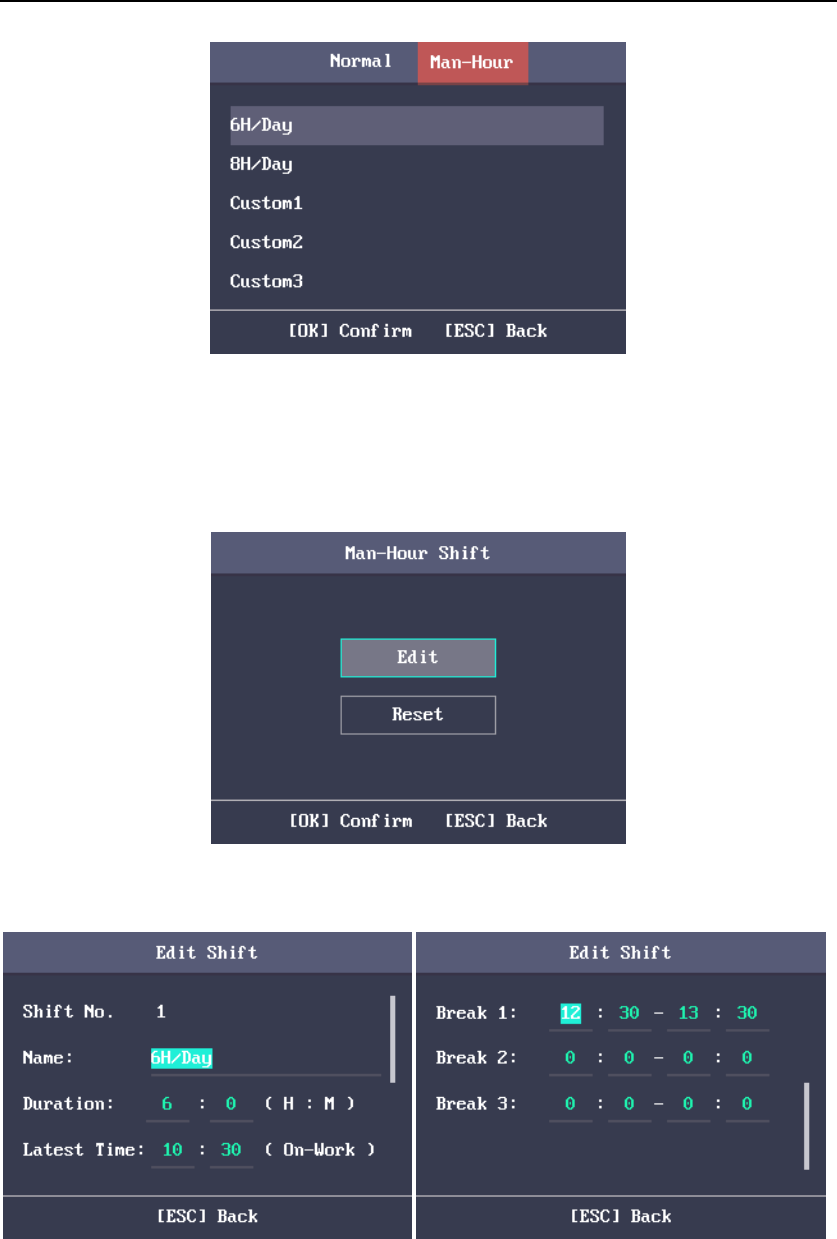
Fingerprint Time Attendance Terminal
30
2. Select a man-hour shift type in the list.
Notes:
By default, the man-hour shift type includes 6H/Day (6 hours per day),
4H/Day (4 hours per day), and 30 custom types.
The following steps will take Custom 1 as an example.
3. Press the OK key to enter the Man-Hour Shift configuration interface.
4. Select Edit to enter the Edit Shift interface.
You can edit the shift name, the shift duration (work duration), the latest time
on-work and the break time.
Notes:
The shift No. cannot be edited.
The break time will not be counted into the working hour.
If the Latest Time (On-Work) is set to 0, the Latest Time function will not
be enabled.
You can also select Reset and press the OK key to reset the settings.

Fingerprint Time Attendance Terminal
31
5. Press the ESC key and select Yes to save the settings and exit the interface.
3.7 Holiday Management
Purpose:
You are able to configure the attendance holiday. The attendance will not be recorded
during the holiday.
3.7.1 Adding the Holiday
Steps:
1. In the Holiday interface, press the key to enter the New (New Holiday)
interface.
2. Enter the holiday No., the holiday name, the holiday start time and the end time.
3. Press the ESC key and select Yes to save the settings and exit the interface. The
new holiday will be displayed in the Holiday list.
3.7.2 Searching the Holiday
Steps:
1. In the Holiday List interface, enter the target holiday name.
2. Press the OK key to search.
3.7.3 Editing and Deleting the Holiday
Steps:
1. Select a target holiday in the Holiday List interface to enter the Holiday Settings
interface.
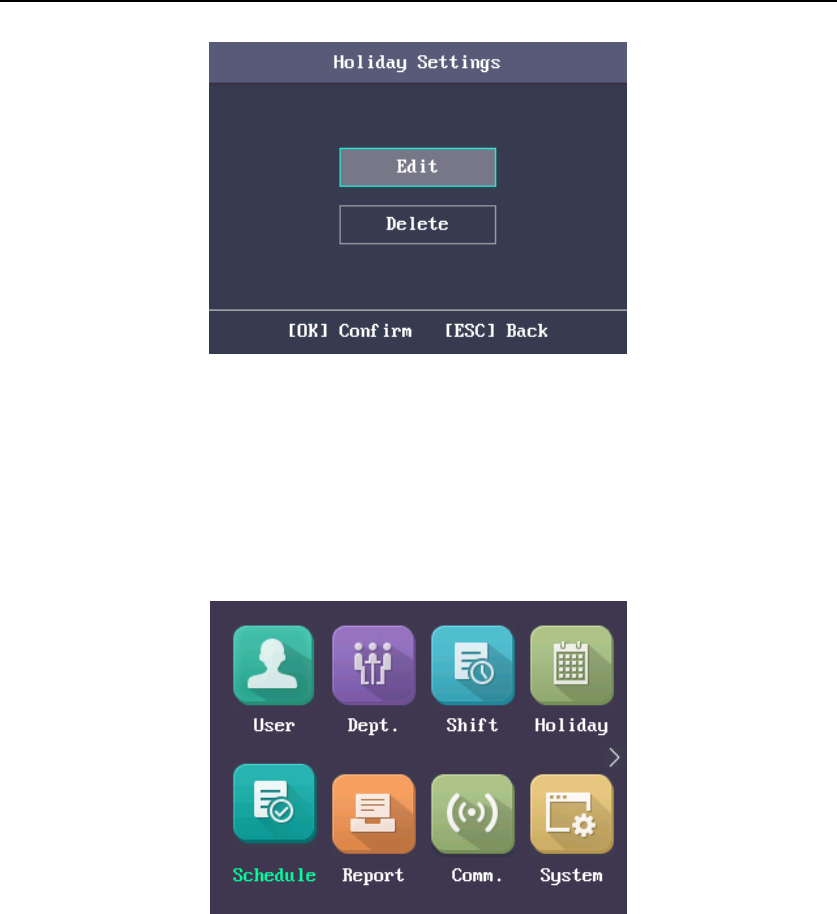
Fingerprint Time Attendance Terminal
32
2. Select Edit and follow the steps in Section 3.7.1 Adding the Holiday to edit the
holiday information.
Or select Delete and press the OK key to delete the holiday.
3. Press the ESC key and select Yes to save the settings and exit the interface.
3.8 Shift Schedule Management
Purpose:
Configure the shift schedule by department or by individual.
3.8.1 Scheduling Shift by Department
Before you start:
1. Edit the department. For detailed information, see Section 3.5 Department
Management.
2. Configure the normal shift or the man-hour shift. For detailed information, see
Section 3.6 Shift Management.
Steps:
1. Select a target department in the By Dept. (Schedule by Department) interface.
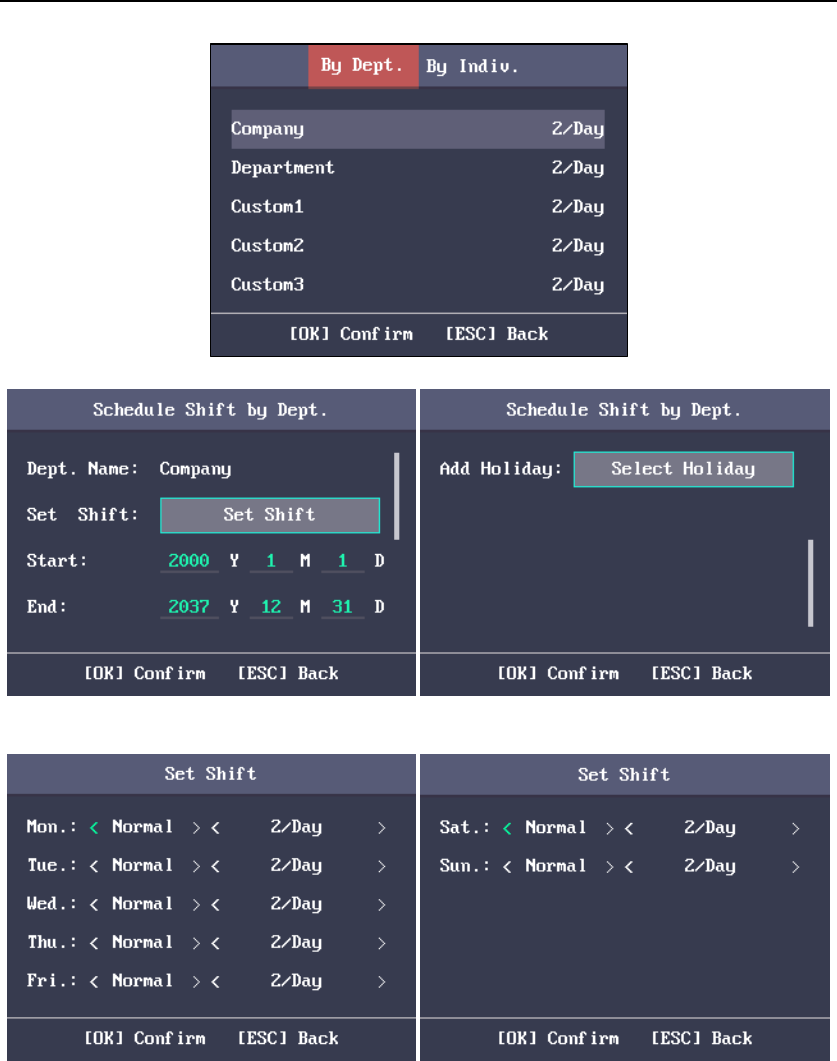
Fingerprint Time Attendance Terminal
33
2. Press the OK key to enter the Schedule Shift by Dept. interface.
3. Move the cursor to Set Shift and press the OK key to enter the Set Shift interface.
1) Select the shift type and the shift times.
Notes:
You can set the shift from Monday to Sunday.
The shift types include None, Normal, and Man-Hour.
2) Press the ESC key and select Yes to save the settings and exit the interface.
4. Set the schedule start time and the end time.
5. Move the cursor to Select Holiday and press the OK key.
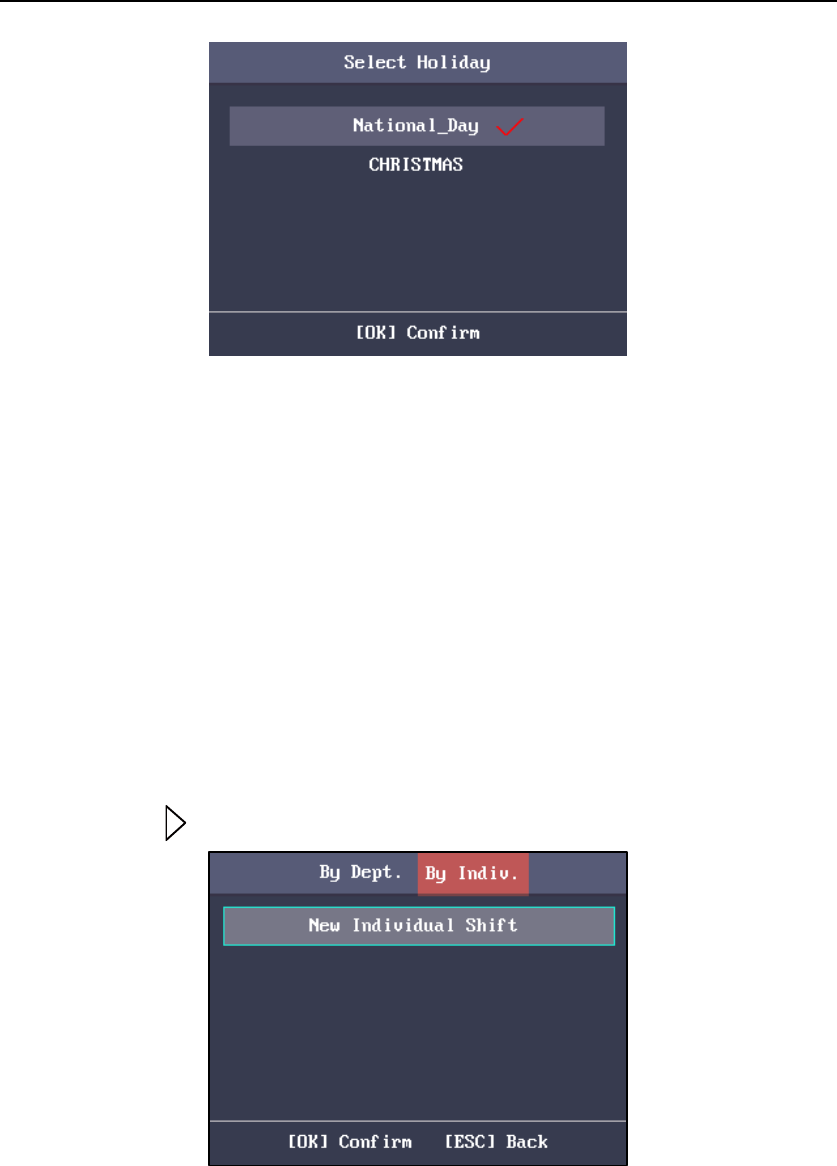
Fingerprint Time Attendance Terminal
34
1) Select a target holiday.
2) Press the ESC key and select Yes to save the settings and exit the interface.
Notes: The attendance will not be recorded during the holiday.
6. Press the ESC key and select Yes to save the settings and exit the interface.
Note: The department name cannot be edited.
3.8.2 Scheduling Shift by Individual
Up to 32 individual shifts can be added.
Adding New Individual Shift
Before you start:
1. Add the user. For detailed information, see Section 3.4 User Management.
2. Configure the normal shift or the man-hour shift. For detailed information, see
Section 3.6 Shift Management.
Steps:
1. Press the key to enter the By Individual (Schedule by Individual) interface.
2. Select New Individual Shift and press the OK key to enter New Individual Shift
interface.
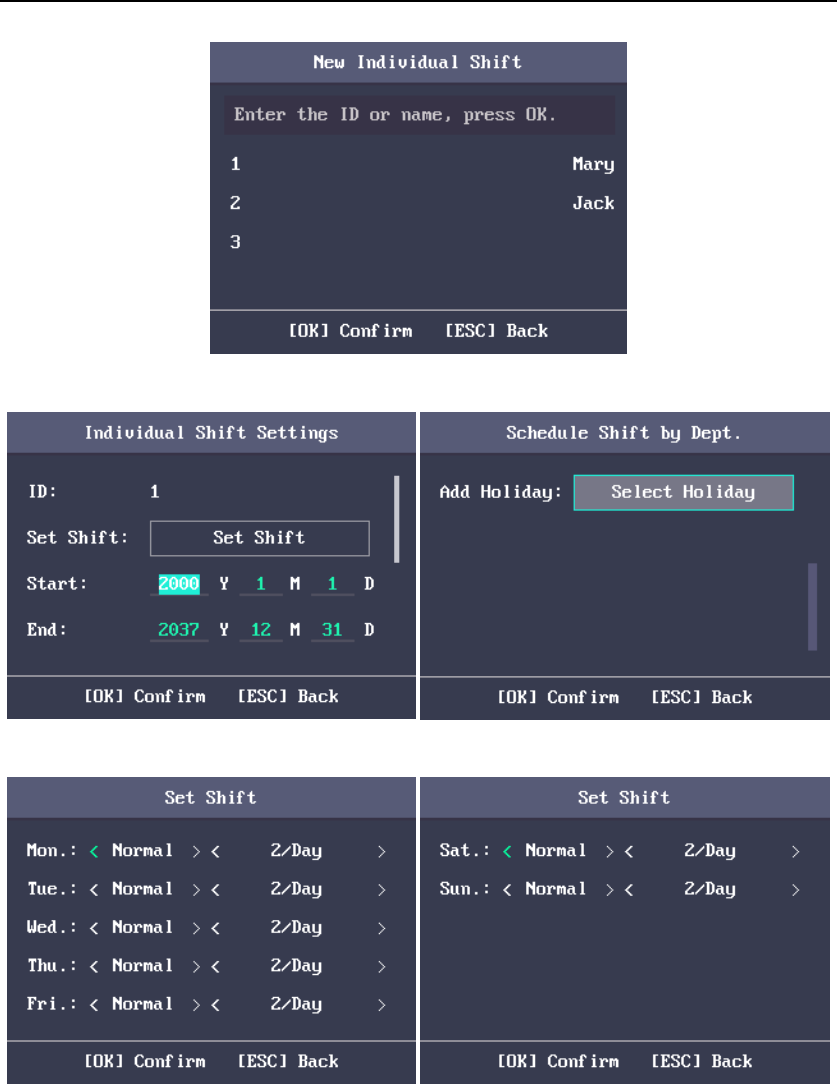
Fingerprint Time Attendance Terminal
35
3. Select an individual in the list and press the OK key to enter the Individual Shift
Settings interface.
4. Move the cursor to Set Shift and press the OK key to enter the Set Shift interface.
1) Select the shift types and the shift times.
Notes:
You can set the shift from Monday to Sunday.
The shift types include None, Normal, and Man-Hour.
2) Press the ESC key and select Yes to save the settings and exit the interface.
5. Set the start time and the end time in the Individual Shift Settings interface.
6. Select Select Holiday and press the OK key to enter the Select Holiday interface.
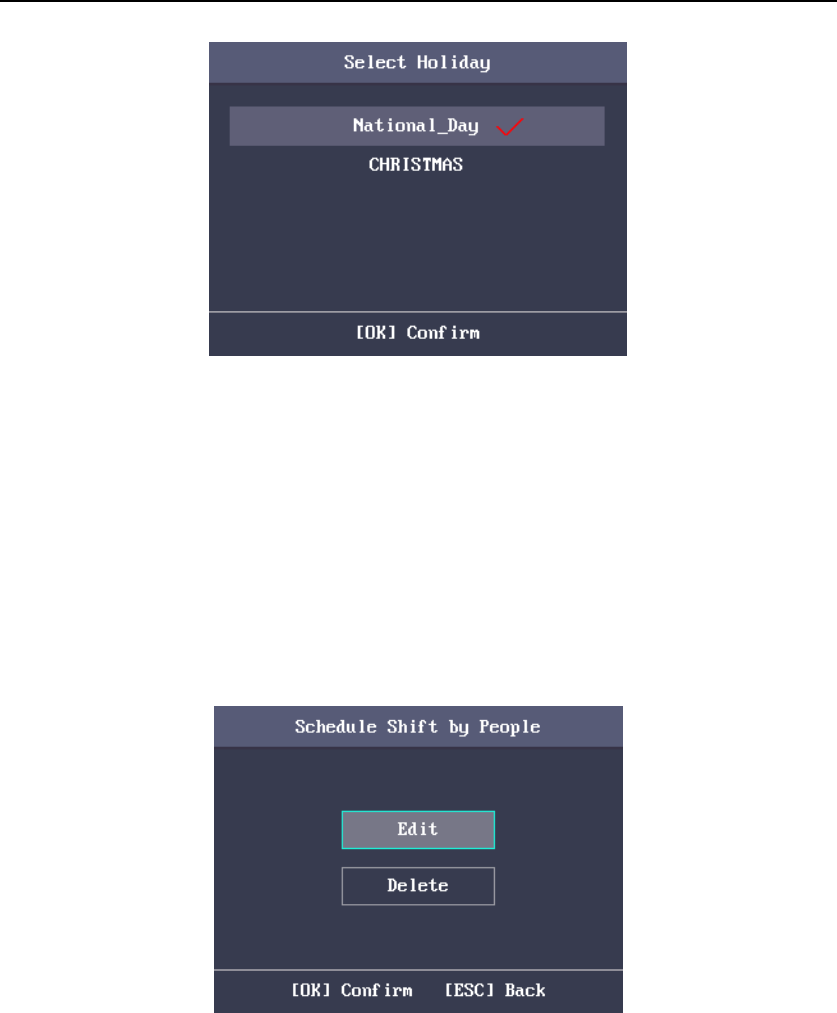
Fingerprint Time Attendance Terminal
36
1) Select a target holiday.
2) Press the ESC key and select Yes to save the settings and exit the interface.
Note: The attendance will not be recorded during the holiday.
7. Press the ESC key and press the OK key to save the settings and exit the interface.
Editing and Deleting Individual Shift
Steps:
1. Select an individual shift in the By Individual (Schedule by Individual) interface.
2. Select Edit and press the OK key to enter the Individual Shift Settings interface.
Follow Adding New Individual Shift in Section 3.8.2 Scheduling Shift by Individual
to edit the shift.
Or select Delete to delete the selected individual shift.
3.9 Other Management
3.9.1 Report Management
Purpose:
You are able to export the attendance report, the attendance report, the abnormal
attendance record and the attendance management schedule.
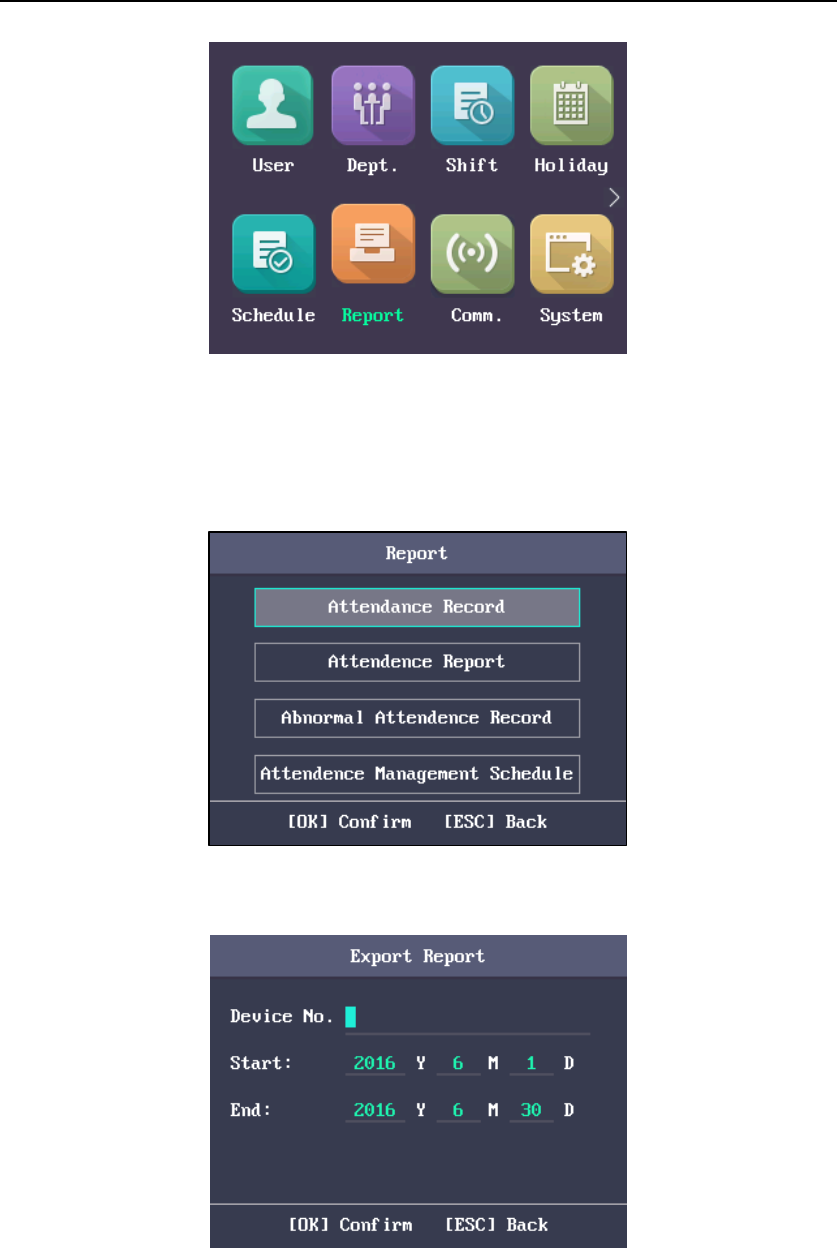
Fingerprint Time Attendance Terminal
37
Steps:
1. Insert a USB disk to the USB interface.
Note: The device will automatically check the USB disk memory. If there is no
enough space for exporting, a prompt will be displayed.
1. Select Attendance Record/Attendance Report/Abnormal Attendance Record in
the Report interface.
2. Edit the device No. the start time and the end time in the Export Report interface
Note: You should customize the device No. The device No. is for differentiating
the reports of different devices.
Or select Attendance Management Schedule in the Report Management
interface to export the Shift Settings Table, the Normal Shift Schedule table and
the Man-Hour Shift Schedule table directly.
3. Press the OK key to export. The exported file will be saved in the USB disk in Excel
format.
Notes:
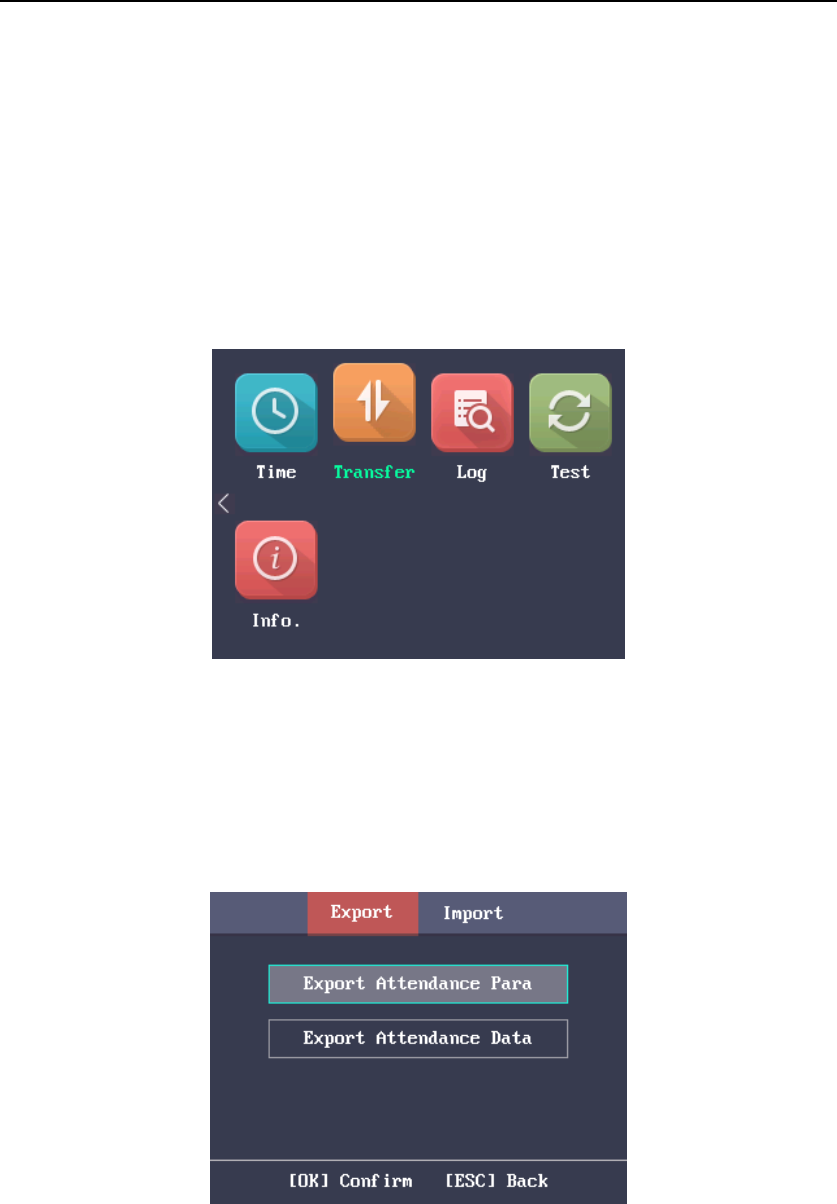
Fingerprint Time Attendance Terminal
38
Support the USB disk of FAT32 format.
The USB disk memory should be from 1G to 32G. Make sure the free
space of the USB disk is more than 512M.
For details about the exported tables descriptions, see Section 5.4
Attendance Report Table.
3.9.2 Data Transfer
Purpose:
You can export the attendance parameters and the attendance data. You can also import
the attendance parameters from the USB disk.
Exporting Parameters and Data
Steps:
1. Insert the USB disk to the USB interface.
Note: The device will automatically check the USB disk memory. If there is no
enough space for exporting, a prompt will be displayed.
2. In the Export interface, select Export Attendance Para (Export Attendance
Parameters)or Export Attendance Data.
3. Press the OK key, the attendance parameters or the attendance data will be
saved in the USB disk.
Notes:
When the USB disk is full, the device will pop up a prompt. You have to
change another one to continuing exporting.
Support the USB disk of FAT32 format.
The USB disk memory should be from 1G to 32G.
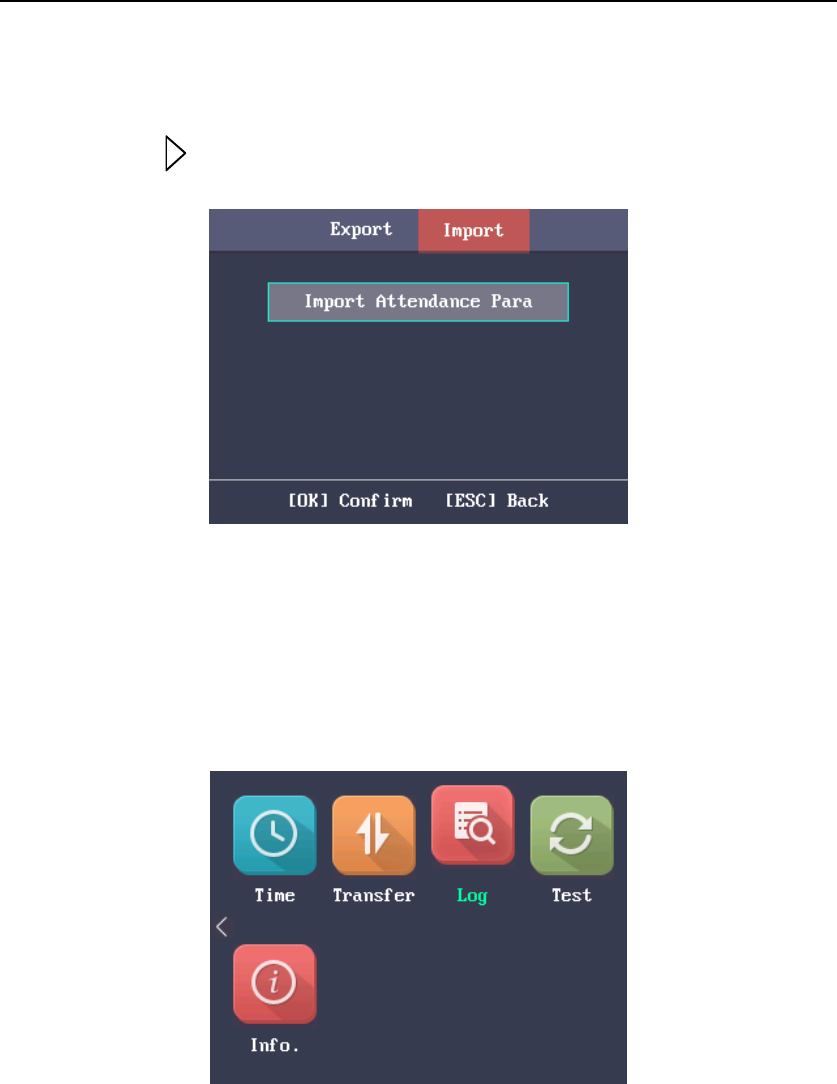
Fingerprint Time Attendance Terminal
39
Importing Attendance Parameters
Steps:
1. Insert the USB disk to the USB interface.
2. Press the key to enter the Import interface and select Import Attendance
Para (Import Attendance Parameters).
3. Press the OK key to import.
Notes:
Support the USB disk of FAT32 format.
The file for importing should be in the root directory.
3.9.3 Searching the Log
Purpose:
You are able to search the attendance log in the target time duration of the target ID No.
Steps:
1. Enter the ID No. in the Log (Log Search) interface.
2. Move the cursor the Name, the corresponding name will be displayed
automatically.
Or enter the name and move the cursor to the ID No., the corresponding ID No.
will be displayed automatically.
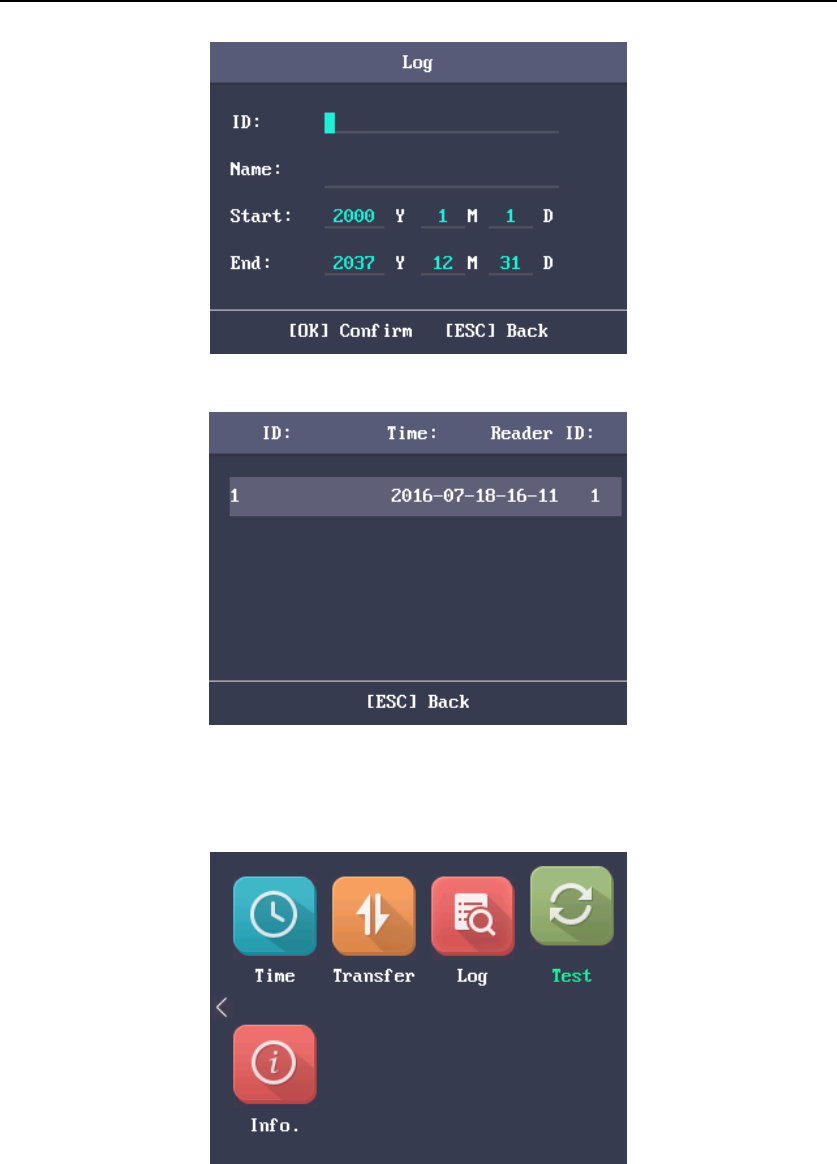
Fingerprint Time Attendance Terminal
40
3. Enter the target log start time and the end time.
4. Press the OK key to search. The interface will display the log search result.
3.9.4 Testing
Purpose:
You are able to perform the voice test, the keypad test and the RTC test.
Voice Test
Steps:
1. Select Voice Test in the Test interface.
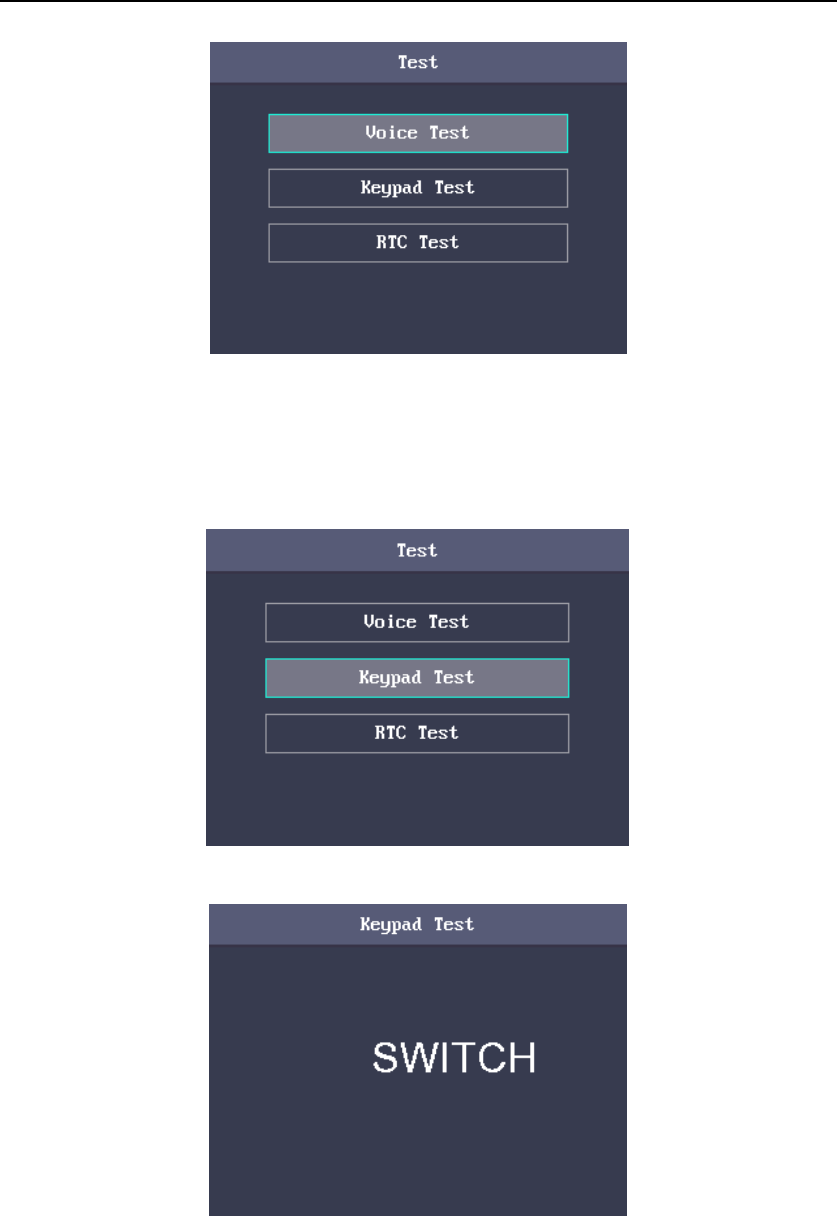
Fingerprint Time Attendance Terminal
41
2. Press the OK key. If the device voice is working properly, you are able to hear
“Voice Test Success”.
Keypad Test
Steps:
1. Select Keypad Test in the Test interface.
2. Press the OK button to start testing. If the keypad test succeeds, the screen will
display the corresponding numbers or functions of the pressed key.
RTC Test
Steps:
1. Select RTC Test in the Test interface.
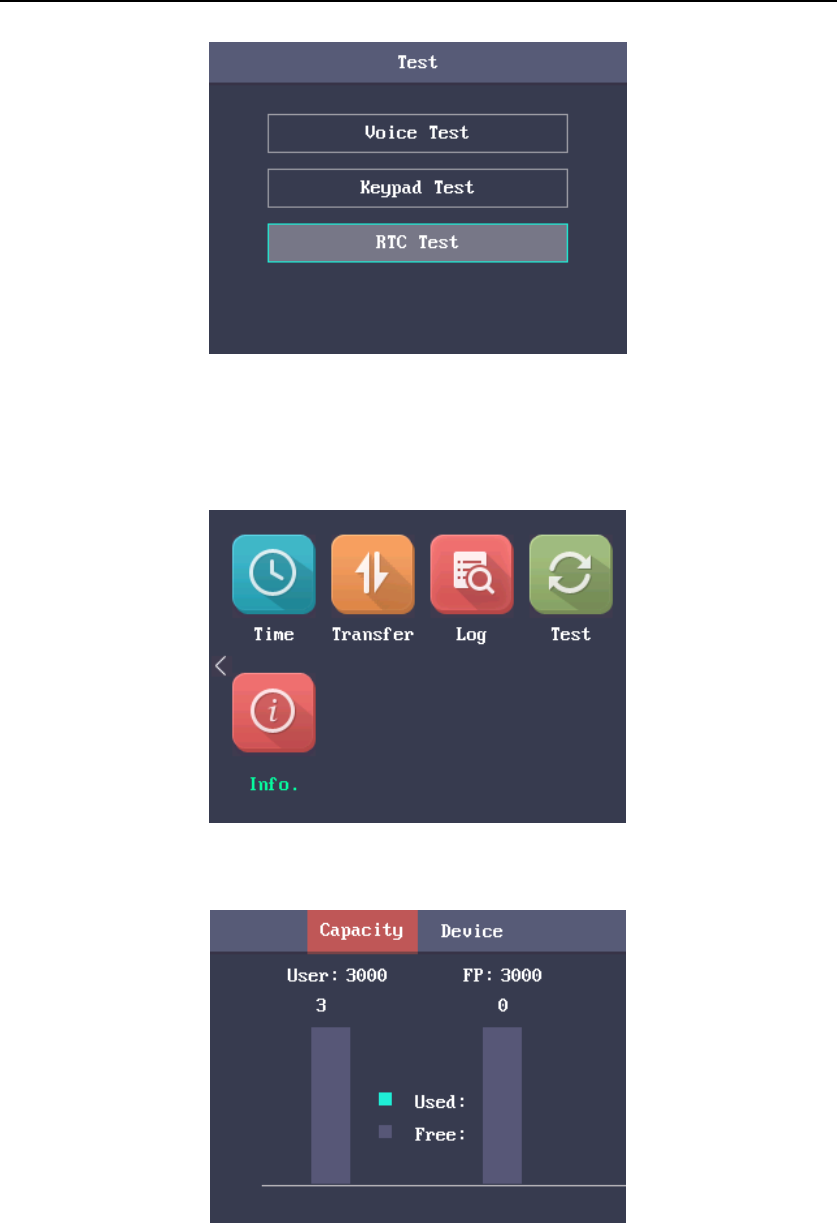
Fingerprint Time Attendance Terminal
42
2. Press the OK key to enter the RTC Test interface. If the test succeeds, the screen
will display the synchronization time.
3.9.5 System Information
You are able to check the device capacity and the device information.
Checking the Capacity
Check the user capacity and the fingerprint capacity in the device.
User Capacity: The maximum user amount that can be configured.
Note: The default maximum user amount is 3,000.
Fingerprint Capacity: The maximum fingerprint amount.
Note: The default maximum fingerprint amount is 3,000.
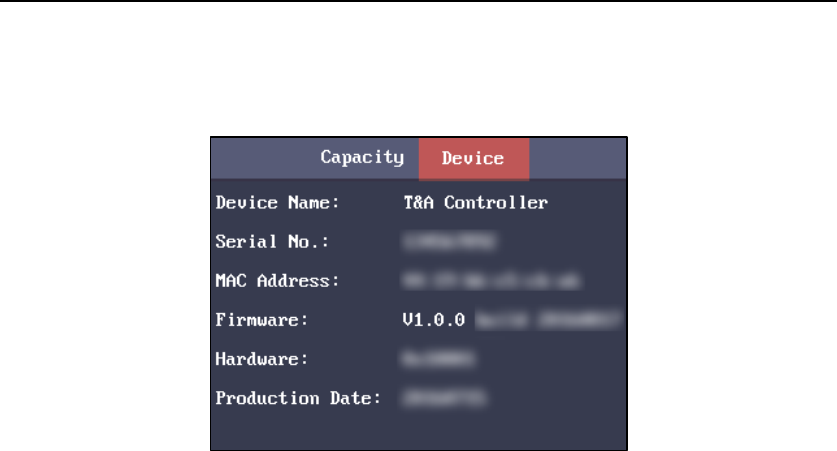
Fingerprint Time Attendance Terminal
43
Checking the Device Information
In the Device interface, you are able to check the device name, the device serial No., the
MAC address, the firmware, the hardware and the production data.
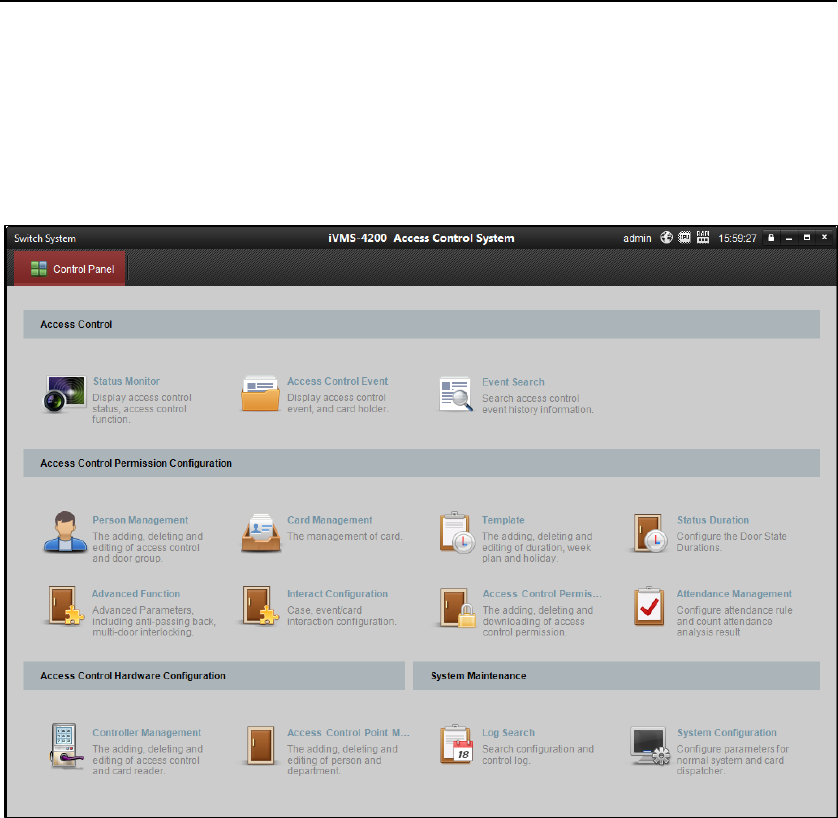
Fingerprint Time Attendance Terminal
44
Chapter 4 Client Operation
4.1 Overview of Access Control System
Click Switch System-> Access Control System on the menu bar to enter the Access
Control System.
4.1.1 Description
The Access Control System is a client of configuring permission of door access. It
provides multiple functionalities, including access controller management,
person/card management, permission configuration, door status management,
attendance management, event search, etc.
This user manual describes the function, configuration and operation steps of Access
Control Client. To ensure the properness of usage and stability of the client, please
refer to the contents below and read the manual carefully before installation and
operation.
4.1.2 Configuration Flow
Refer to the following flow chart for the configuration order.
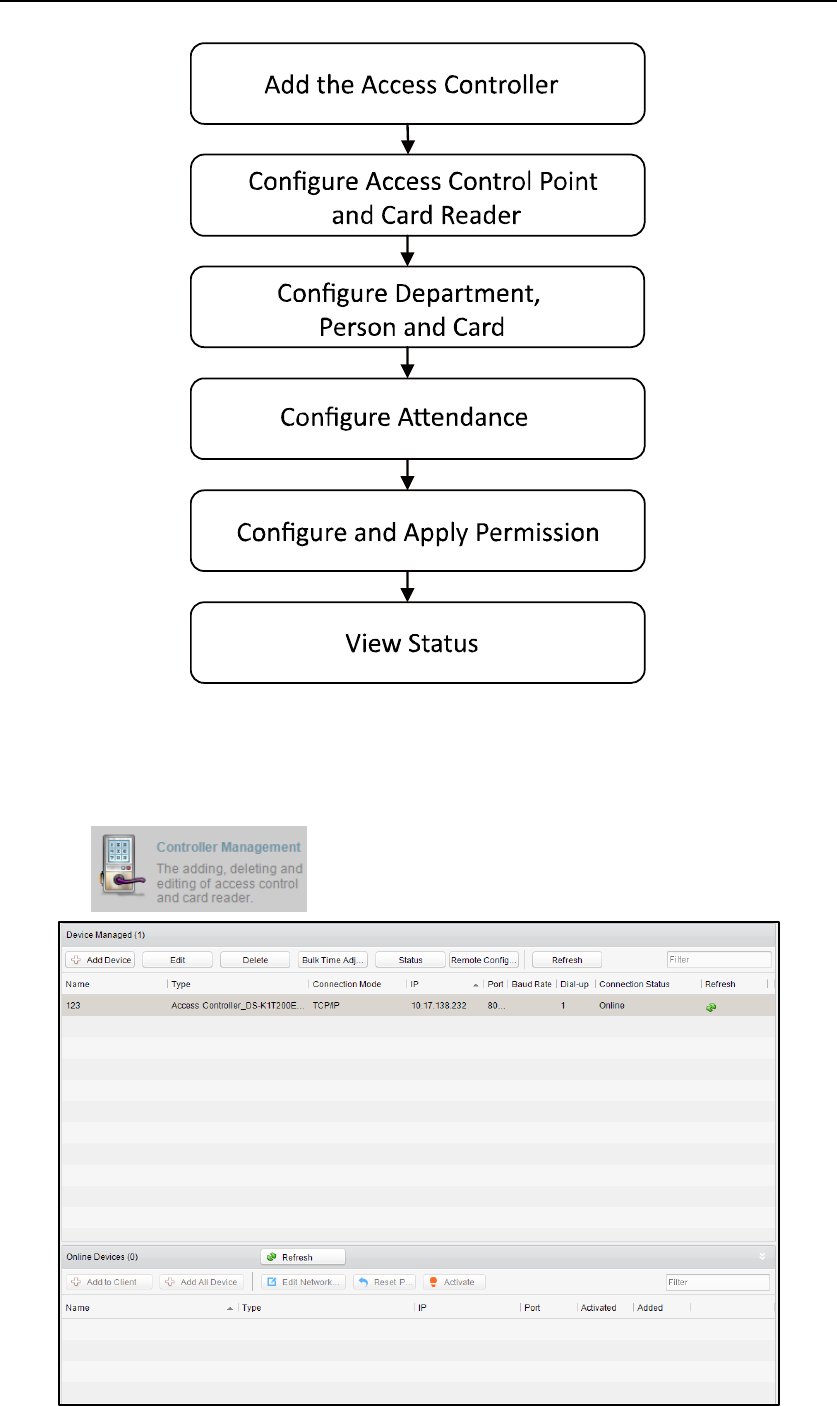
Fingerprint Time Attendance Terminal
45
4.2 Device Management
4.2.1 Controller Management
Click the icon to enter the controller management interface.
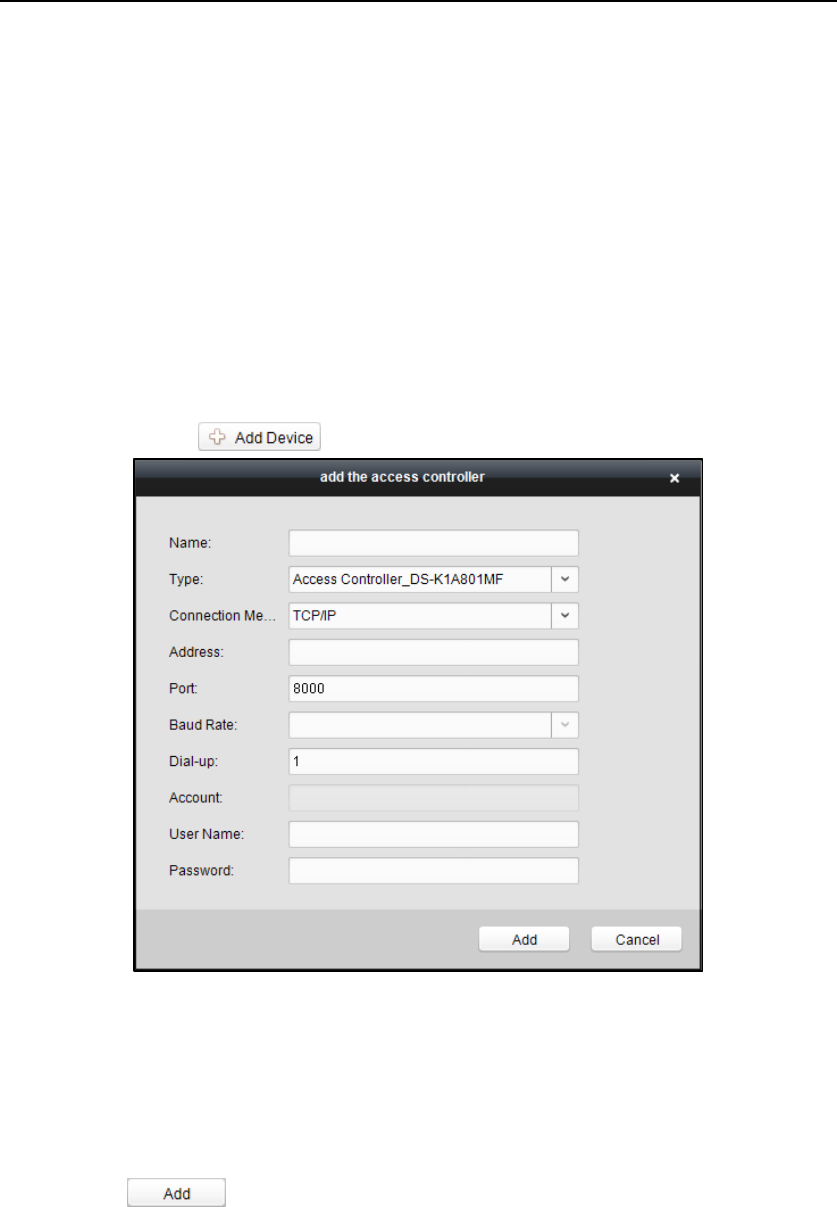
Fingerprint Time Attendance Terminal
46
The interface is divided into 2 parts: device management and online device
detection.
Device Management:
Manage the access control devices, including adding, editing, deleting, and batch
time synchronizing functions.
Online Device Detection:
Automatically detect online devices in the same subnet with the access control
server, and the detected devices can be added to the server in an easy way.
Note: The control client can manage 16 access controllers at most.
Device Management
Adding Controller
Steps:
1. Click the button to enter the add access controller interface.
2. Input the device name.
3. Select the access controller type in the dropdown list.
4. Select the connection mode in the dropdown list: TCP/IP, or COM port.
TCP/IP: Connect the device via the network.
5. Set the parameters of connecting the device.
If you choose to connect the device via network, you should input the IP address
and port No. of the device, and set the Dial-up value to 1.
6. Click the button to finish adding.
You can click Status to check the detailed status of the controller, and click Remote
Configuration to configure the settings of the controller.
Editing Device (Basic Information)
Purpose:
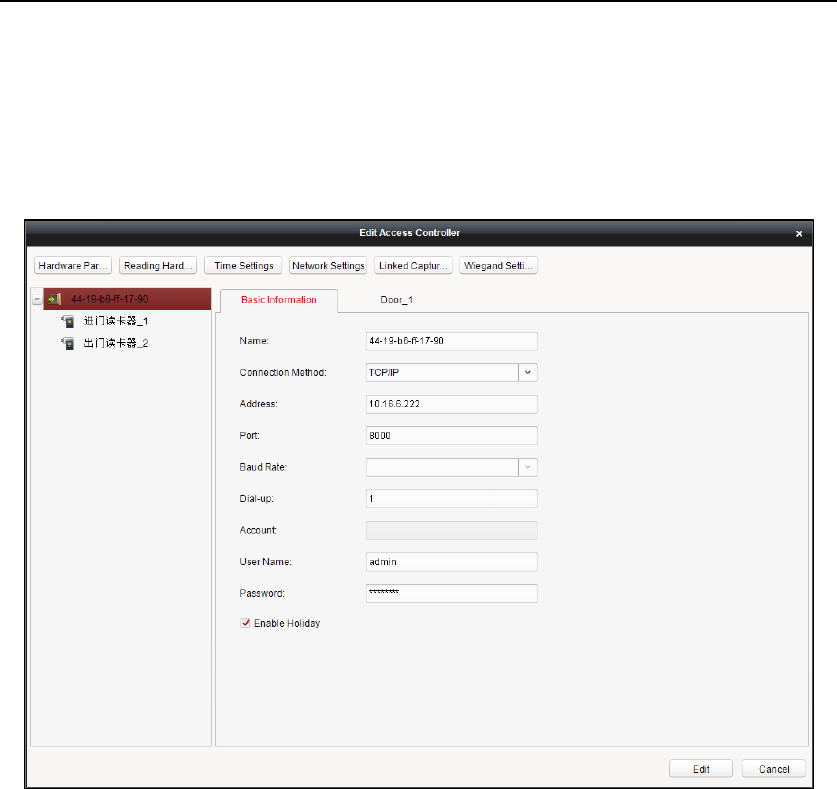
Fingerprint Time Attendance Terminal
47
After adding the device, some advanced parameters can be configured in the editing
device interface, e.g. downloading hardware parameters, reading hardware
parameters, time synchronizing, configuring access point, etc.
Steps:
1. In the device list, click Edit button to edit the information of the selected added
device.
2. Edit the basic parameters of the device on your demand, which are the same as
the ones when adding the device.
3. (Optional) Check the checkbox of Enable Holiday to enable the holiday
parameters when downloading permissions.
4. Click the Edit button to finish editing.
5. Click the Hardware Parameters Downloading button to download the updated
parameters to the local memory of the device.
Note: Capture function is not supported.
Editing Device (Door Information)
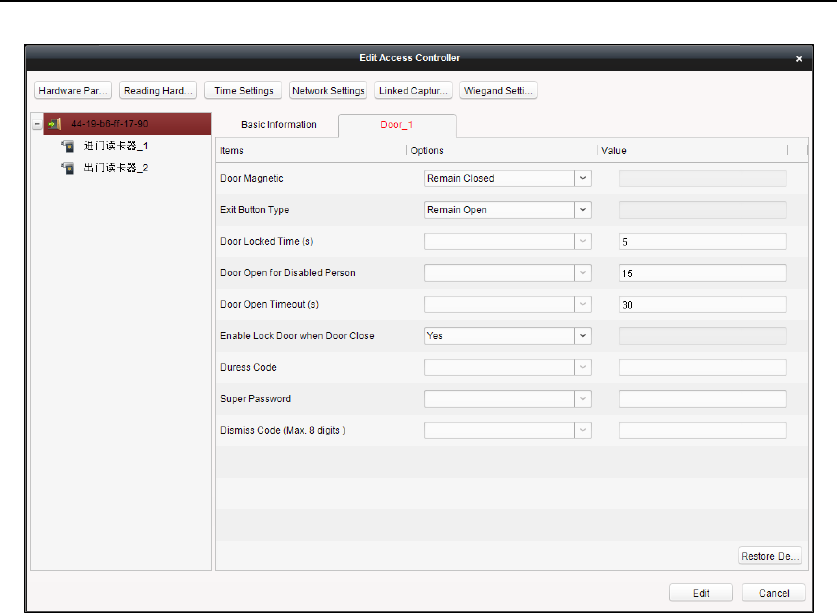
Fingerprint Time Attendance Terminal
48
Steps:
1. In the editing interface, click the Door_1 button to edit the information of the
selected door.
1) Door Magnetic: The Door Magnetic is in the status of Remain Closed
(excluding special conditions).
2) Exit Button Type: The Exit Button Type is in the status of Remain Open
(excluding special conditions).
3) Door Locked Time(s): After swiping the normal card and relay action, the
timer for locking the door starts working.
4) Door Open for Disabled Person: The door magnetic can be enabled with
appropriate delay after disabled person swipes the card.
5) Door Open Timeout(s): The alarm can be triggered if the door has not been
close
6) Enable Lock Door when Door Close: This function has not been supported
yet.
7) Duress Code: The door can open by inputting the duress code when there is
a duress. At the same time, the access system can report the duress event.
8) Super Password: The specific person can open the door by inputting the
super password.
2. Click the Restore Default Value to restore all parameters into default settings.
3. Click the Edit button to save parameters.
4. Click the Hardware Parameters Downloading button to download the updated
parameters to the local memory of the device.
Note: The attendance device does not support the function.
Editing Device (Card Reader Information)
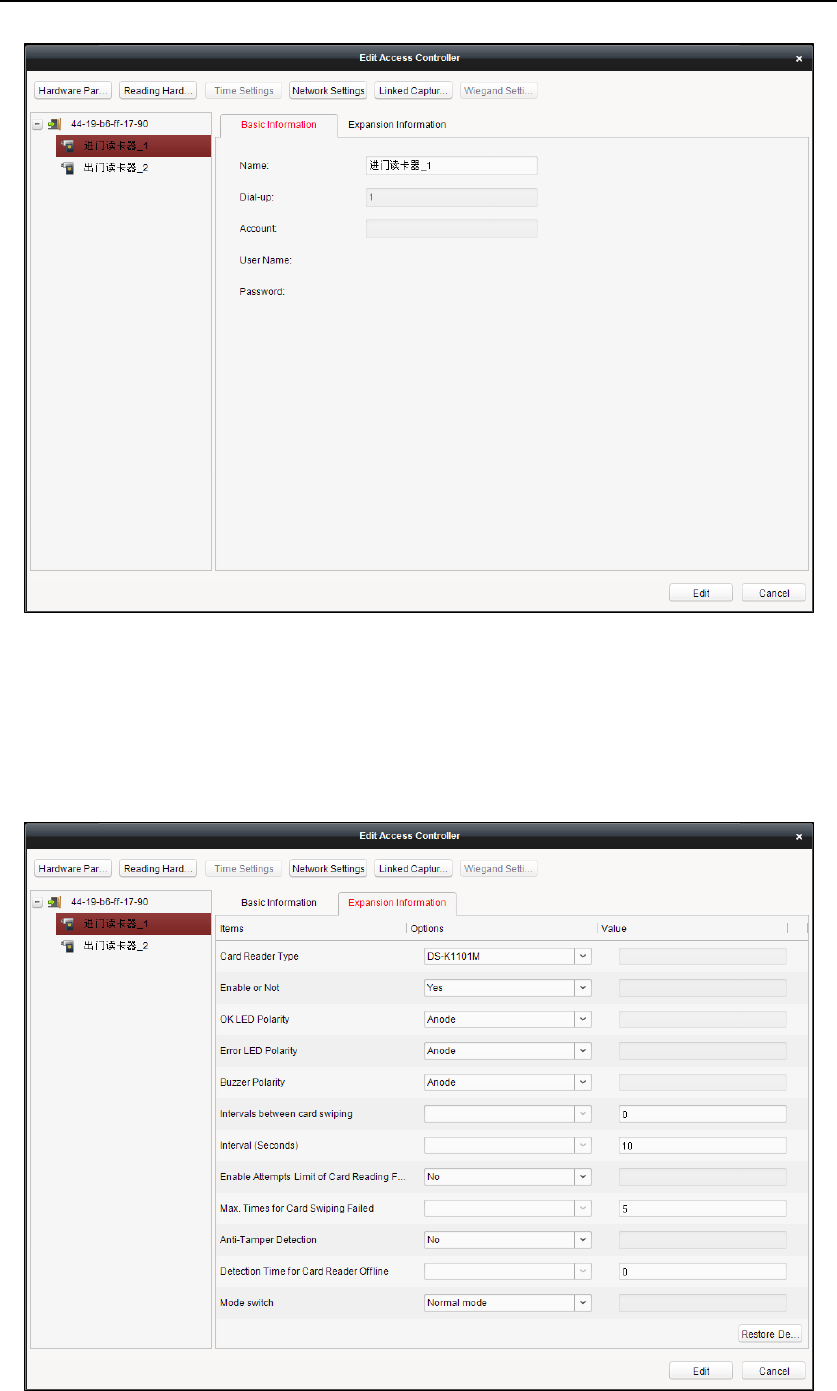
Fingerprint Time Attendance Terminal
49
Steps:
1. In the device list, select a card reader name to enter into the card reader
information editing interface.
2. Click the Basic Information button to edit the basic information about the card
reader.
3. Click the Expansion Information button to edit the expansion information about
the card reader.
4. Click the Edit button to save parameters.
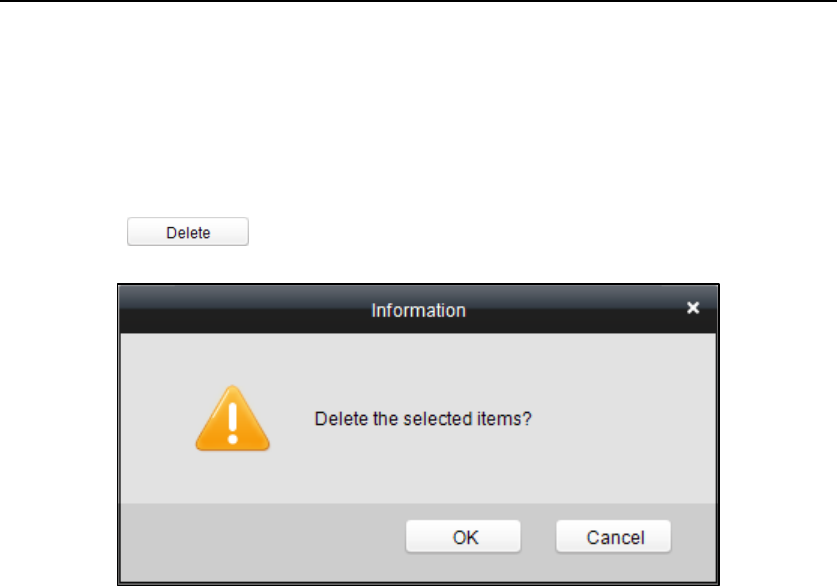
Fingerprint Time Attendance Terminal
50
5. Click the Hardware Parameters Downloading button to download the updated
parameters to the local memory of the device.
Deleting Device
Steps:
1. In the device list, select a device by clicking it, or select multiple devices by
pressing Ctrl button on your keyboard and clicking them one by one.
2. Click the button to delete the selected device(s).
3. Click OK button in the popup confirmation dialog to finish deleting.
Bulk Time synchronization
Steps:
1. In the device list, select a device by clicking it, or select multiple devices by
pressing Ctrl button on your keyboard and clicking them one by one.
2. Click the Bulk Time Adjustment button to start time synchronization.
A message box will pop up on the lower-right corner of the screen when the time
synchronization is compeleted.
Status
In the device list, you can click Status button to enter view the status.
1) Door Status: The status of the connected door.
2) Host Status: The status of the host, including Storage Battery Power Voltage,
Device Power Supply Status, Multi-door Interlocking Status, Anti-passing
Back Status, Host Anti-Tamper Status.
3) Card Reader Status: The status of card reader.
4) Alarm Input Status: The alarm input status of each port.
5) Alarm Output Status: The alarm output status of each port.
6) Event Sensor Status: The event status of each port.
Remote Configuration
In the device list, you can click Remote Configuration button to enter the remote
configuration interface. You are able to configure the voice prompt function.
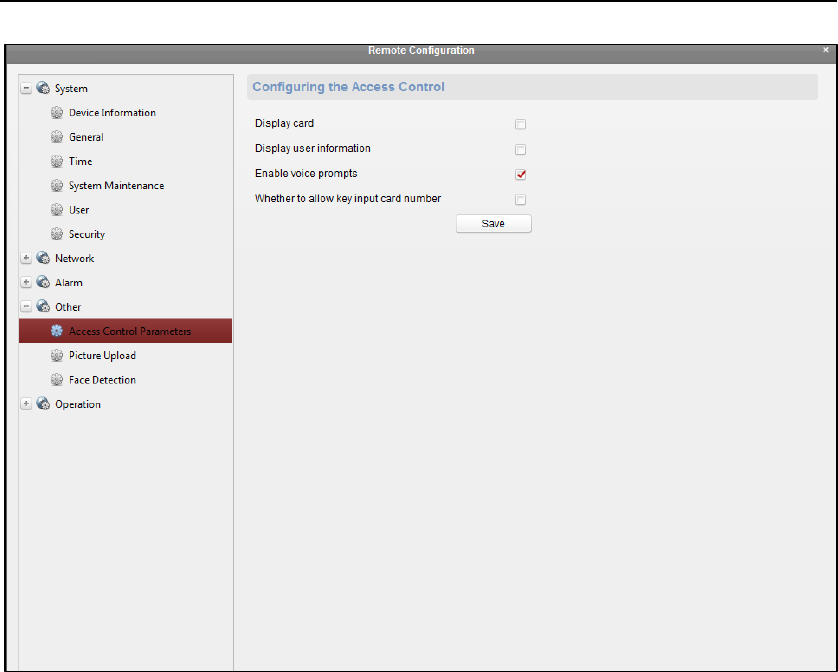
Fingerprint Time Attendance Terminal
51
Attendance Configuration
Purpose:
You are able to remotely configure the device shift, holiday and shift schedule.
Shift Management
You are able to add, delete and edit the shift.
1) Editing Normal Shift
Steps:
1. Click the Shift Group tab to enter the following page.
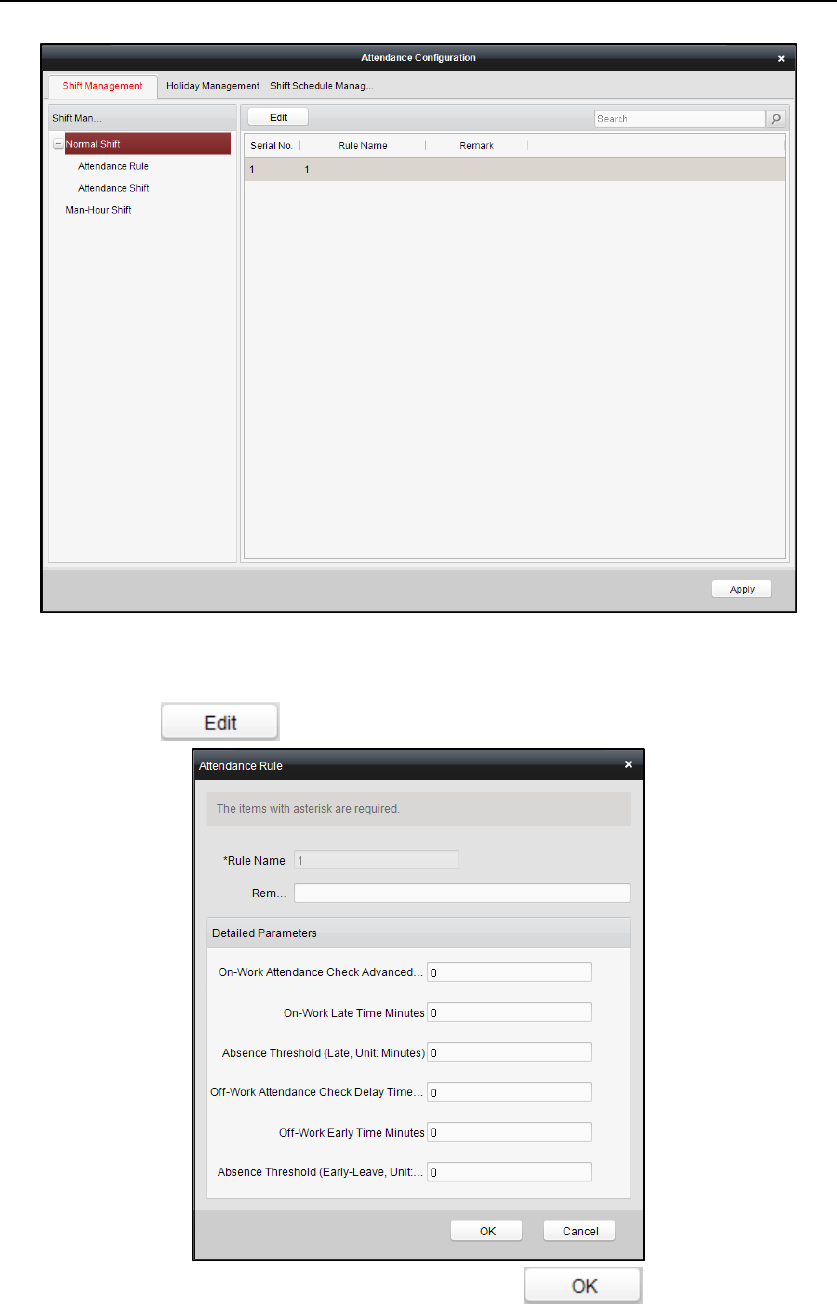
Fingerprint Time Attendance Terminal
52
2. Click Attendance Rule in the Shift Management List, and click the
attendance rule on the right of the interface.
Note: There is one default attendance rule.
3. Click button to pop up the Attendance Rule window.
4. Configure the parameters and click the button to confirm
editing.
5. Click Attendance Shift in the Shift Management list and select a shift on
the right side of the interface.
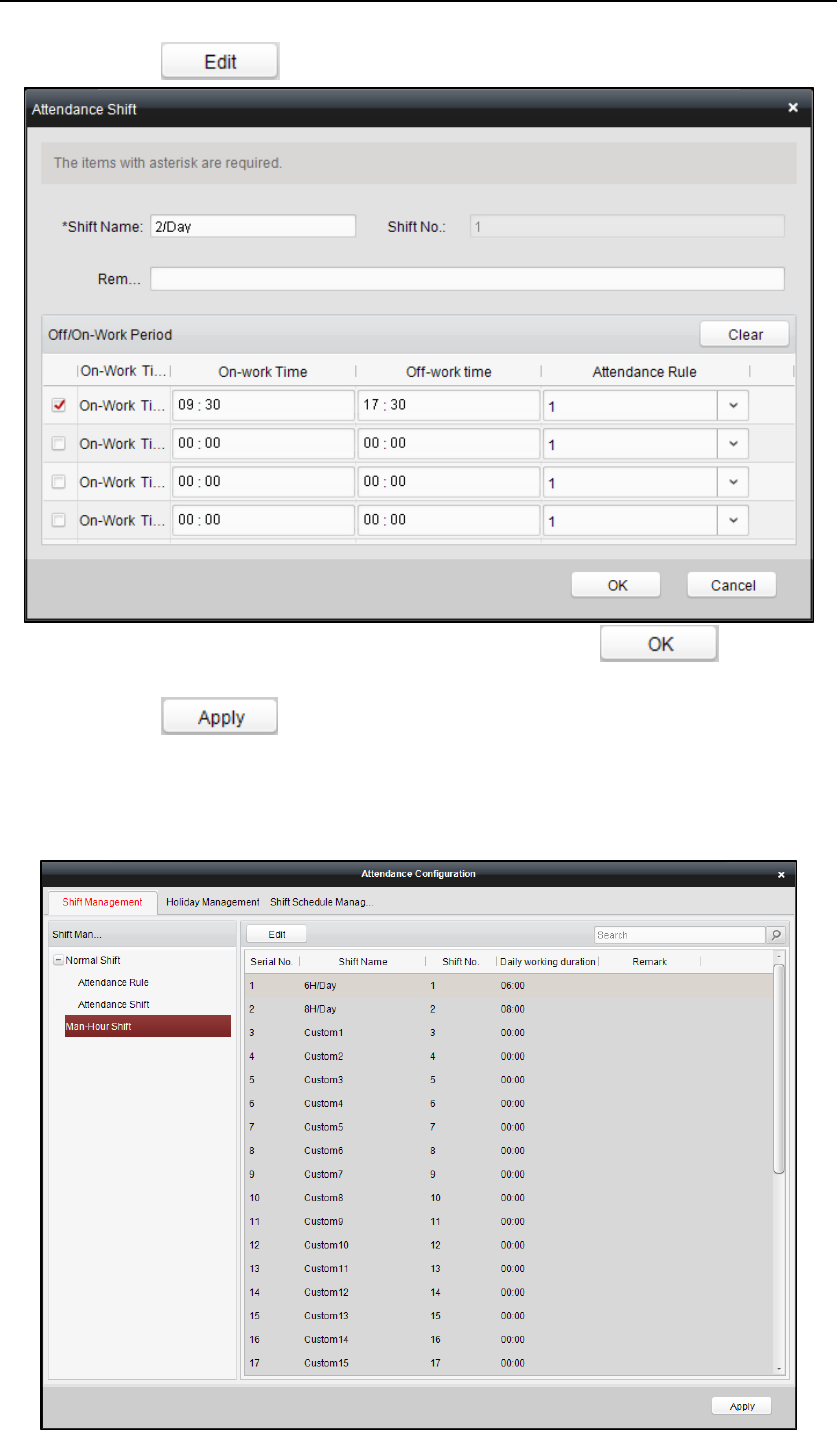
Fingerprint Time Attendance Terminal
53
6. Click to enter the Attendance Shift editing window.
7. Configure the parameters in the window and click to confirm
editing.
8. Click to apply the parameters to the device.
2) Editing Man-Hour Shift
Steps:
1. Click “Man-Hour Shift” in the Shift Management List and click a shift on
the right of the interface.
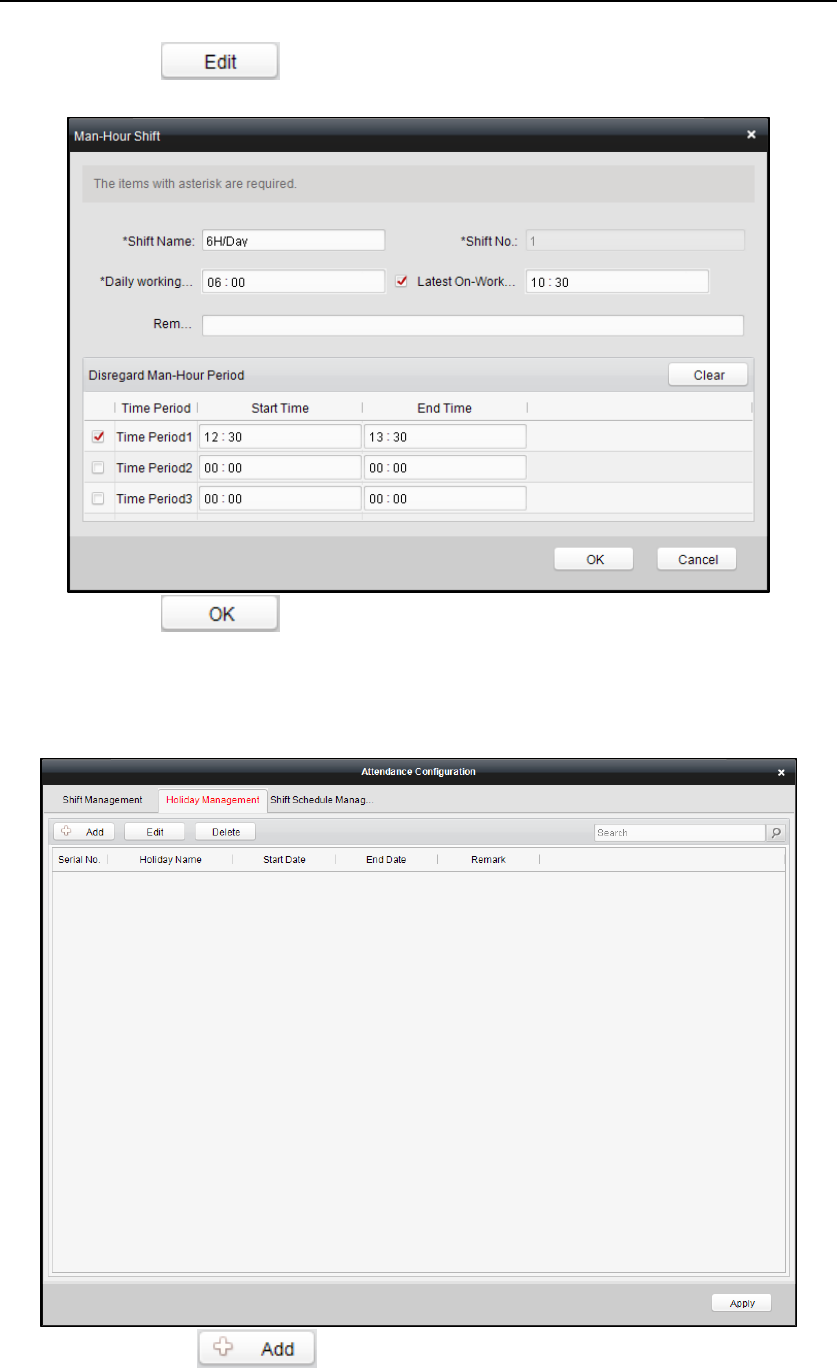
Fingerprint Time Attendance Terminal
54
2. Click .
3. Configure the man-hour shift parameters in the pop-up window.
4. Click to confirm editing.
Holiday Management
Steps:
1. Click Holiday Management to enter the Holiday Management tab.
2. Click to enter the Holiday management window.
3. Edit the holiday name, the holiday start time and the end time.
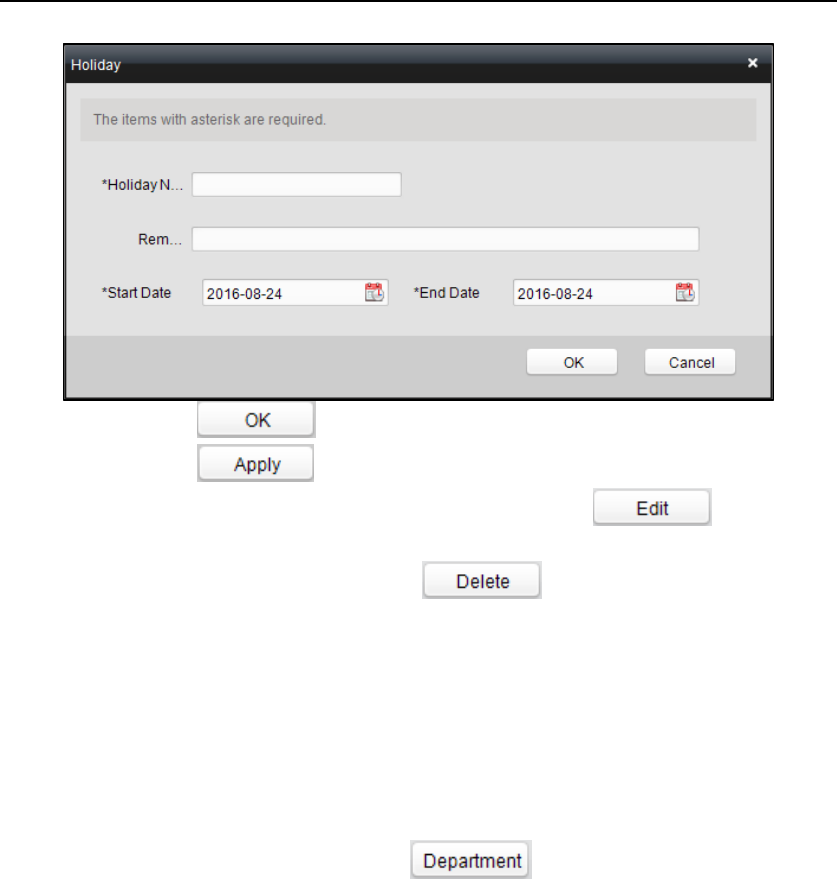
Fingerprint Time Attendance Terminal
55
4. Click to add the holiday.
5. Click to apply the parameters to the device.
Or select a holiday in the holiday list and click to edit the
holiday.
Or select a holiday and click to delete the holiday.
Shift Schedule Management
Schedule by Department
Before you start:
Add department before manage the shift schedule. For details, see
Section 4.3.1 Person Management.
Steps:
1. Click Shift Schedule Management to enter the Shift Schedule
Management tab and click .
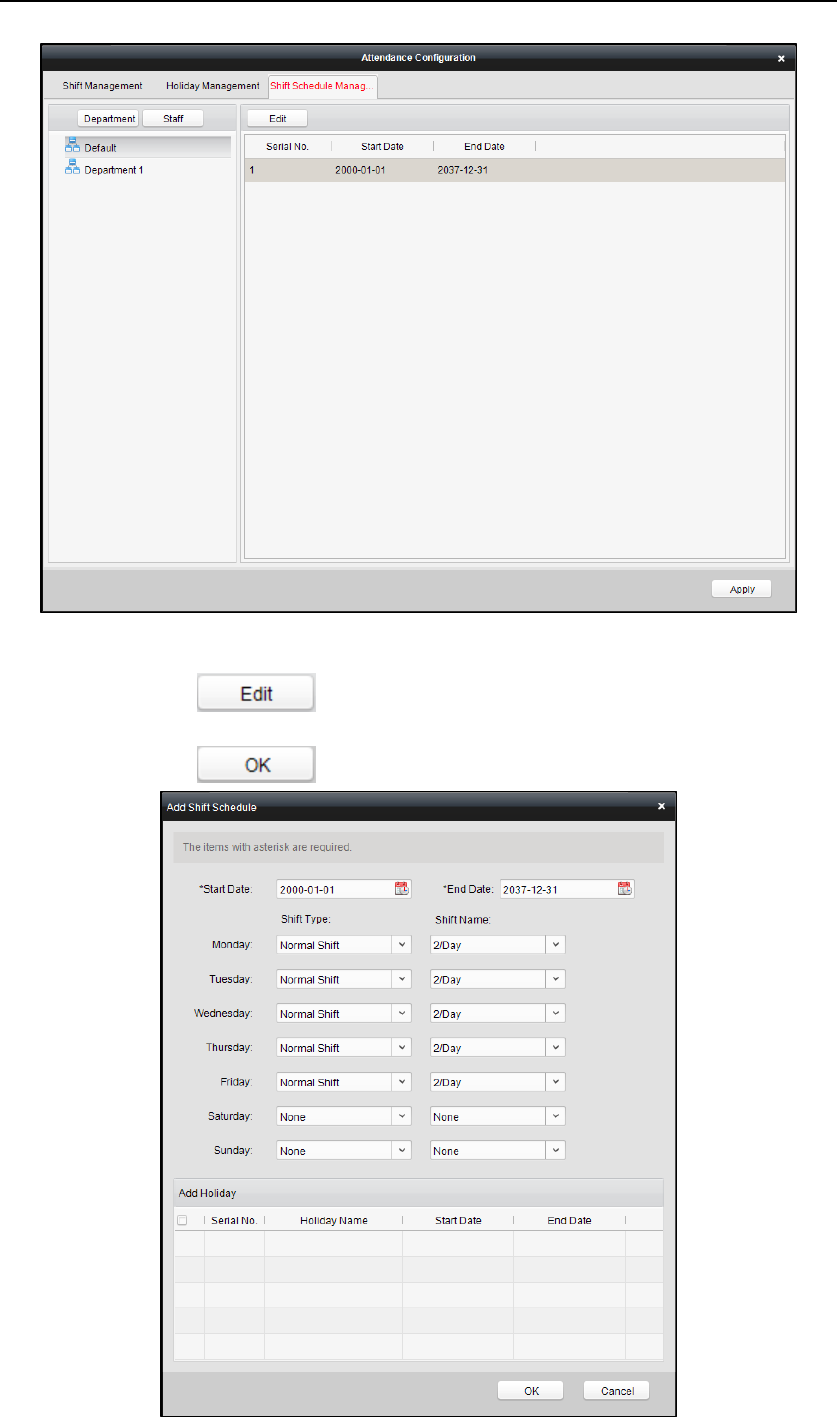
Fingerprint Time Attendance Terminal
56
2. Select a department in the department list and click the default shift
on the right of the interface.
3. Click and configure the shift schedule parameters in the
pop-up window.
4. Click to confirm editing.
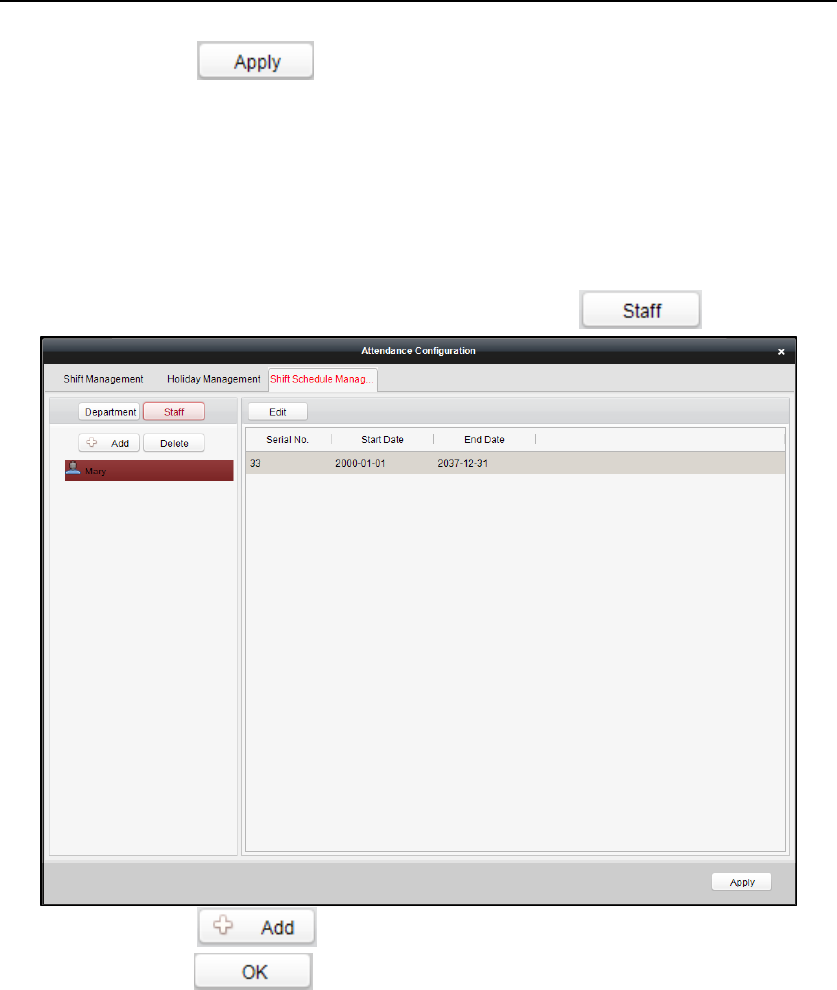
Fingerprint Time Attendance Terminal
57
5. Click , and apply permissions in the permission
management to apply configurations to the device. For details, see
Section 4.3 Permission Management.
Schedule by Person
Before you start:
Add persons in the Person Management before you scheduling by person.
Steps:
1. In the Shift Schedule Management tab, click .
2. Click and select the person in the pop-up window and
click .
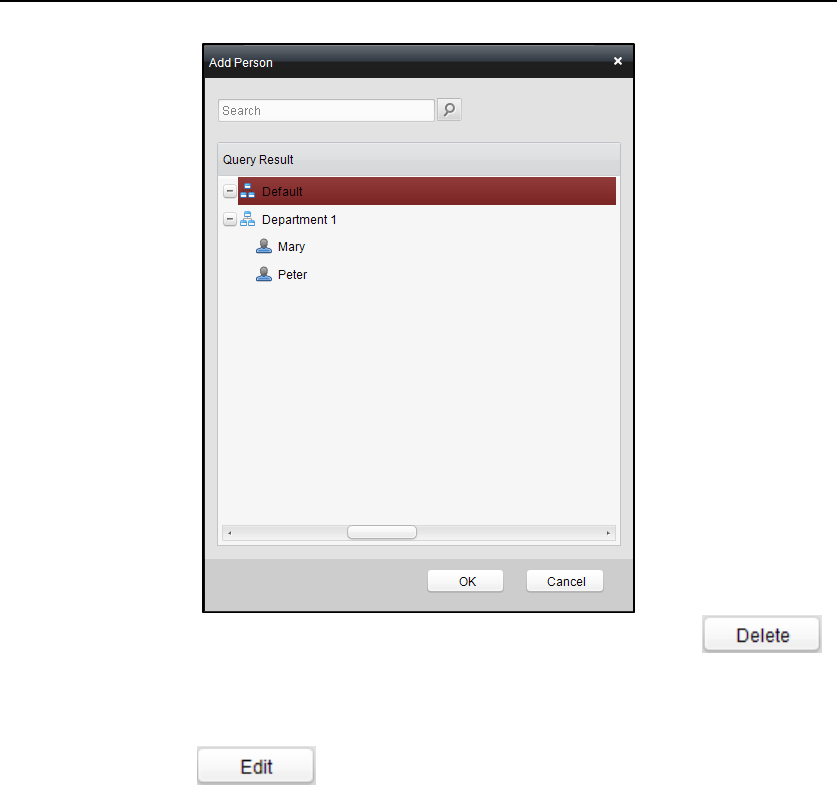
Fingerprint Time Attendance Terminal
58
You can also select the person in the person list and click
to delete the person.
3. Select the person in the person list and select the default schedule on
the right of the interface.
4. Click and configure the parameters in the pop-up
window.
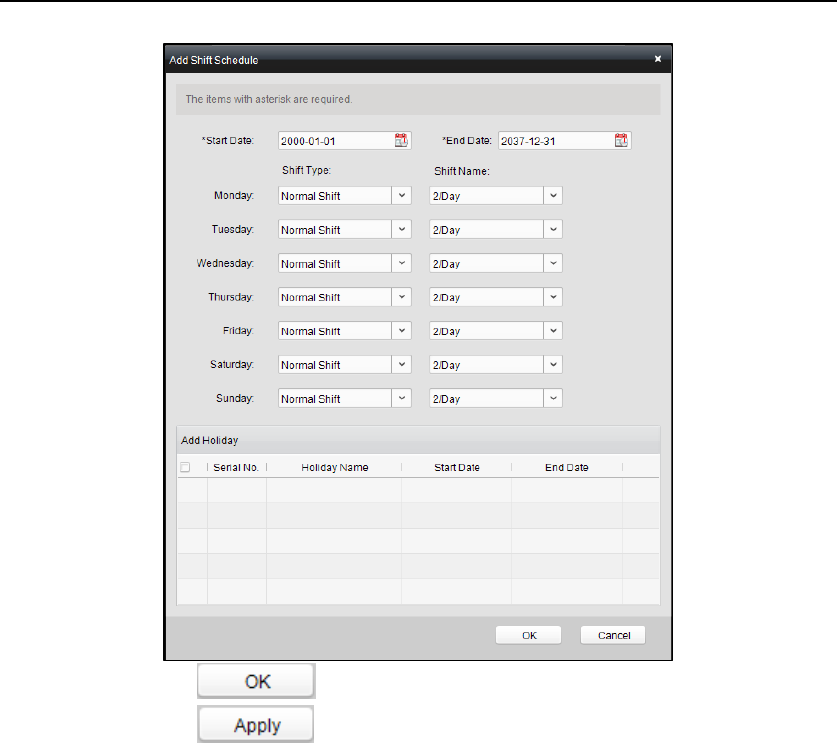
Fingerprint Time Attendance Terminal
59
5. Click to confirm editing.
6. Click , and apply permissions in the permission
management to apply configurations to the device. For details, see
Section 4.3 Permission Management.
Setting Wiegand
Purpose:
You can set the Wiegand channel and the communication mode.
Steps:
1. In the Edit Access Controller interface, click the Wiegand Settings button to enter
the Wiegand Settings interface.
2. Select the Wiegand channel and the communication mode in the dropdown list.
3. Click OK to save the settings.
Notes:
After changing the communication direction, the device will be rebooted.
A prompt will be pop-up after changing the communication direction.
The attendance device does not support the function.
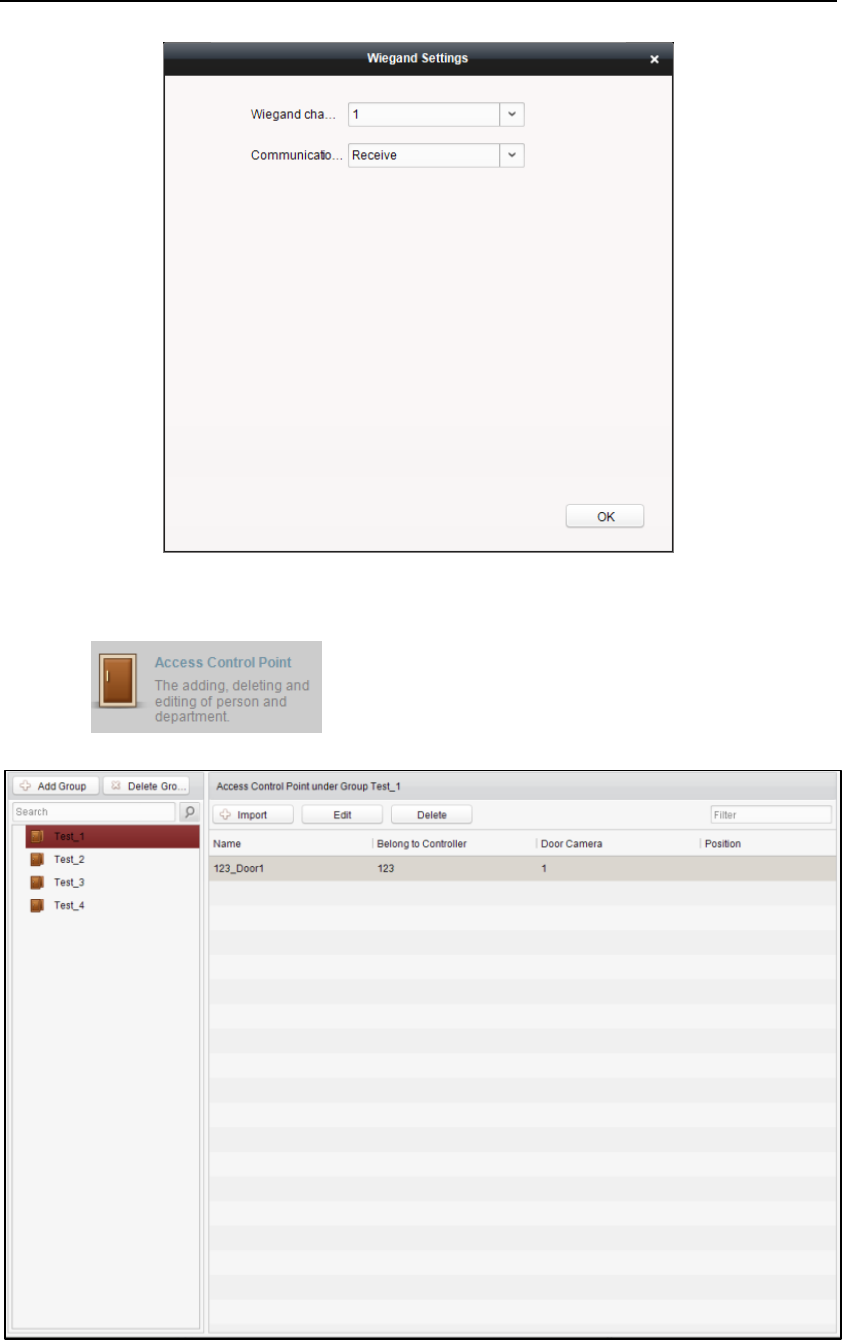
Fingerprint Time Attendance Terminal
60
4.2.2 Access Control Point Management
Click the icon on the control panel to enter the door
management interface.
Group Management
The doors can be added to different groups to realize the centralized management.
Door Management
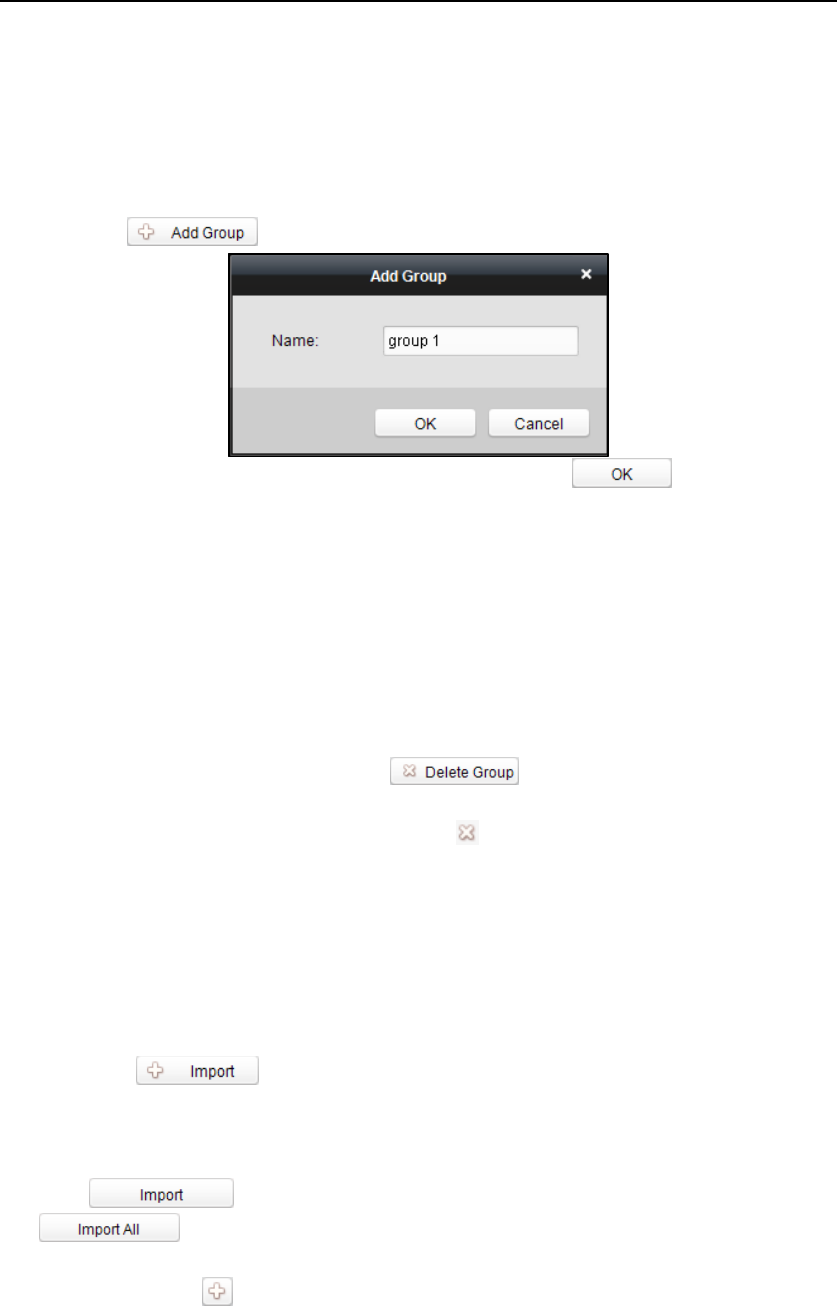
Fingerprint Time Attendance Terminal
61
Manage the specific door under the door group, including importing, editing and
deleting door.
Group Management
Adding Group
Steps:
1. Click the button to pop up the Add Group dialog.
2. Input the group name in the text field and click the button to finish
adding.
Note: Multi-level groups are not supported yet.
Editing Group
Steps:
Double-click the group or right-click the group and select Edit in the right-click menu.
Deleting Group
To delete a group, three ways are supported.
Click to select a group and click the button.
Right-click a group and select Delete in the popup menu.
Move the mouse onto the group and click icon of it.
And then click the OK button in the popup window.
Access Control Point Management
Access control points under the group can also be edited, refer to the following
instructions.
Importing Access Control Point
Steps:
1. Click the button to pop up the access control point importing
interface.
2. Select a access control point to import by clicking it.
3. Click to select a group in the right side bar to import to.
4. Click button to import the selected access control points or click
to import all the available access control points.
Notes:
You can click button on the upper-right corner of the window to create a
new group.
The control client can manage 16 access control points at most.
Editing Access Control Point
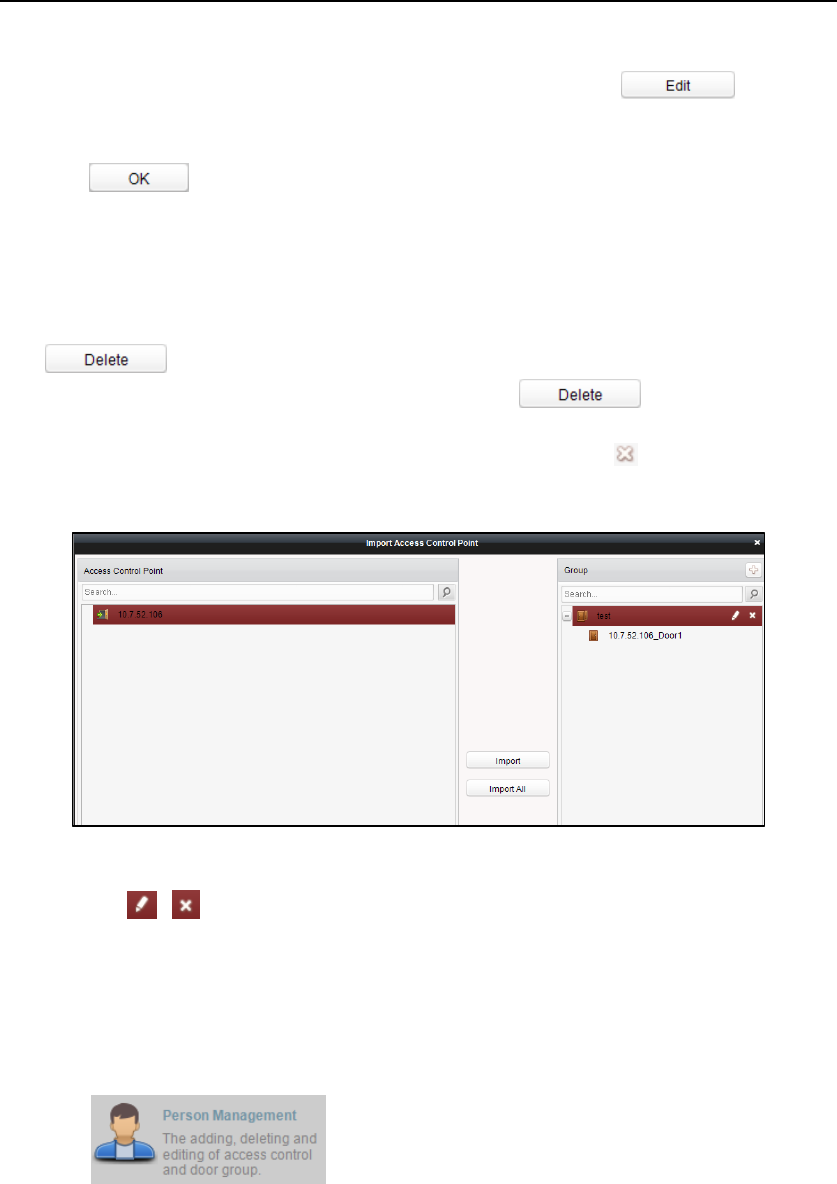
Fingerprint Time Attendance Terminal
62
Steps:
1. Click to select a access control point in the list and click the button to
edit the access control point.
2. Edit the Door Name and Position.
3. Click button to finish editing.
Note: you can also enter the Edit interface by double clicking the door from the list.
Deleting Access Control Point
Several ways are supported to delete the access control point, as shown below.
Click to select a group in the group list, select door(s) under it, and click
button.
Click to select a group in the group list, and click button to delete all
access control points under the group.
Move the mouse onto a group in the group list, and click button to delete all
access control points under the group.
Note: you can also edit/delete a door on the Import Access Control Point panel.
Steps:
1. Select a control point on the Group panel.
2. Click the / icon to enter the Edit Access Control Point panel or to delete the
control point.
4.3 Permission Management
4.3.1 Person Management
Click the icon on the control panel of the software.
Adding, editing, deleting and filtering of the department and person are supported in
this interface.

Fingerprint Time Attendance Terminal
63
Department Management
Steps:
1. In the department list, click button to pop up the adding
department interface.
Notes:
Multi-level department system can be created. Click a department as the
upper-level deparment and click button, and then the added
department will be the sub-department of it.
Up to 10 levels can be created.
2. You can double-click an added department to edit its name.
3. You can click to select a department, and click the button to delete
it.
Notes:
The lower-level departments will be deleted as well if you delete a
department.
Make sure there is no person added under the department, or the
department cannot be deleted.
Person Management
Note: In the person management interface, double-click the person name or click the
Edit button to edit the person informationt
In the person management interface, click the Delete button to delete the person.
Up to 2000 persons ban be added.
Inputting General Information
Steps:
1. Select a department in the list and click the in the person
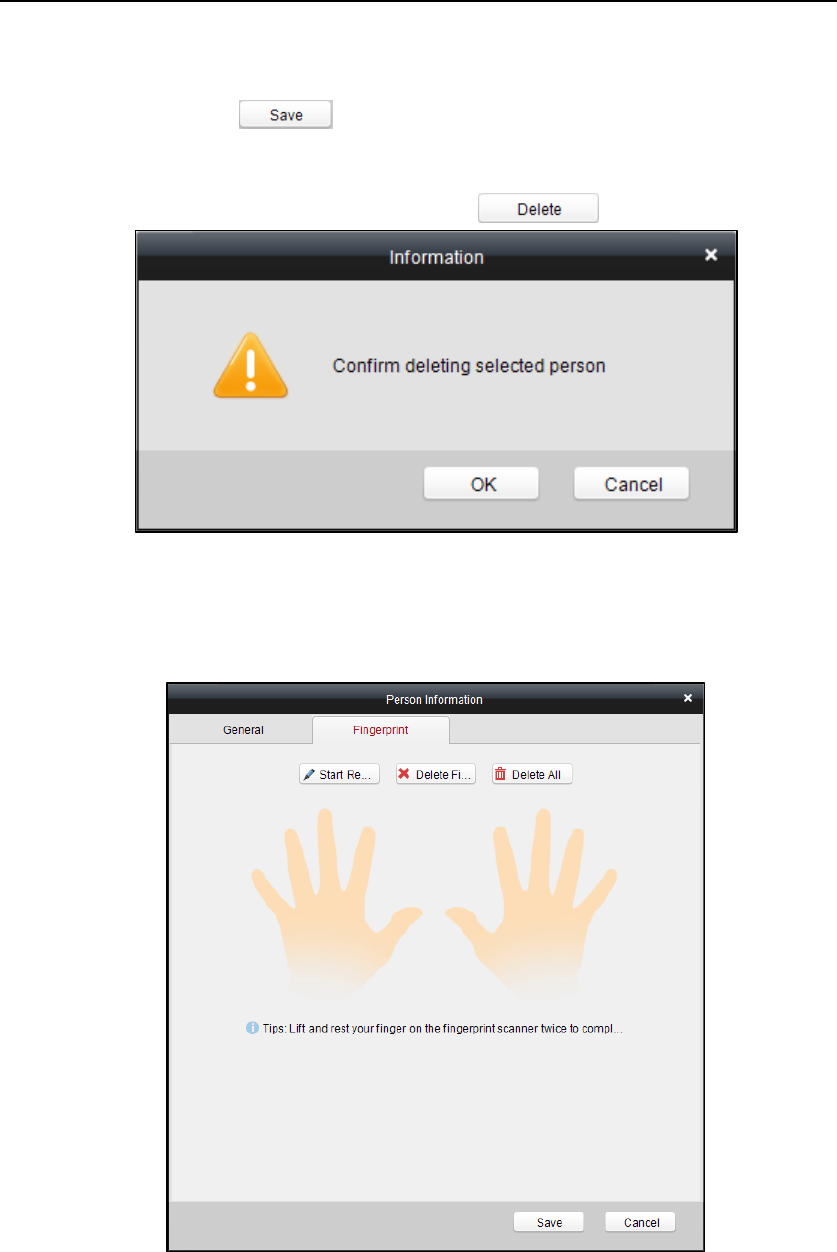
Fingerprint Time Attendance Terminal
64
infoarmation list to pop up the adding person interface.
2. Input the Person Name (required), Gender, ID Card, etc., upload the photo of the
person and click the icon to finish adding.
Note: The format of the photo should be .jpg, or .jpeg.
3. You can double-click an added person to edit its information.
4. You can click to select a person, and click the button to delete it.
If a card is associated with the current person, the association will be invalid after
the person is deleted.
Inputting Fingerprint
Steps:
1. In the personal information interface, click the Fingerprint button.
2. Click the Start Register button, and select the fingerprint to be input.
3. Click the Save button to save the parameter.
Note: Click the Delete Fingerprint button to delete the fingerprint.
Click the Delete All button to clear all fingerprints input.
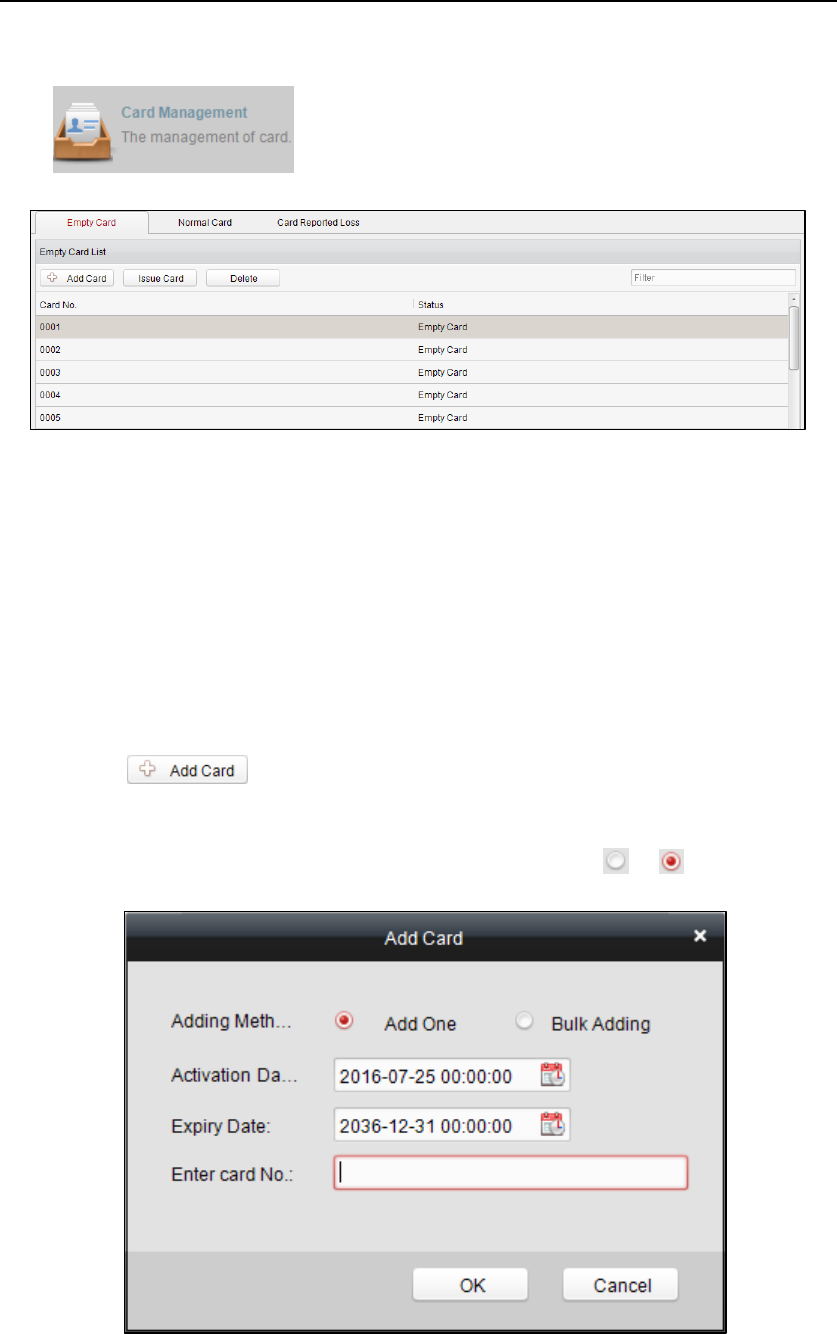
Fingerprint Time Attendance Terminal
65
4.3.2 Card Management
Click on the control panel of the software to enter the card
management interface.
The cards are divided into 3 types: Blank Card, Normal Card, and Lost Card.
Blank Card: A card has not been issued with a person.
Normal Card: A card is issued with a person and is under normal using.
Lost Card: A card is issued with a person and is reported as lost.
Blank Card
Adding Card
Before you start:
Make sure a card dispenser is connected to the PC and is configured already. Refer to
the section of Card Dispenser Configuration for details.
Steps:
1. Click the button to add cards.
2. Two modes of adding cards are supported.
Adding Single Card
Choose the Single Add as the adding mode by clicking the to and input the
Start Date, Expiring Date and Card No. in the text field.
Batch Adding Cards
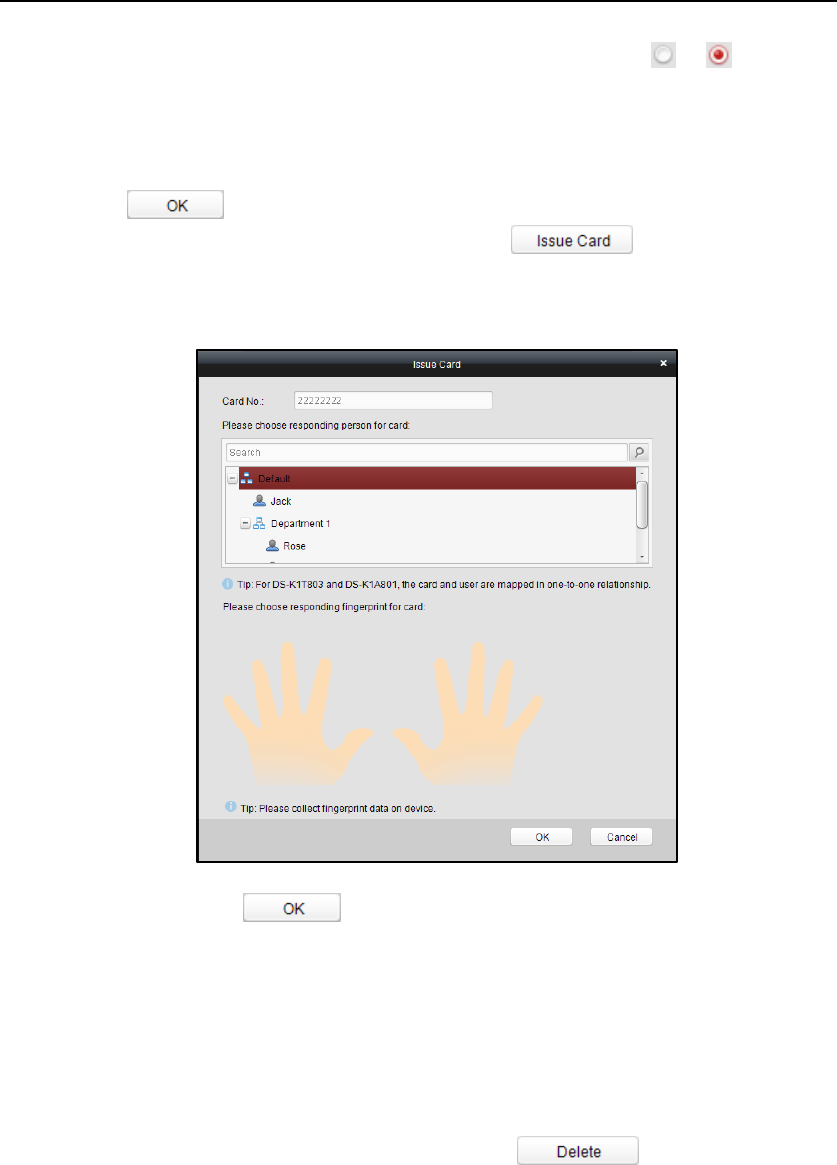
Fingerprint Time Attendance Terminal
66
Choose the Bulking Adding as the adding mode by clicking the to and input
the activation date, expiry date, start card No. and last card No. in the
corresponding text fields.
Note: The start card No. and the last card No. should be the with same length.
E.g., the last card No. is 234, then the start card No. should be like 028.
3. Click the button to finish adding.
4. Click an added blank card in the list and click button to issue the
card with a person.
Note: you can double click the blank card in the card list to enter the Issue Card
Page.
5. Click to choose a person on your demand in the popup dialog box, select a
fingerprint, and click to finish.
Notes:
The issued card will disappear from the Blank Card list, you can check the
card information in the Normal Card list.
Up to 2000 cards can be added.
For the DS-K1A801 device and the DS-K1T803 device, the card and the user
are mapped in one-to-one relationship.
Deleting Card
You can click an added blank card in the list and click button to delete
the selected card.
Normal Card
Click the Normal tab in the card managemet interface to show the Normal Card list.
You can view all the issued card information, including card No., card holder, and the
department of the card holder.
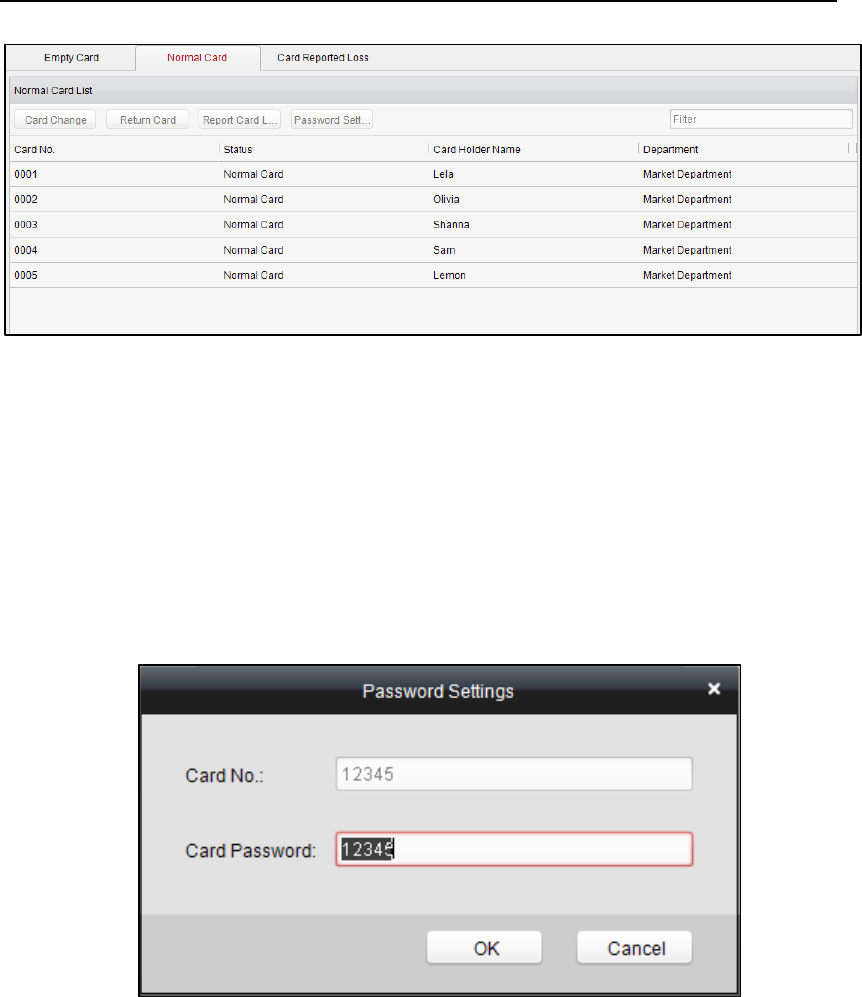
Fingerprint Time Attendance Terminal
67
Click to select a card and click the Card Change button to change the associated
card for card holder. Select another card in the popup window to replace the
current card.
Click to select an issued card and click the Return Card button to cancel the
assotiation of the card, then the card will disappear from the Normal Card list,
which you can find it in the Blank Card list.
Click to select an issued card and click the Report Card Loss button to set the
card as the Lost Card, that is, an invalid card.
Click to select an issued card and click the Password Settings button to set the
password for the card, set the password in the text filed and click the OK button
to finish setting.
Note: The password will be required when the card holder swiping the card to get
enter to or exit from the door if you enable the card&password authentication on
the advanced configuration page.
Lost Card
Click the Card Reported Loss tab in the card managemet interface to show the Lost
Card list. You can view all the lost card information, including card No., card holder,
and the department of the card holder.
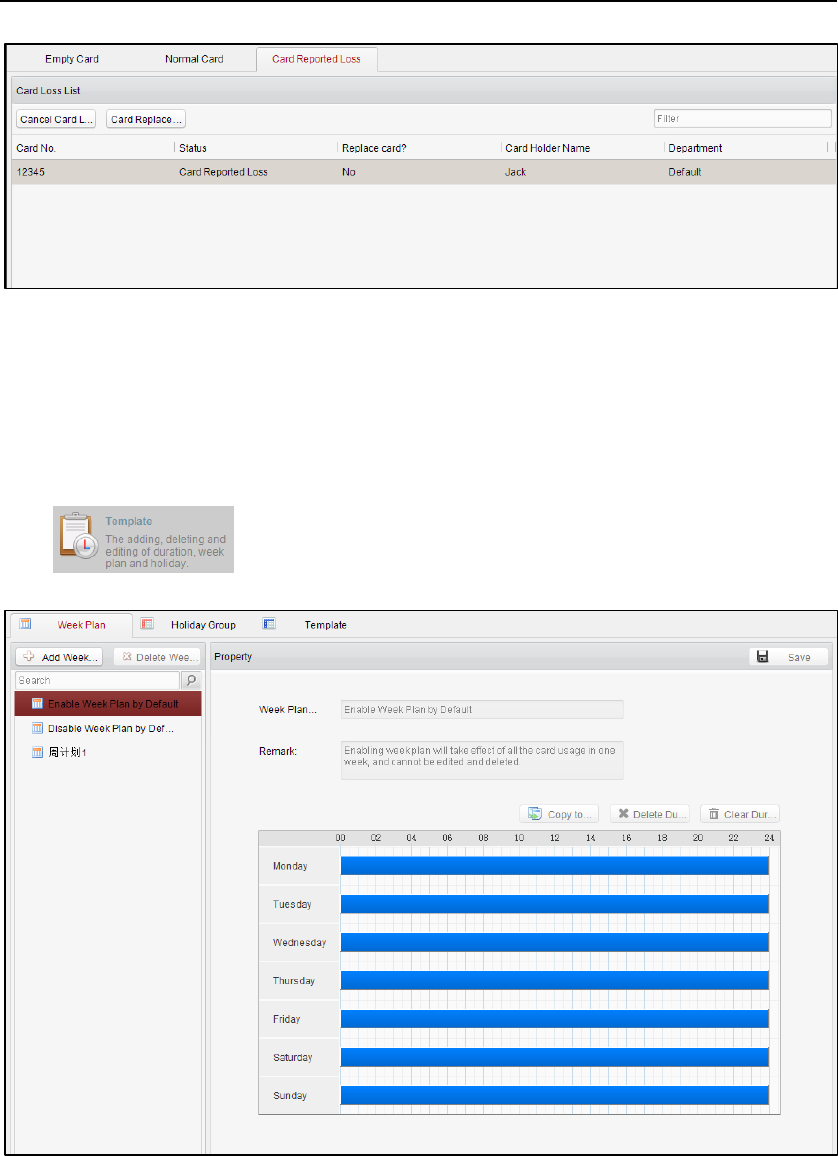
Fingerprint Time Attendance Terminal
68
Click the Cancel Card Loss button to resume the card to the normal card.
Click the Card Replacement button to issue a new card to the card holder
replacing for the lost card. Select another card in the popup window as the new
card and the predefined permissions of the lost card will be copied to the new
one automatically.
4.3.3 Schedule Template
Click on the control panel of the software to enter the schedule
template interface.
There are 3 settings in this interface: Week Plan, Holiday Plan, and Template.
Setting Week Plan
Adding Week Plan
System defines 2 kinds of week plan by default, Enable Week Plan by Default and
Disable Week Plan by Default. You can define custom plans on your demand.
Steps:
1. Click the Add Week Plan button to pop up the adding plan interface.
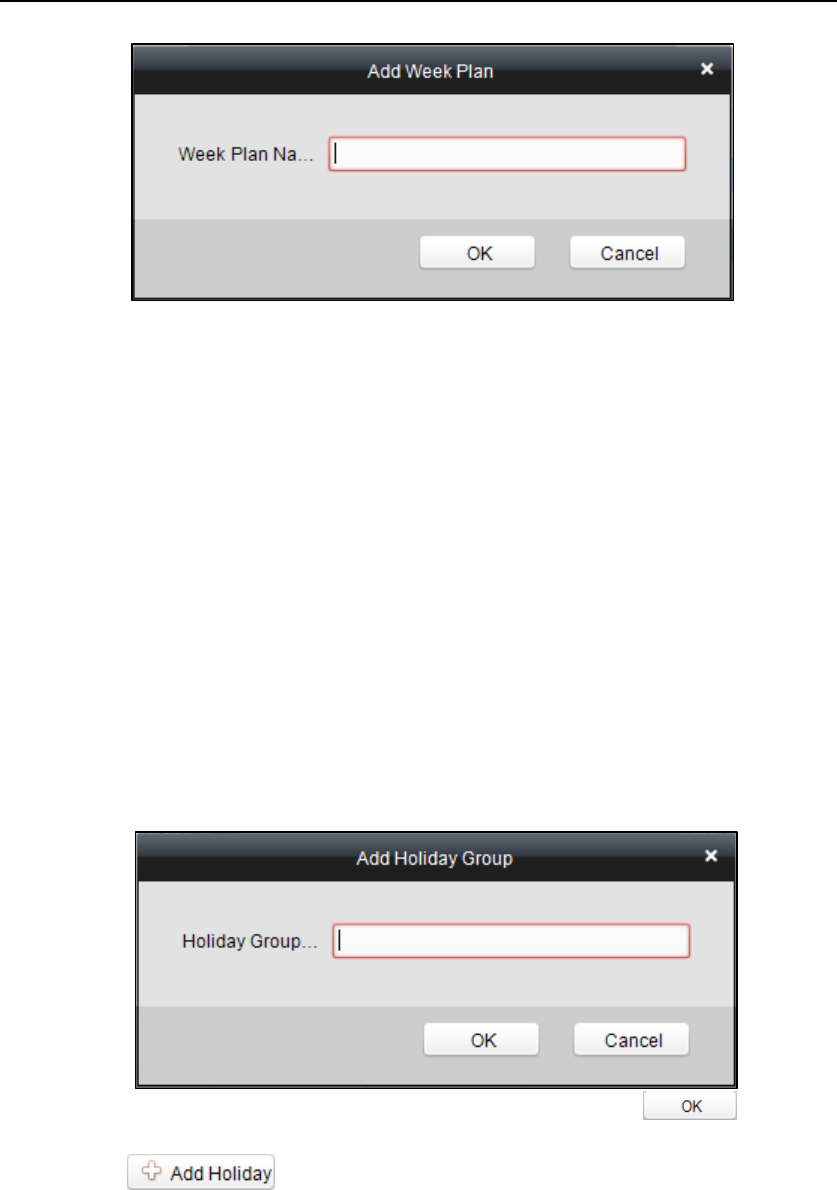
Fingerprint Time Attendance Terminal
69
2. Input the name of week plan and click the OK button to add the week plan.
3. Select a week plan in the plan list on the left-side of the window to edit.
4. Click and drag your mouse on a day to draw a blue bar on the schedule, which
means in that period of time, the cofigured permission is activated.
5. Repeat the above step to configure other time periods.
Or you can select a configured day and click the Copy to Week button to copy the
same settings to the whole week.
Deleting Week Plan
Click to select a configured duration and click the Delete Duration button to
delete it.
Click the Clear Duration button to clear all the configured durations, while the
week plan still exists.
Click the Delete Week Plan button to delete the week plan directly.
Setting Holiday Group
Adding Holiday Group
Steps:
1. Click the Add Holiday Group button to pop up the adding holiday group interface.
2. Input the name of holiday group in the text filed and click the button to
add the holiday group.
3. Click the icon to add a holiday in the holiday list and configure the
duration of the holiday.
Note:At most 16 holiday periods can be added.
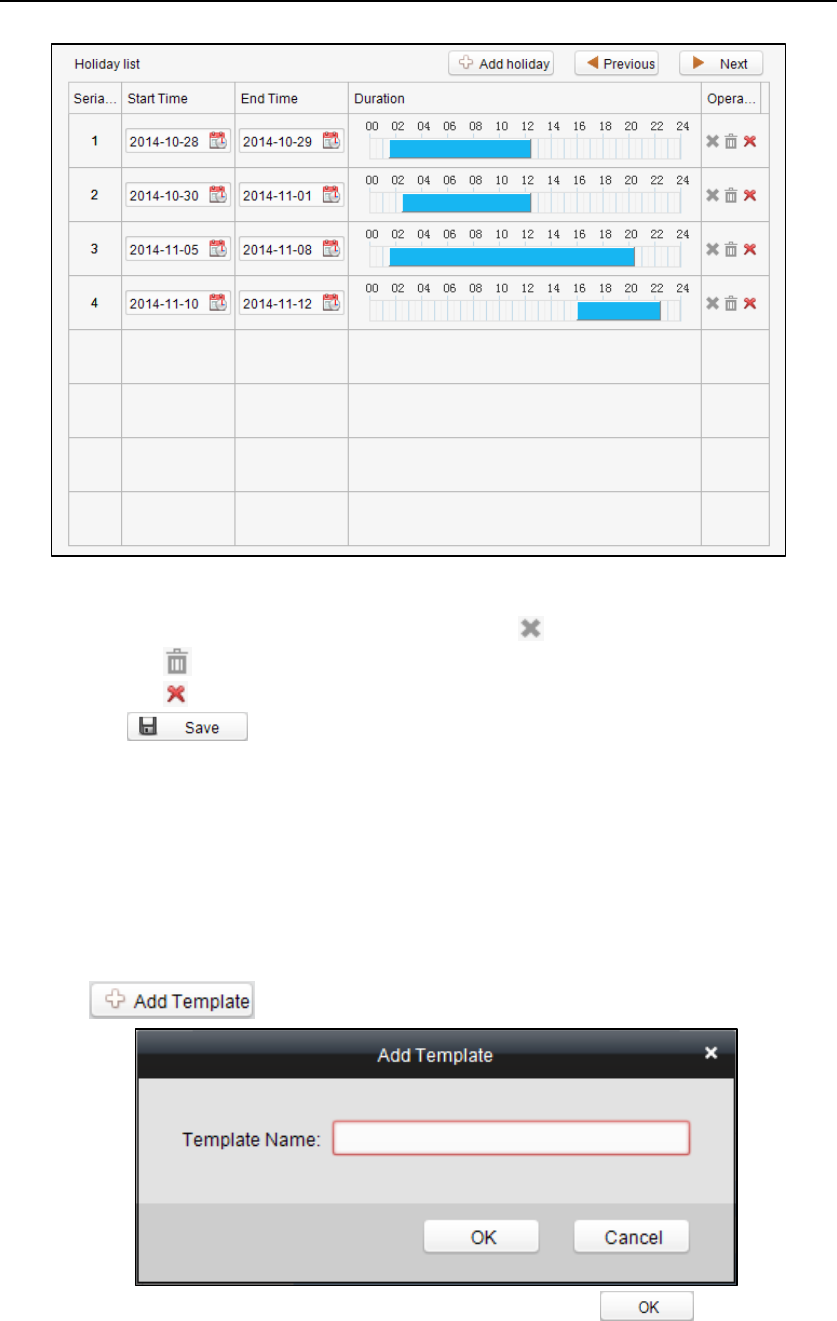
Fingerprint Time Attendance Terminal
70
1) Click and drag your mouse on a day to draw a blue bar on the schedule, which
means in that duration, the cofigured permission is activated.
2) Click to select a configured duration and click to delete it.
3) Click the to clear all the configured durations, while the holiday still exists.
4) Click the to delete the holiday directly.
4. Click the button to save the settings.
Note: The holidays cannot be overlapped with each other.
Setting Schedule Template
The schedule consists of week plan and holiday group; you can only choose which
plan and group to enable in the schedule template configuration interface. Configure
the week plan and holiday group before configuring the schedule template.
Note: The priority of holiday group schedule is higher than the week plan.
Steps:
1. Click to pop up the adding schedule interface.
2. Input the name of schedule in the text filed and click the button to add
the schedule.
3. Select a week plan you want to apply to the schedule.
Click the Week Plan tab and select a plan in the dropdown list.
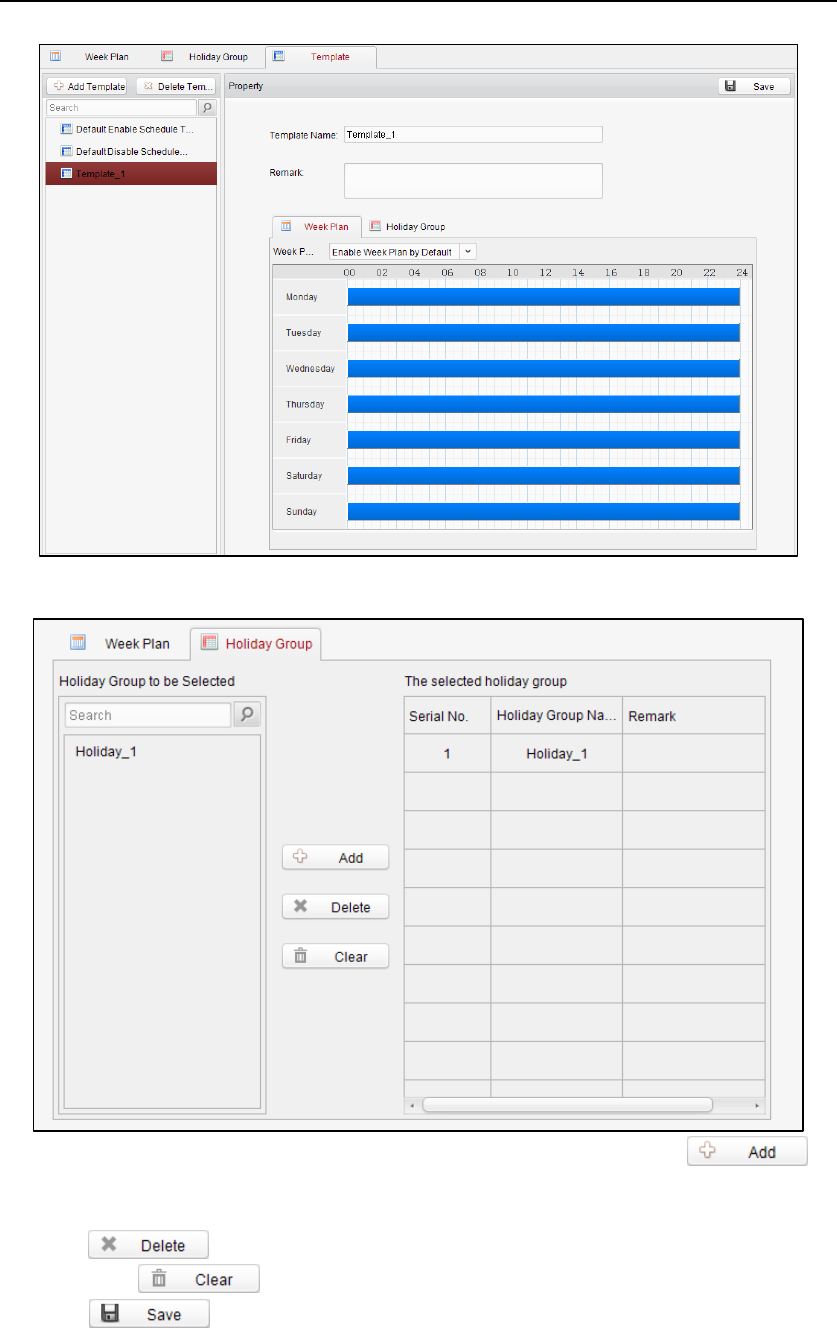
Fingerprint Time Attendance Terminal
71
4. Select holiday groups you want to apply to the schedule.
Note:At most 4 holiday groups can be added.
Click to select a holiday group in the left-side list and click to
add it.
Click to select an added holiday group in the right-side list and click
to delete the it.
Click to delete all the added holiday groups.
5. Click to save the settings.
Note: The attendance device does not support schedule template..
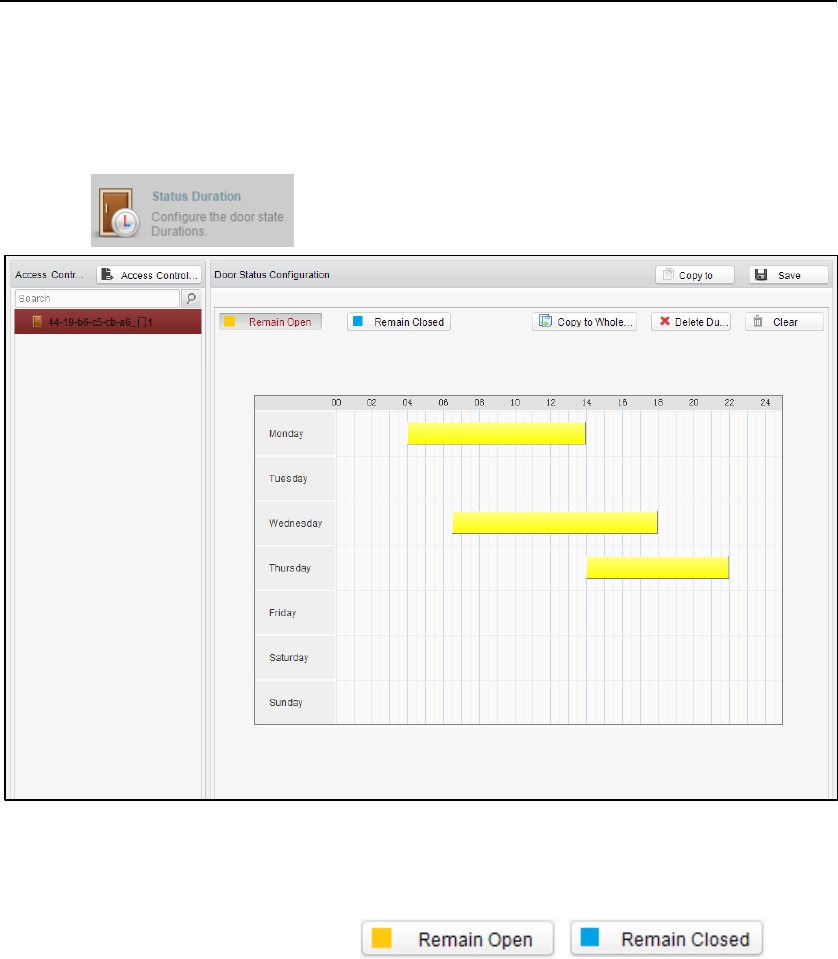
Fingerprint Time Attendance Terminal
72
4.3.4 Door Status Management
Purpose:
The function of Door Status Management allows you to schedule weekly time
periods for a door to remain open or closed.
Click the icon on the control panel to enter the interface.
Steps:
1. Enter the Door Status Management page.
2. Click and select a door from the door list on the left side of the page.
3. Draw a schedule map.
1) Select a door status brush / on the
upper-left side of the Door Status Settings panel.
Remain open: the door will keep open during the configured time period.
The brush is marked as yellow.
Remain Closed: the door will keep closed during the configured duration.
The brush is marked as blue.
2) Click and drag the mouse to draw a color bar on the schedule map to set the
duration.
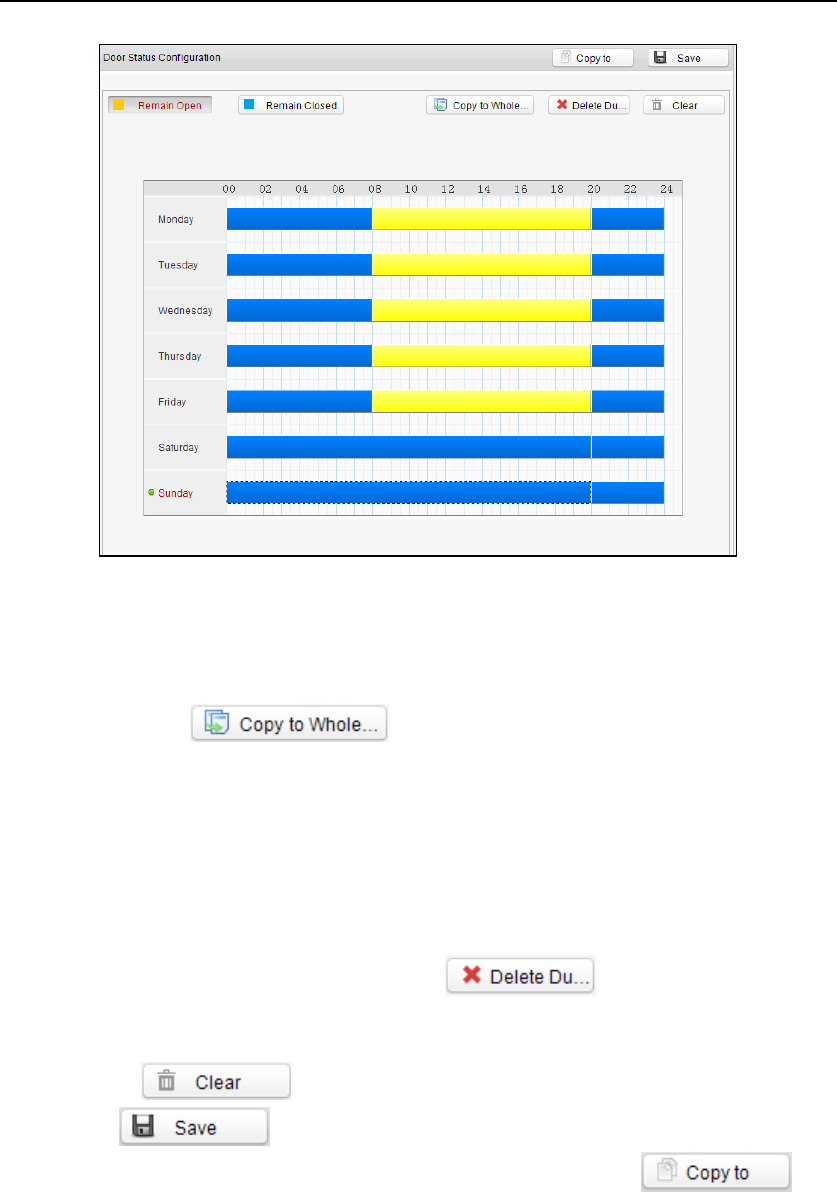
Fingerprint Time Attendance Terminal
73
Notes
The min. segment of the schedule is 30min.
You can copy the configured time periods of a day to the whole week.
Steps:
1. Select a day which has already been configured.
2. Click on to copy the time periods to the whole week.
4. Edit the schedule map.
Edit Duration:
Click and drag the color bar on the schedule map and you can move the bar
on the time track.
Click and drag the mouse on the ends of the color bar and you can adjust
the length of the bar.
Delete a Duration:
Click and select a color bar and click to delete the time
period.
Clear All Durations:
Click to clear all configured durations on the schedule map.
5. Click on to save the settings.
6. You can copy the schedule to other doors by clicking on and
select the required doors.
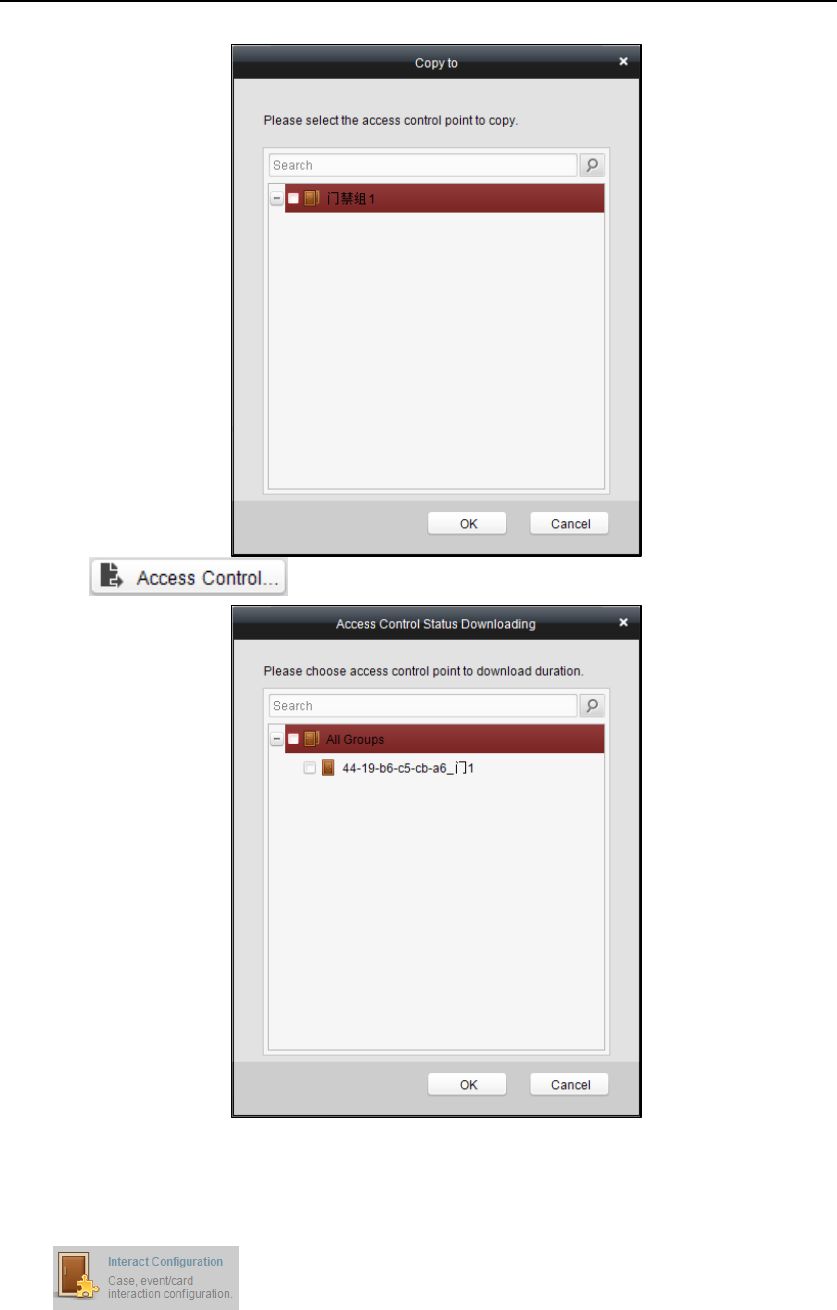
Fingerprint Time Attendance Terminal
74
7. Click to enter the Download Door State page.
8. Select a control point and click OK to download the settings to the system.
Note: The attendance device does not support the function.
4.3.5 Interact Configuration
Click on the control panel of the software to enter the interact
configuration interface.
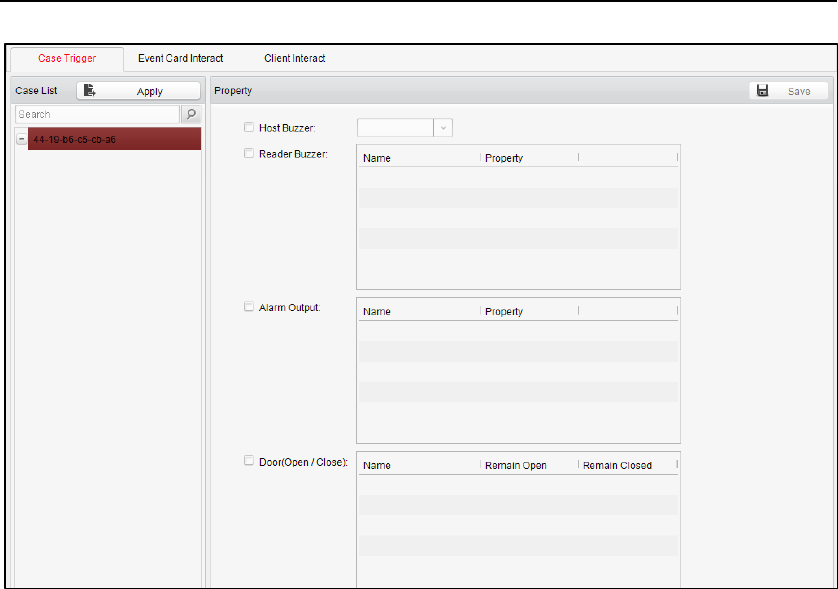
Fingerprint Time Attendance Terminal
75
In this interface, you can set alarm linkage modes of the access host, including case
trigger, event card interact, and client interact.
Case Trigger
Purpose:
The case (refer to the triggers of the controller) can be linked to some actions (e.g.,
alarm output, host buzzer) when it is triggered.
Steps:
1. Click the Case Trigger tab to enter the case trigger interface, and select a case.
2. Check the checkbox of the corresponding linkage actions and set the property as
Trigger to enable this function.
Host Buzzer: The audible warning of controller will be triggered.
Reader Buzzer: The audible warning of card reader will be triggered.
Alarm Output: The alarm output will be triggered for notification.
Door (Open/Close): The door will be open or closed when the case is triggered.
3. Click the Save button.
4. Click the Apply button to take effect of the new settings.
Note: The Door cannot be configured as open or closed at the same time.
Event Card Interact
In the Interact Configuration interface, click the Event Card Interact button to enter
the settings interface.
Event Linkage
In the Event Interact interface, the linkage alarm action, after triggering alarm event,
can be set. The alarm event can be divided into four types: event device, event input
alarm, door event, and card reader event.
Steps:
1. Click the Event Card Interact tab to enter the event card interface
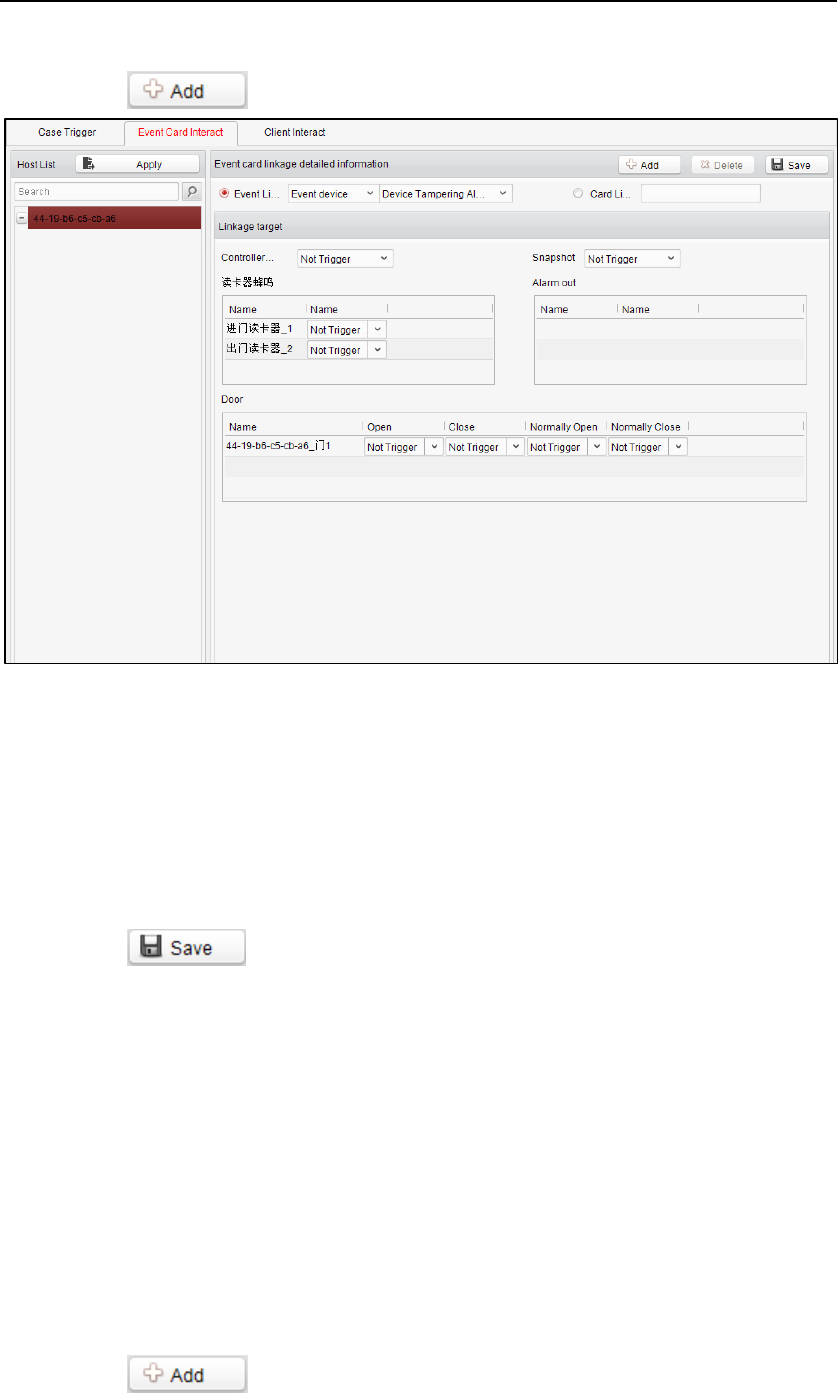
Fingerprint Time Attendance Terminal
76
2. Select the host to be set from the host list.
3. Click the button to start setting the event linkage.
4. Click the radio button of the event linkage, and select the event type from the
dropdown list.
5. Set the linkage target, and set the property as Trigger to enable this function.
Host Buzzer: The audible warning of controller will be triggered.
Snapshot: The real-time capture will be triggered.
Reader Buzzer: The audible warning of card reader will be triggered.
Alarm Output: The alarm output will be triggered for notification.
Door: The door status of open, close, normally open, and normally close will be
triggered.
6. Click the button to save parameters.
7. Click the Apply button to download the updated parameters to the local memory
of the device.
Notes:
The door status of open, close, normally open, and normally close cannot be
triggered at the same time.
The attendance device does not support opening door, closing door and
capturing.
Card Linkage
In the Event Interact interface, the linkage alarm action, after triggering the card
number, can be set.
Steps:
1. Click the Card Event Interact tab to enter the event card interface
2. Select the host to be set from the host list.
3. Click the button to start setting the event linkage.
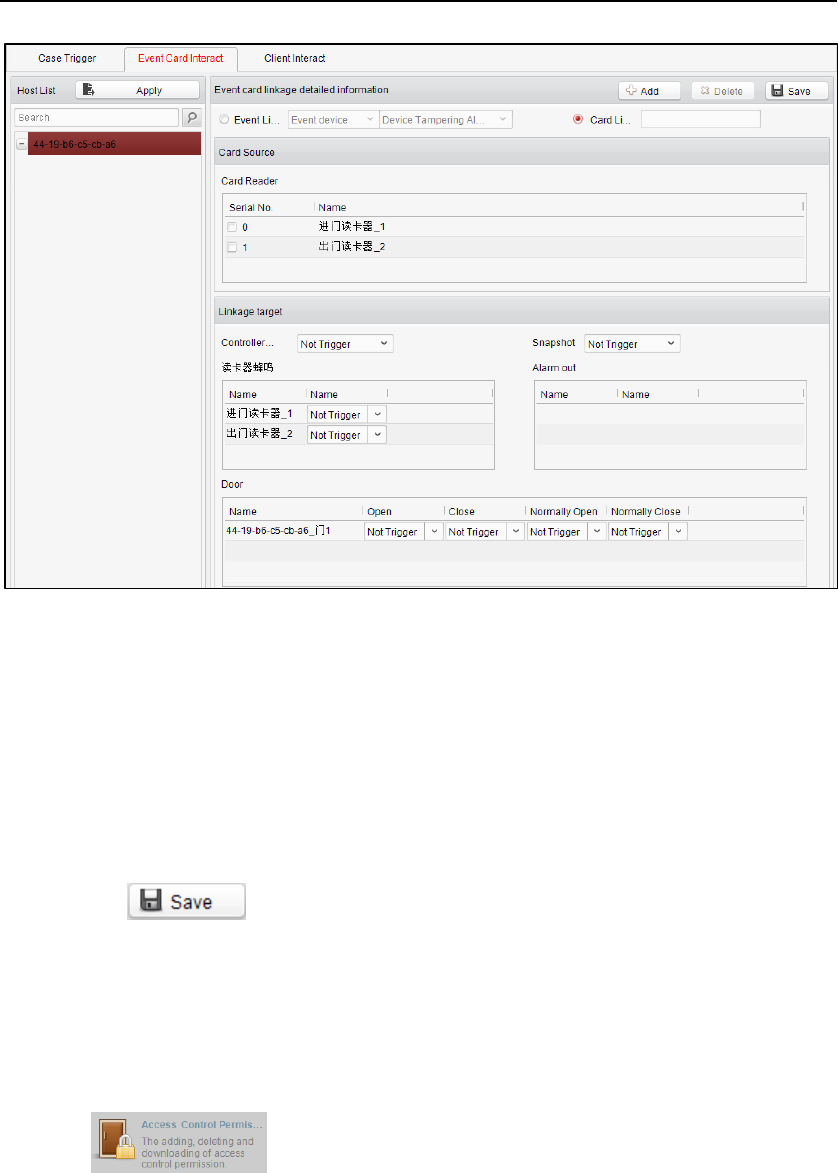
Fingerprint Time Attendance Terminal
77
4. Click the radio button of card linkage, and input the card number.
5. Select the event source, and check the checkbox of the card reader’s serial
number.
6. Set the linkage target, and set the property as Trigger to enable this function.
Controller Buzzer: The audible warning of controller will be triggered.
Snapshot: The real-time capture will be triggered.
Reader Buzzer: The audible warning of card reader will be triggered.
Alarm Output: The alarm output will be triggered for notification.
Door: The door status of open, close, normally open, and normally close will be
triggered.
7. Click the button to save parameters.
8. Click the Apply button to download the updated parameters to the local memory
of the device.
Note: The door status of open, close, normally open, and normally close cannot be
triggered at the same time.
4.3.6 Access Permission Configuration
Click the icon on the control panel to enter the interface.
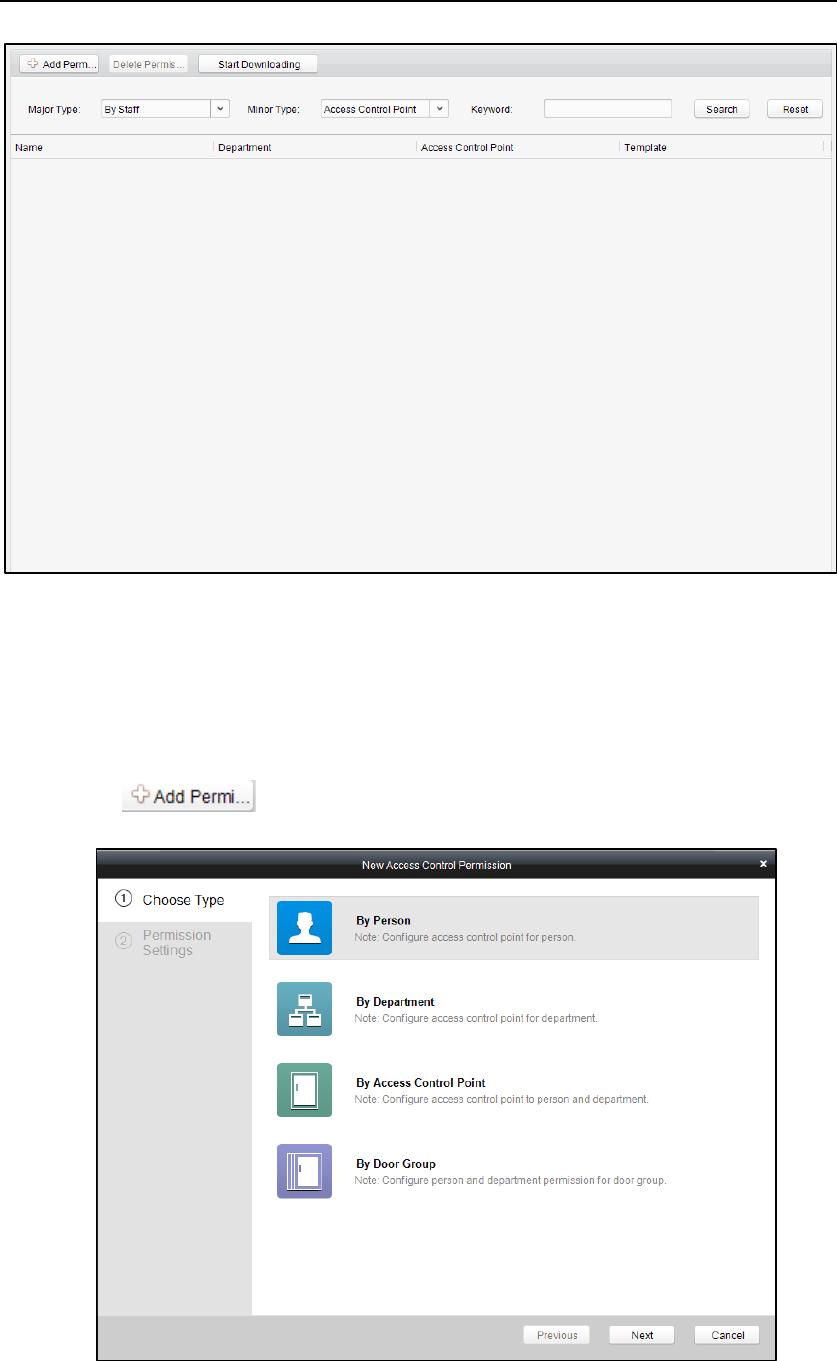
Fingerprint Time Attendance Terminal
78
Access Permission Settings
Purpose:
You can allocate permission for people/department to enter/exist the control points
(doors) in this section.
Steps:
1. Enter the Permission page.
2. Click on icon on the upper-left side of the page to enter the Add
Permission page.
3. Select an adding type in the Select Type interface.
By Person: you can select people from the list to enter/exit the door.
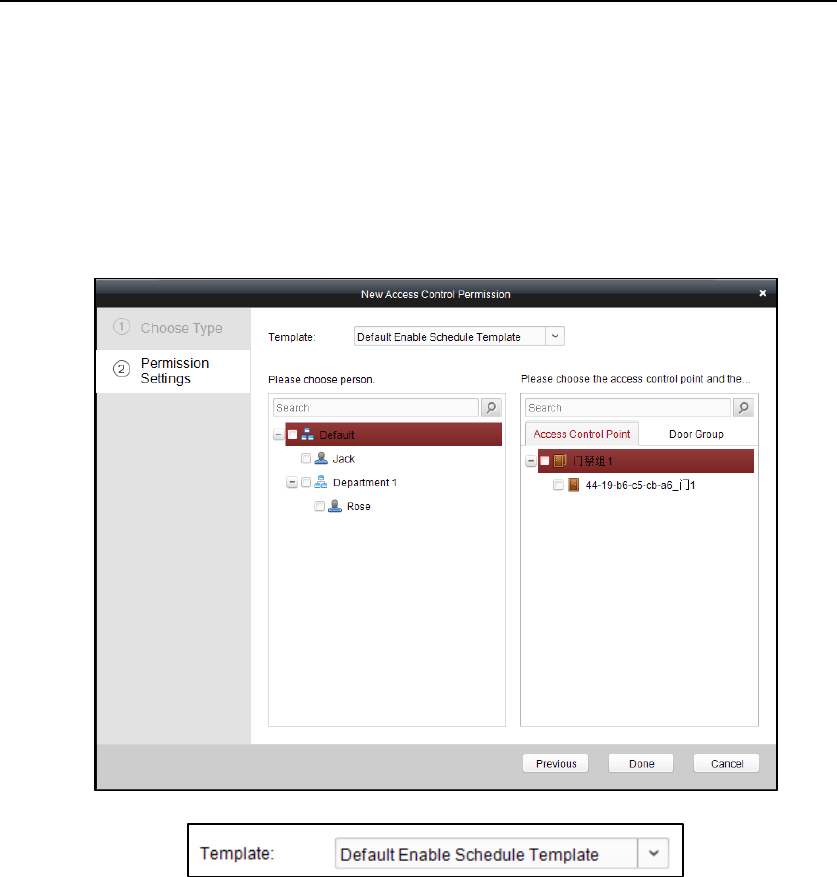
Fingerprint Time Attendance Terminal
79
By Department: You can select departments from the list to enter/exit the
door. Once the permission is allocated, all the people in this department will
have the permission to access the door.
By Access Control Point: You can select doors from the door list for people to
enter/exit.
By Door Group: You can select groups from the door list for people to
enter/exit. The permission will take effect on the door in this group.
4. Click Next to enter the Permission Settings interface.
5. Click on the dropdown menu to select a schedule template for the permission.
Note: The schedule template must be configured before any permission settings.
Refer to Section 4.3.3 Schedule Template for detailed configuration guide.
6. Select people/department and corresponding doors/door groups from the
appropriate lists.
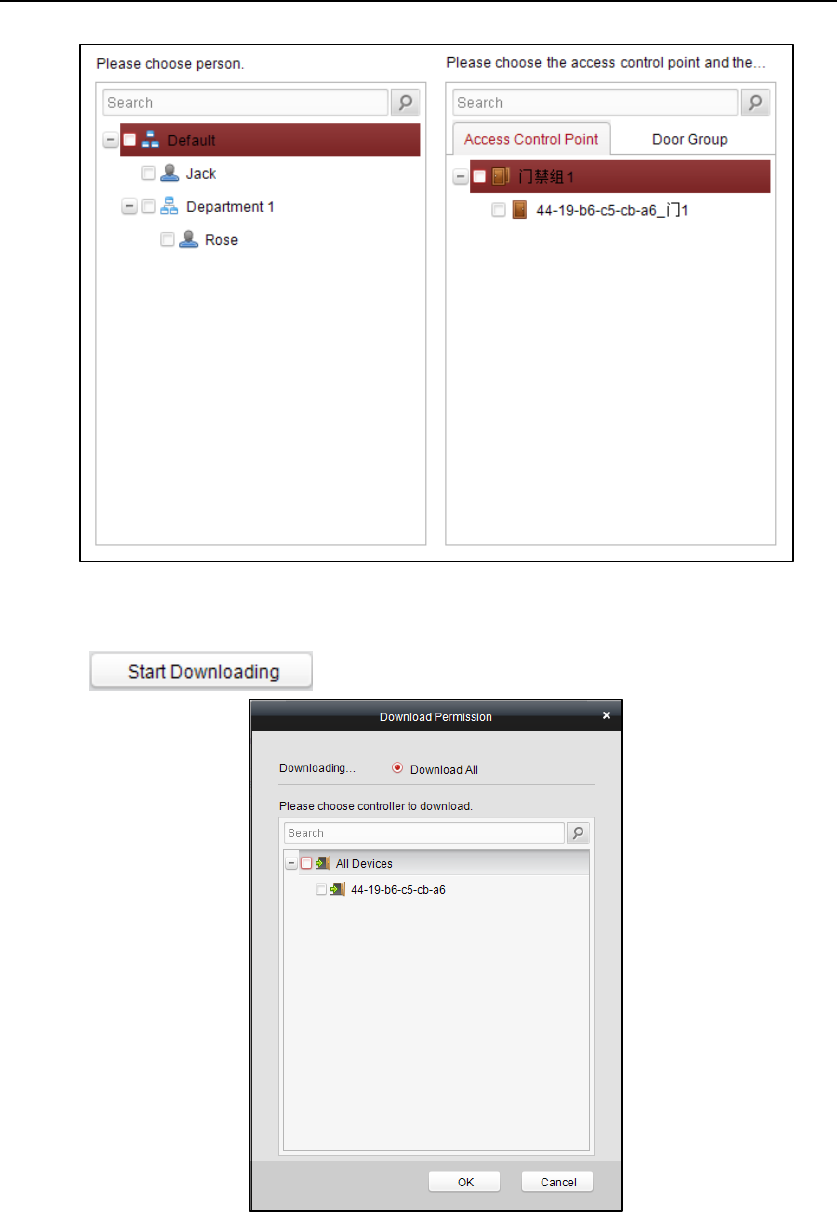
Fingerprint Time Attendance Terminal
80
Note: The lower-level of department will also be selected if the highest-level of
department is selected,
7. Click the Done button to complete the permission adding.
8. Click to enter the Download Permission page.
9. Select a control point and click the OK button, to enter the download result
interface, to download the permission to the device.
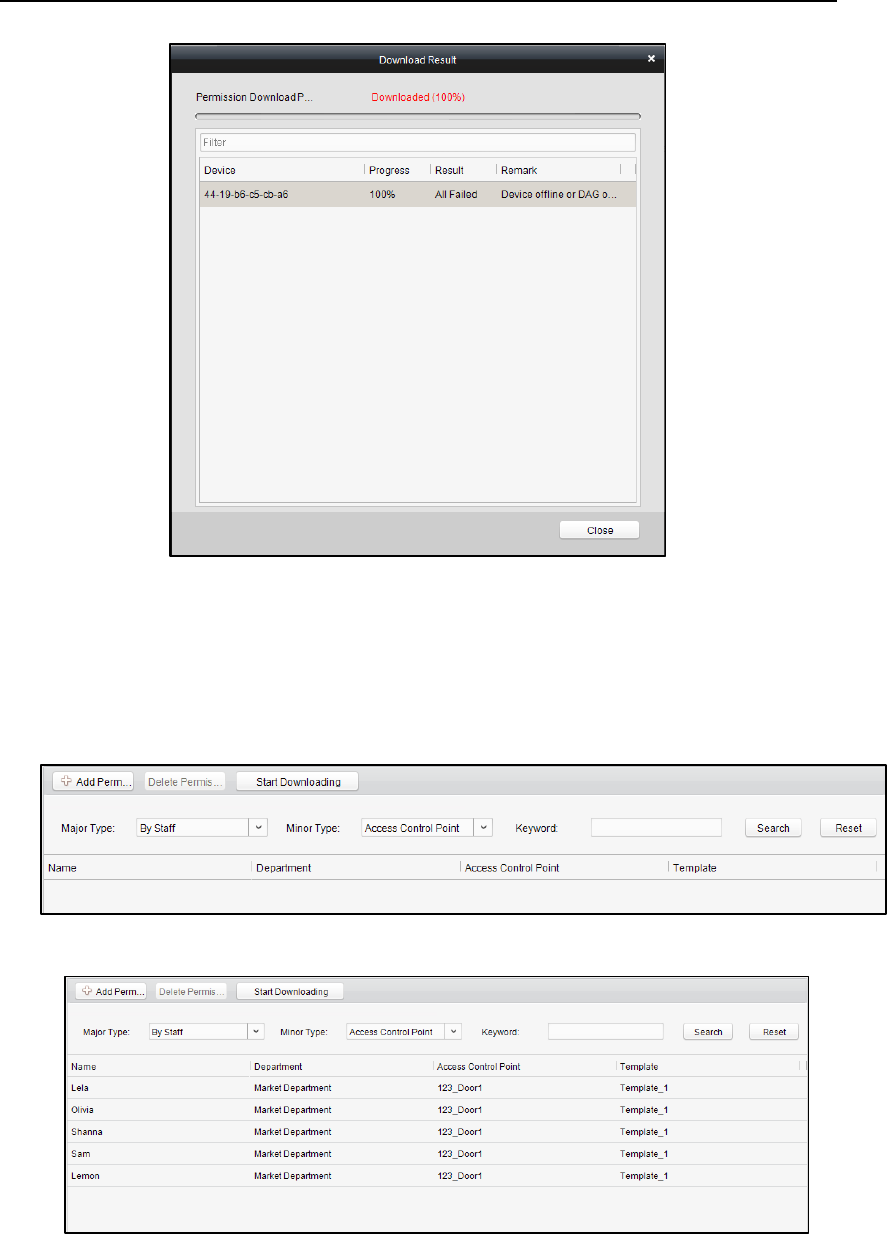
Fingerprint Time Attendance Terminal
81
Access Permission Searching
Purpose:
After the permission settings being completed, you can search and view permission
assigning condition on the searching interface.
Steps:
1. Enter the Permission page.
2. Enter the search criteria (main type/minor type/Keyword).
3. Click Search to get the search results.
Note: You can click Reset on the search criteria panel to clear all the displayed
search results.
Permission Deleting
Steps:
1. Follow steps 1-3 in the Permission Searching section to search for the permission
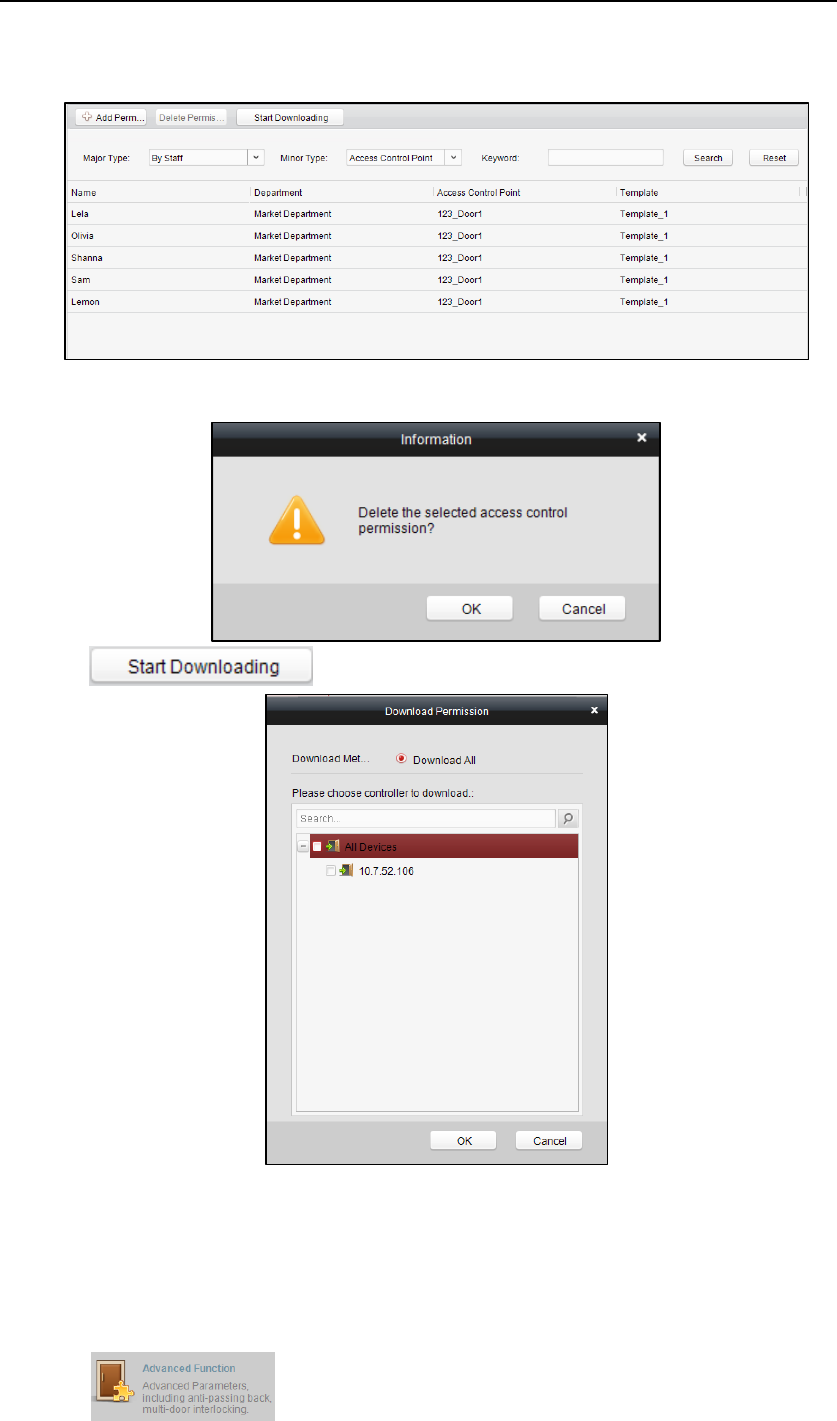
Fingerprint Time Attendance Terminal
82
needs to be deleted.
2. Select the permission from the results list.
Note: you can press the Ctrl or Shift key on the keyboard to select multiple items.
3. Click the Delete Permission button to delete the permission.
4. Click to enter the Download Permission page.
5. Select a control point and click the OK button to download the deletion operation
to the device.
4.3.7 Advanced Functions
Purpose:
The advanced functions of the access control system can be configured.
Click the icon on the control panel to enter the interface.
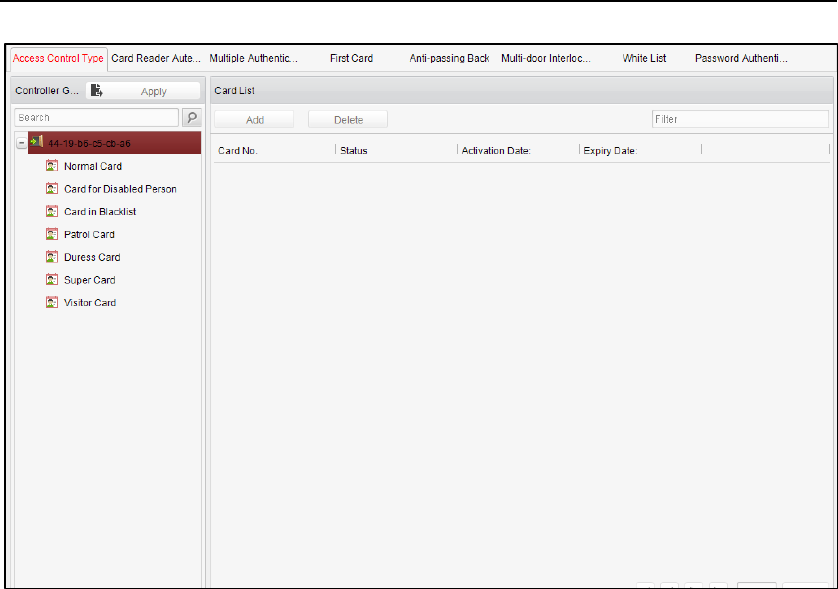
Fingerprint Time Attendance Terminal
83
Access Control Type
Purpose:
The added cards can be assigned with different card type for the corresponding
usage.
Steps:
1. Click Access Control Type tab and select a card type.
Normal Card: By default, the card is set as normal card.
Card for Disabled Person: The door will remain open for the configured time
period for the cardholder.
Card in Blacklist: The card swiping action will be uploaded and the door cannot
be opened.
Patrol Card: The card swiping action can used for checking the working status of
the inspection staff. The access permission of the inspection staff is configurable.
Duress Card: The card swiping action will be uploaded.
Super Card: The card is valid for all the doors of the controller during the
configured schedule.
Visitor Card: The card is assigned for visitors.
2. Click Add and select the available card.
3. Click OK to confirm assigning the card(s) to the selected card type.
4. Click the Apply button to take effect of the new settings.
Notes:
You can click Delete to remove the card from the card type and the card
can be available for being re-assigned.
The attendance device only supports the normal card.
Card Reader Authentication
Purpose:
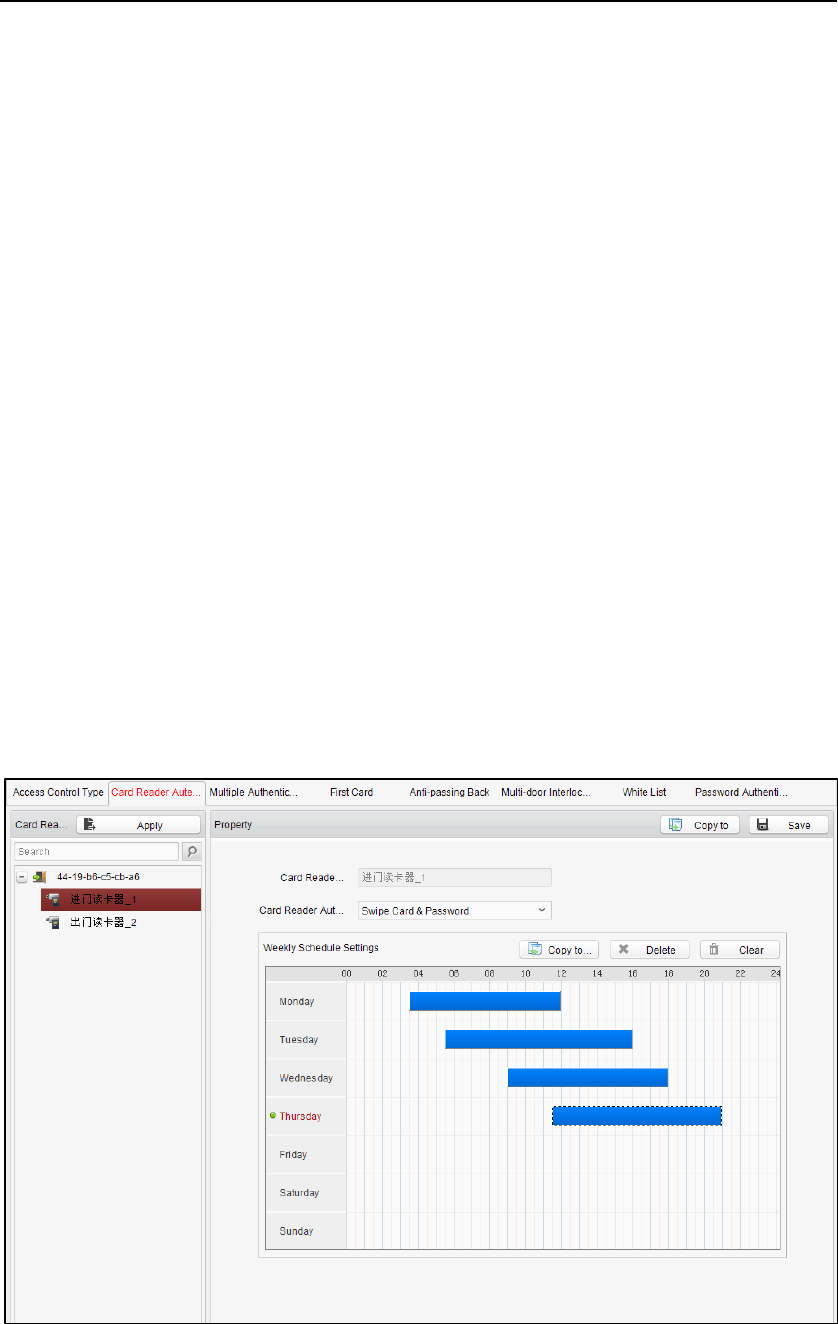
Fingerprint Time Attendance Terminal
84
You can only open the door by both swiping card and entering the password during
the set time periods.
Notes:
For this authentication mode, the card swiping operation cannot be replaced by
entering the card No..
For password settings, please refer to Section 4.3.2 Card Management.
Steps:
1. Click Card Reader Authentication tab and select a card reader.
2. Select a card reader authentication type from the dropdown list.
Fingerprint: The door can open by only inputting the fingerprint.
Swipe Card: The door can open by only swiping the card.
Fingerprint/Swipe Card: The door can open by inputting the fingerprint or
swiping the card.
Swipe Card/Password: The door can open by inputting the ID No. and password,
or swiping the card.
Fingerprint Password: The door can open by both inputting the password and
inputting the fingerprint.
Swipe Card Password: The door can open by both inputting the password and
swiping the card.
Fingerprint Swipe Card: The door can open by both inputting the fingerprint and
swiping the card.
Fingerprint Swipe Card Password: The door can open by both inputting the
fingerprint, inputting the password, and swiping the card.
3. Click and drag your mouse on a day to draw a blue bar on the schedule, which
means in that period of time, the password authentication is valid.
4. Repeat the above step to set other time periods.
Or you can select a configured day and click the Copy to Week button to copy
the same settings to the whole week.
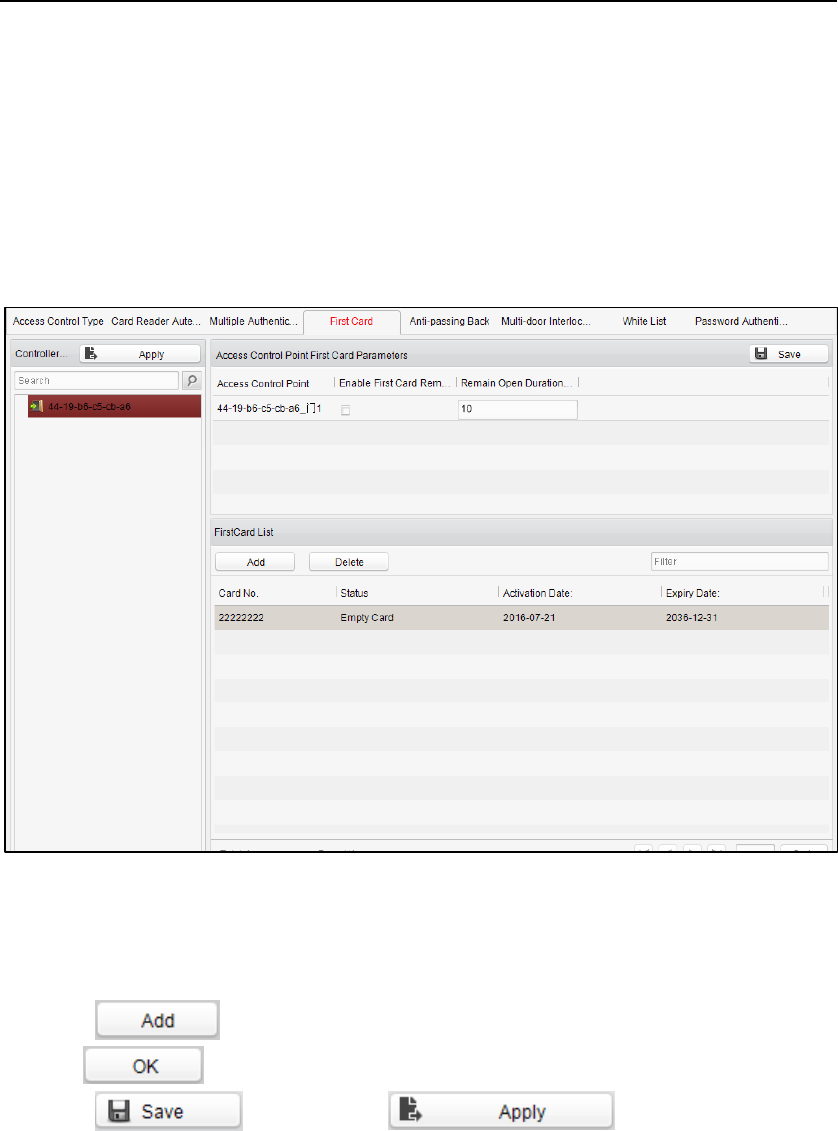
Fingerprint Time Attendance Terminal
85
You can click the Delete button to delete the selected time period or click the
Clear button to delete all the configured time periods.
5. (Optional) Click the Copy to button to copy the settings to other card readers.
6. Click the Save button to save parameters.
7. Click the Apply button to take effect of the new settings.
First Card
Purpose:
The door remains open for the configured time duration after the first card swiping.
Steps:
1. Click First Card and select an access control point.
2. Check the checkbox of Enable First Card Remain Open to enable this function.
3. In the Remain Open Duration (min), input the time duration for remaining open
the door.
4. Click and select the cards to add as first card for the door and click
the button.
5. Click and then click to take effect of the
new settings.
Note: The attendance device does not support the function.
Anti-Passing Back
Purpose:
In this mode, you can only pass the access control system according to the specified
path.
Note: Either the anti-passing back or multi-door interlocking can be configured for an
access controller at the same time.
Setting the Path of Swiping Card (Card Reader Order)
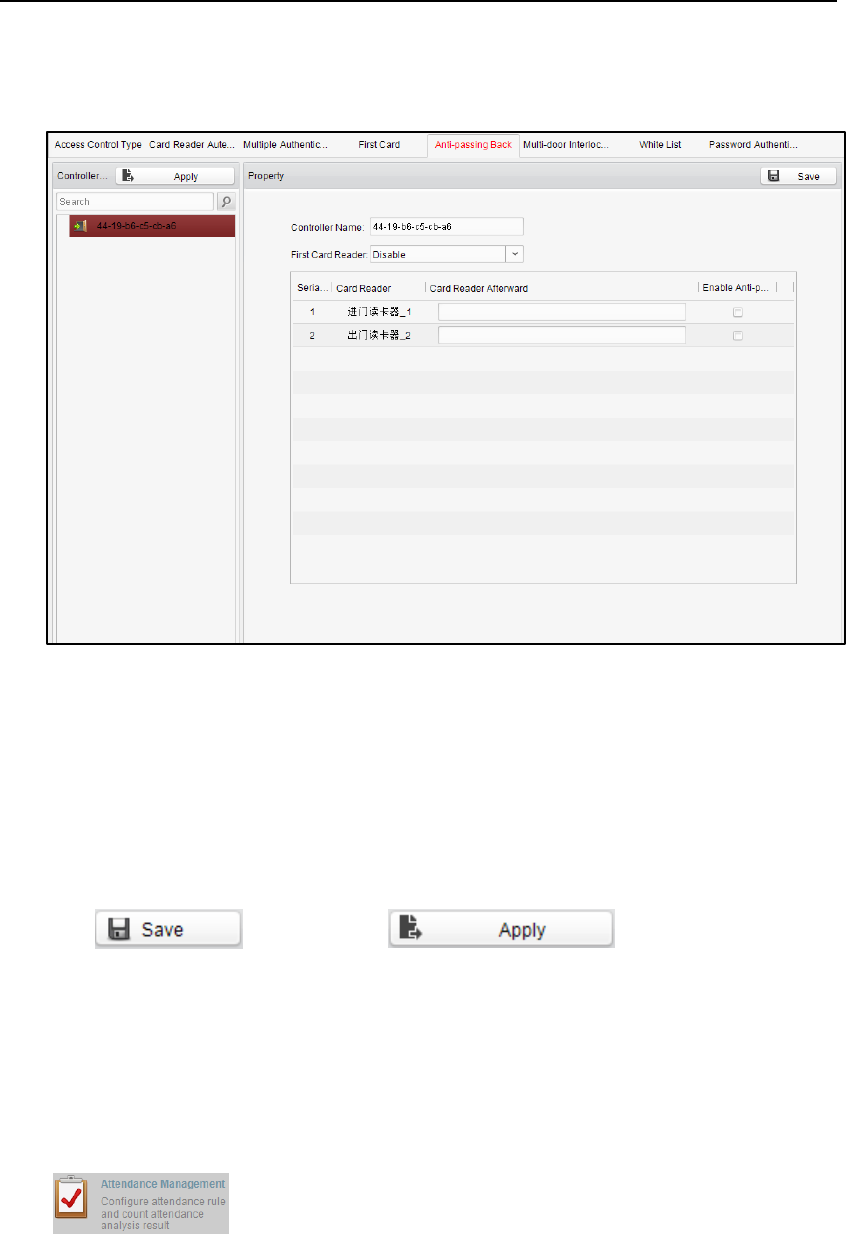
Fingerprint Time Attendance Terminal
86
Steps:
1. Click Anti-passing Back and select an access control point.
2. You can set the name for the controller and select the card reader as the
beginning of the path.
3. In the list, click the text filed of Card Reader Afterward and select the linked card
readers.
Example: If you select Reader In_01 as the beginning, and select Reader In_02,
Reader Out_04 as the linked card readers. Then you can only get through the
access control system by swiping the card in the order as Reader In_01, Reader
In_02 and Reader Out_04.
4. Check the checkbox of Enable Anti-Passing back.
5. Click and then click to take effect of the
new settings.
Note: The attendance device does not support the function.
4.4 Attendance Management
Purpose:
After adding the device and person, you can set the person shift, set the holiday,
manage the person attendance and view the card swiping log.
Click icon on the control panel to enter the Attendance
Configuration interface.
4.4.1 Shift Group Management
Purpose:
On the shift group management interface, you can add, edit, and delete shift groups
for attendance management.
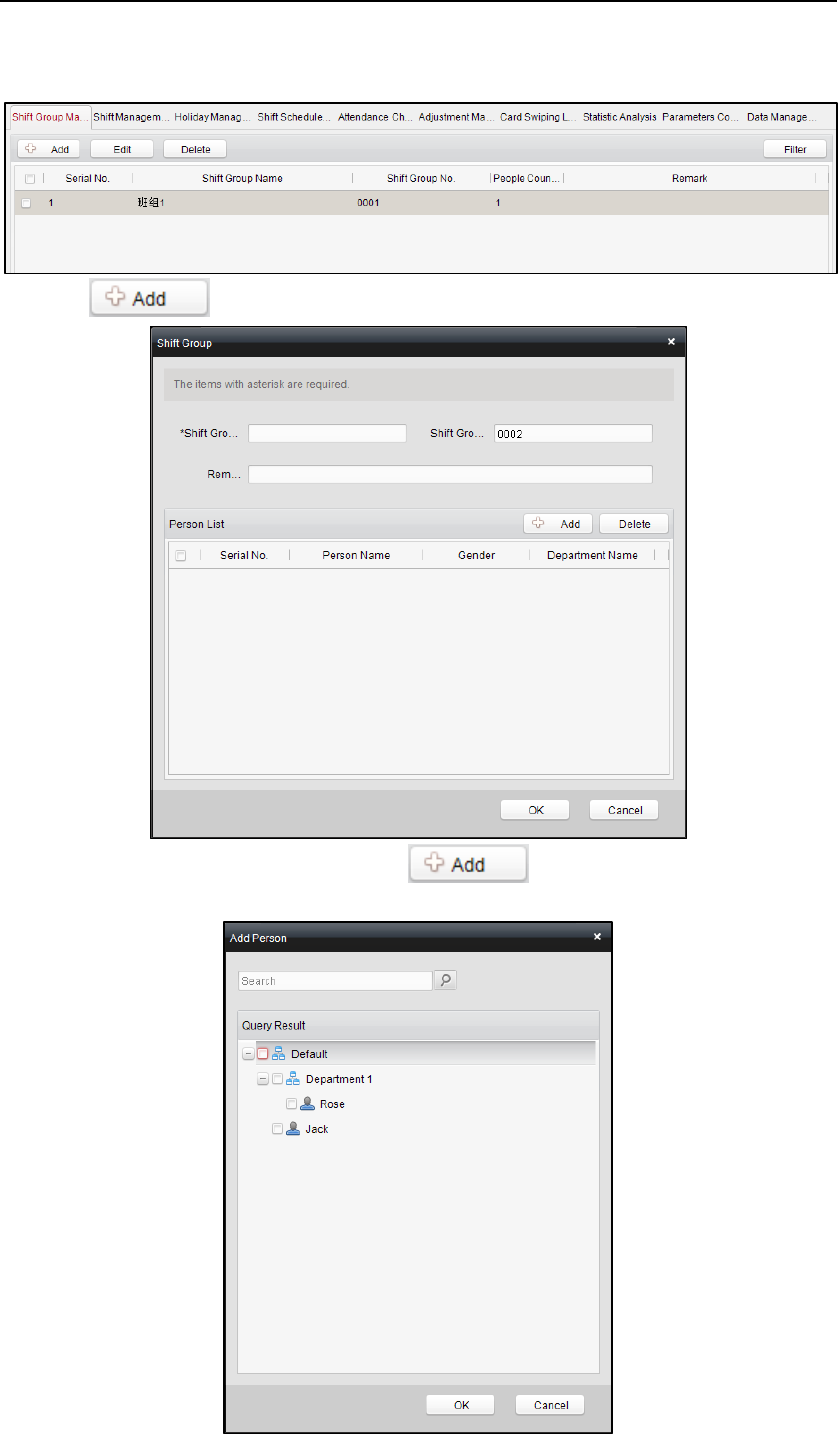
Fingerprint Time Attendance Terminal
87
Steps:
1. Click the Shift Group tab to enter the following page.
2. Click button to pop up the adding shift group window.
3. Enter the shift group name, and add button on the person list area
to pop up the person adding window.
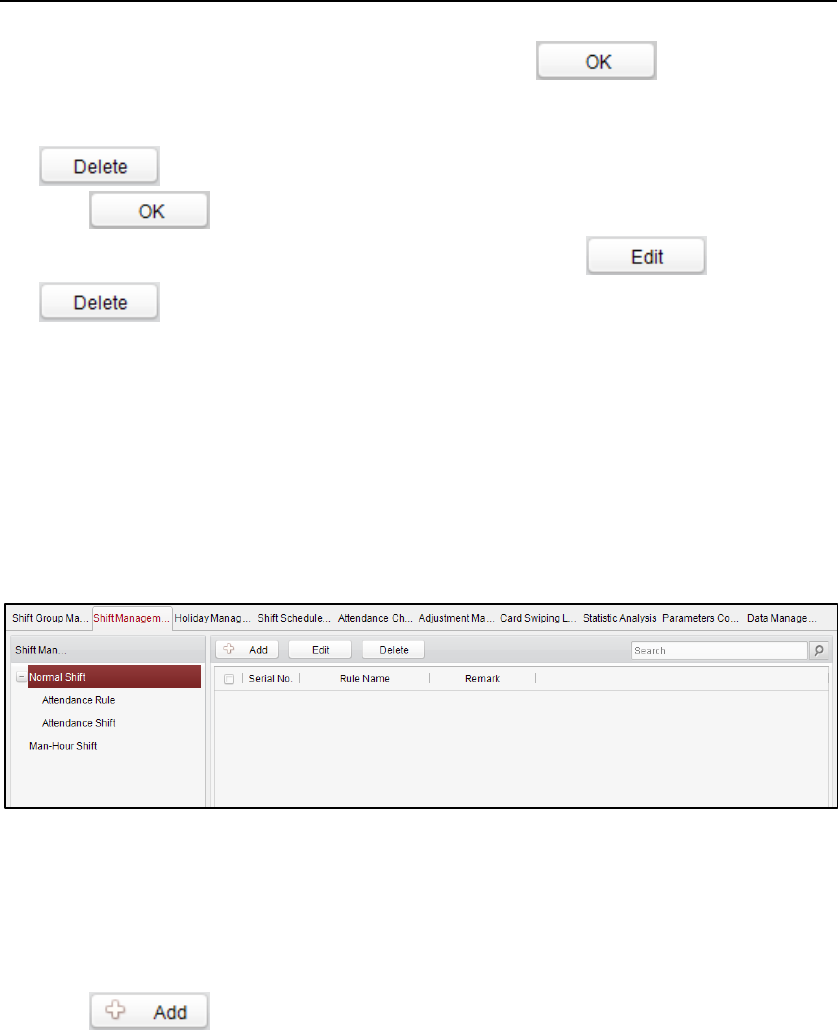
Fingerprint Time Attendance Terminal
88
4. Check the checkbox to select the person and click and return to the
shift group settings interface.
To delete the added person, check the person from the person list, and click
button.
5. Click button to complete the operation.
6. You can edit or delete the added shift groups by clicking or
.
Notes:
After deleting the shift group, the shift schedule of the shift group will be
deleted as well. For details about shift schedule, refer to Section 4.4.4 Shift
Schedule Management.
If the person has been added to one shift group, he/she cannot be added to
other shift groups.
4.4.2 Shift Management
Click Shift tab to enter the shift management interface.
There are two kinds of shifts in this interface: Normal Shift, and Man-Hour Shift.
Normal Shift
Setting Attendance Rule
Steps:
1. Click Attendance Rule to set the rule for the attendance management.
2. Click to pop up the following dialog box.
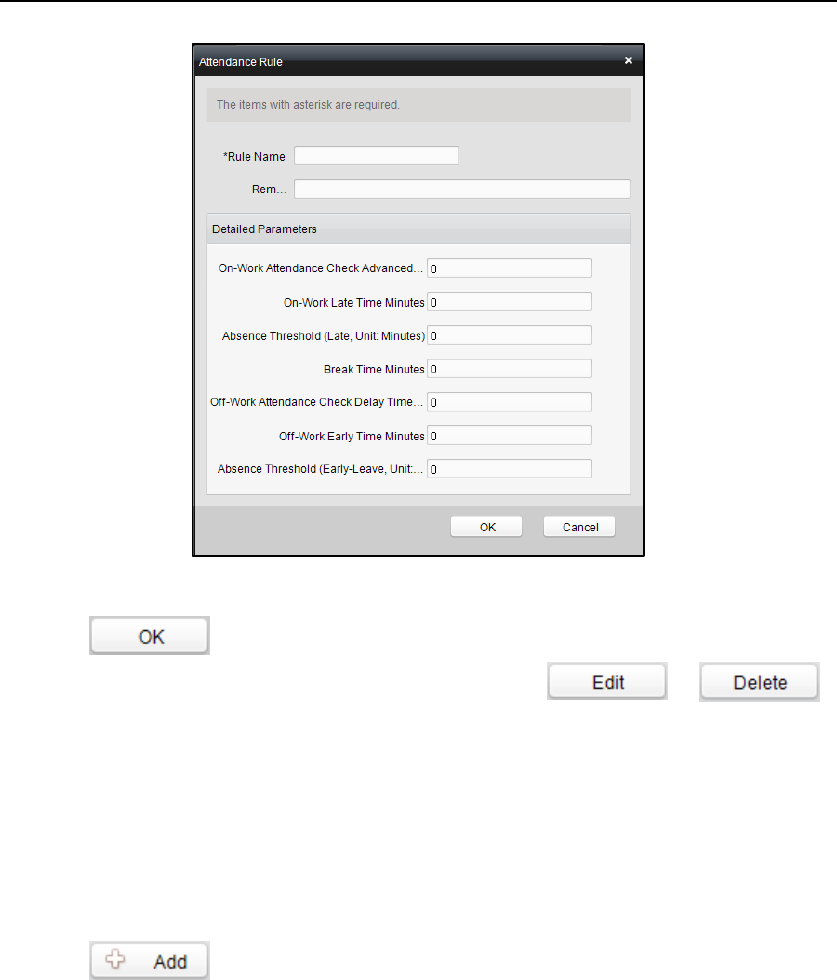
Fingerprint Time Attendance Terminal
89
3. Set a rule name.
4. Set detailed parameters for the attendance rule according to actual needs.
5. Click to save the rule.
6. (Optional) You can edit or delete the rule by clicking or .
Notes:
After deleting the rule, the normal attendance shift which has enabled the
rule will be deleted as well.
If the shift which has enabled the rule has already set the shift schedule, the
shift will not be deleted.
Setting Attendance Shift
Steps:
1. Click Attendance Shift to set the normal attendance shift.
2. Click to pop up the attendance shift setting window.
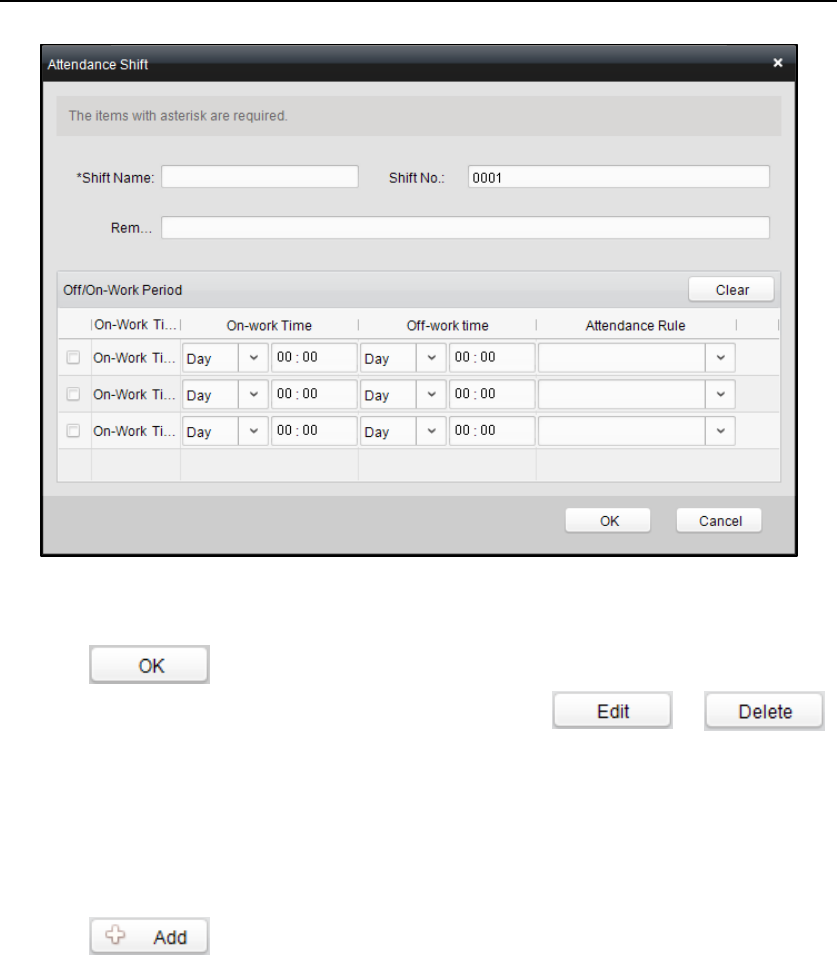
Fingerprint Time Attendance Terminal
90
3. Set a shift name.
4. Set on-work duration for the shift, and select the attendance rule from the
dropdown list.
5. Click to complete the operation.
6. (Optional) You can edit or delete the shift by clicking or .
Note: After deleting the shift, its shift schedule will be deleted as well. For details
about shift schedule, refer to Section 4.4.4 Shift Schedule Management.
Man-Hour Shift
Steps:
1. Click Man-Hour Shift to set the man-hour shift details.
2. Click to pop up the man-hour shift setting window.
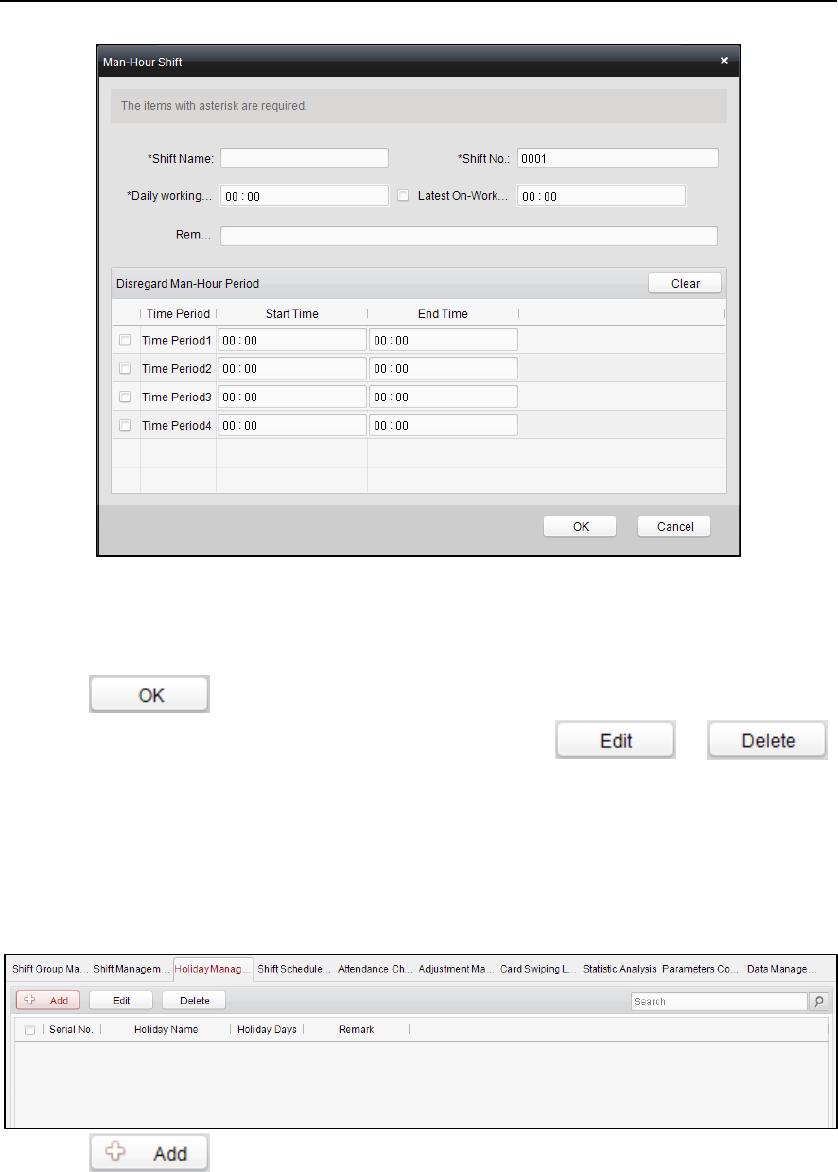
Fingerprint Time Attendance Terminal
91
3. Set a shift name, and daily work duration.
4. (Optional) Check the checkbox of latest on-work time, and set the latest on-work
time.
5. (Optional) Set the durations excluded from man-hour duration.
6. Click to complete the operation.
7. (Optional) You can edit or delete the shift by clicking or .
Note: After deleting the shift, its shift schedule will be deleted as well. For details
about shift schedule, refer to Shift Schedule Management.
4.4.3 Holiday Management
Steps:
1. Click Holiday tab to enter the holiday management interface.
2. Click button to pop up the holiday setting window.
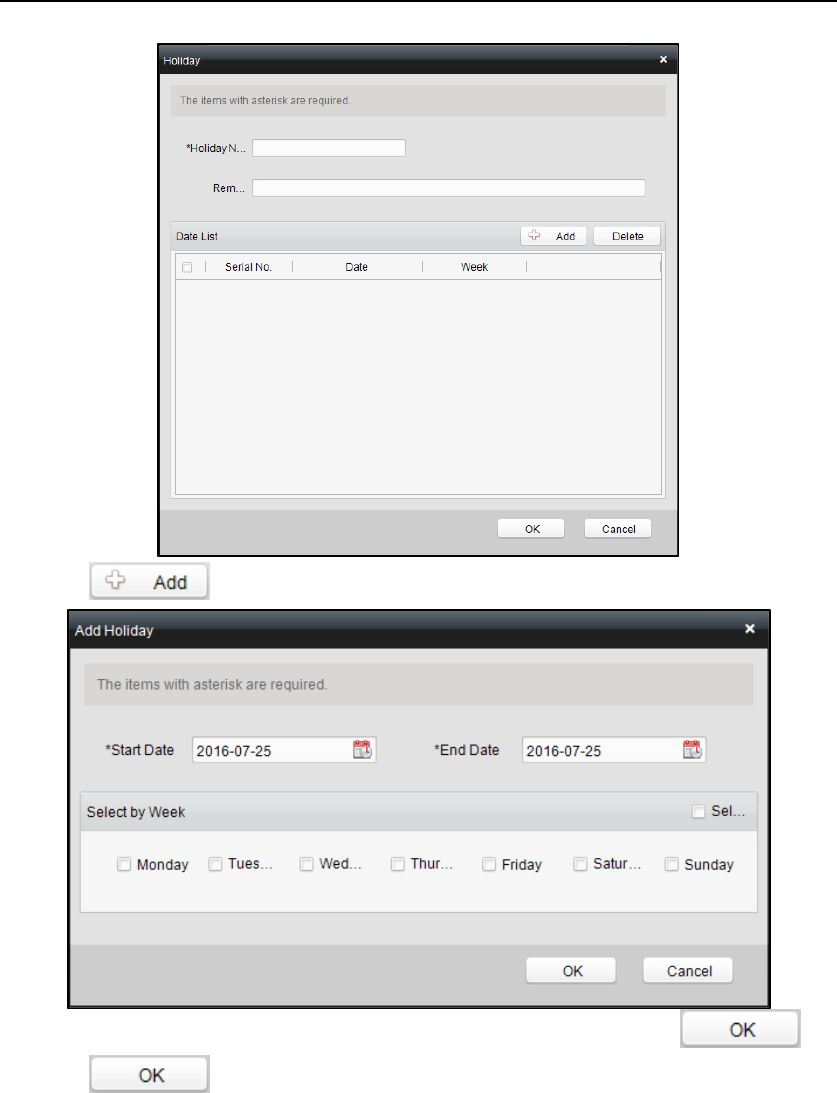
Fingerprint Time Attendance Terminal
92
3. Click button to pop-up holiday adding window.
4. Set the start date and end date, select the date of week, and click .
5. Click to save the settings.
4.4.4 Shift Schedule Management
Purpose:
After setting the shift group and the corresponding shift and shift rule, you can set
the shift schedule for the shifts.
Steps:
1. Click the Shift Schedule tab to enter the shift schedule management interface.
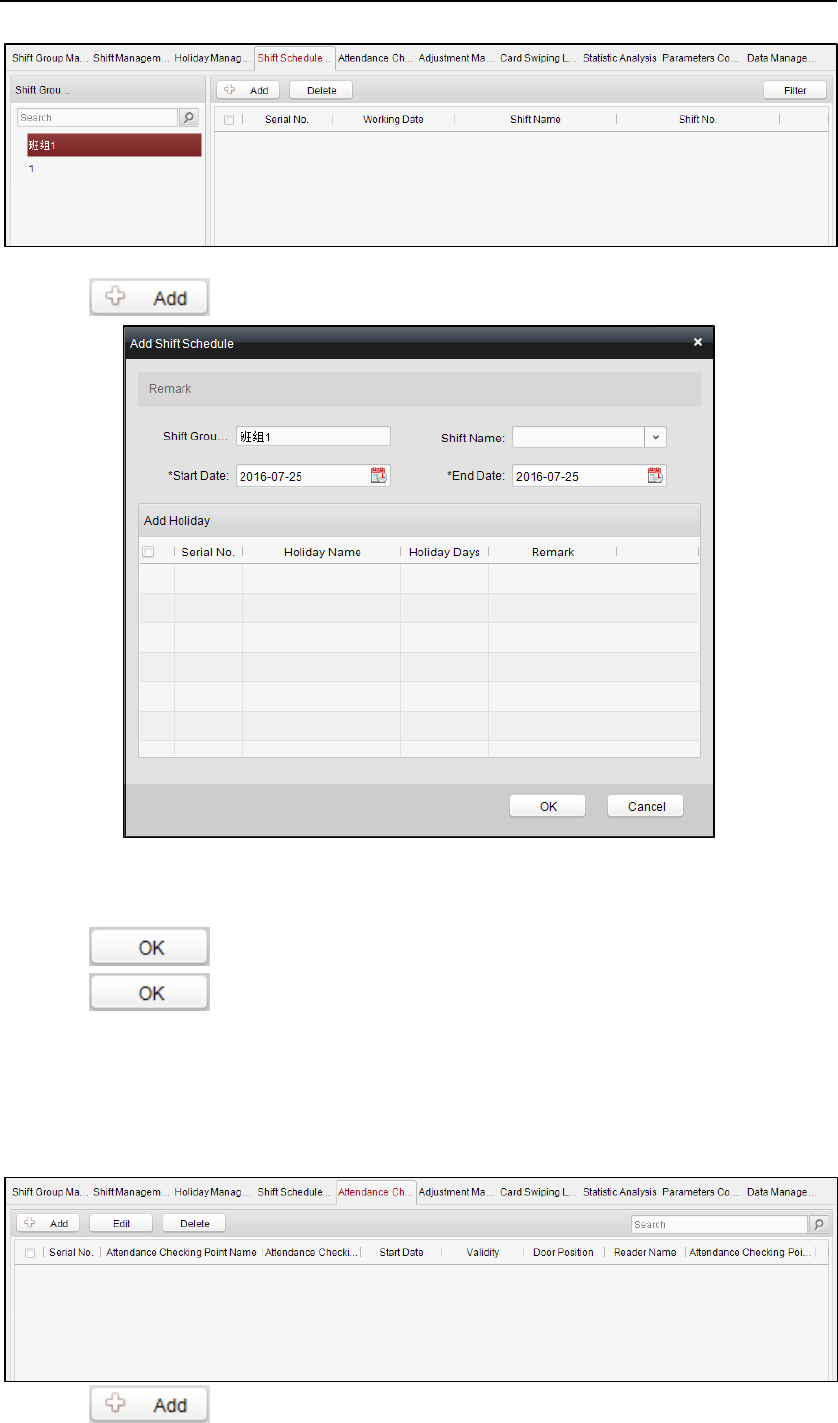
Fingerprint Time Attendance Terminal
93
2. Select the shift group from the list on the left.
3. Click to pop up the shift schedule settings window.
4. Select the shift name from the drop-down list and set the start data and end
data.
(Optional) You can check the checkbox of holiday to add the holiday shift.
Click button to complete the operation.
5. Click to save the settings.
4.4.5 Attendance Check Point Management
Steps:
1. Click the Attendance Check Point tab to enter the attendance check point
management interface.
2. Click to pop up the adding attendance check point interface as
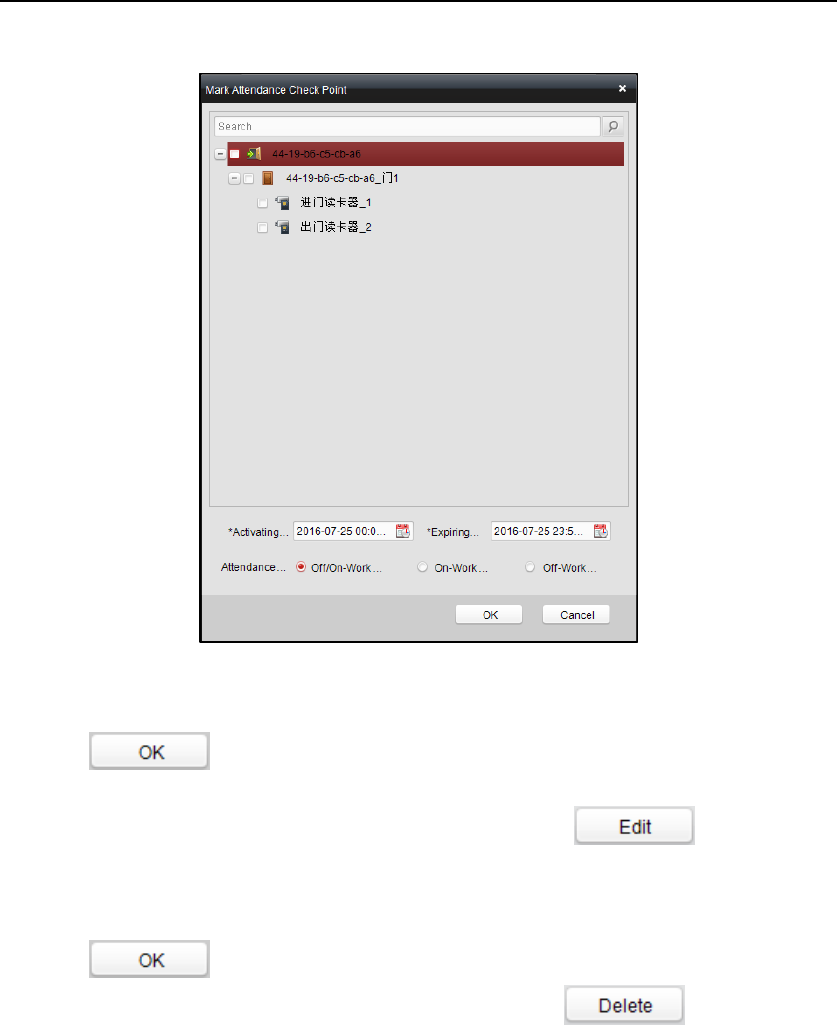
Fingerprint Time Attendance Terminal
94
follows.
Check the select the card reader of the access control point and set the start date
and the end date.
Select the check point type.
Click to save the adding.
The added check points will be displayed in the attendance check point list.
3. You can check the checkbox of a check point, and click to pop up the
attendance check point editing window.
You can edit the attendance check point name, start date, end date, and check
point type, controller name, door position, and card reader name.
Click to complete the operation.
4. You can check the checkbox of a check point and click to delete the
added check point.
4.4.6 Adjustment Management
Click the Adjustment tab to enter the adjustment management interface.
In this module, Reason Management and List Management can be realized.
Reason Management
Leave
You can add, edit, and delete reasons for leave on the leave interface.
Steps:
1. Click Leave tab to enter the leave interface.
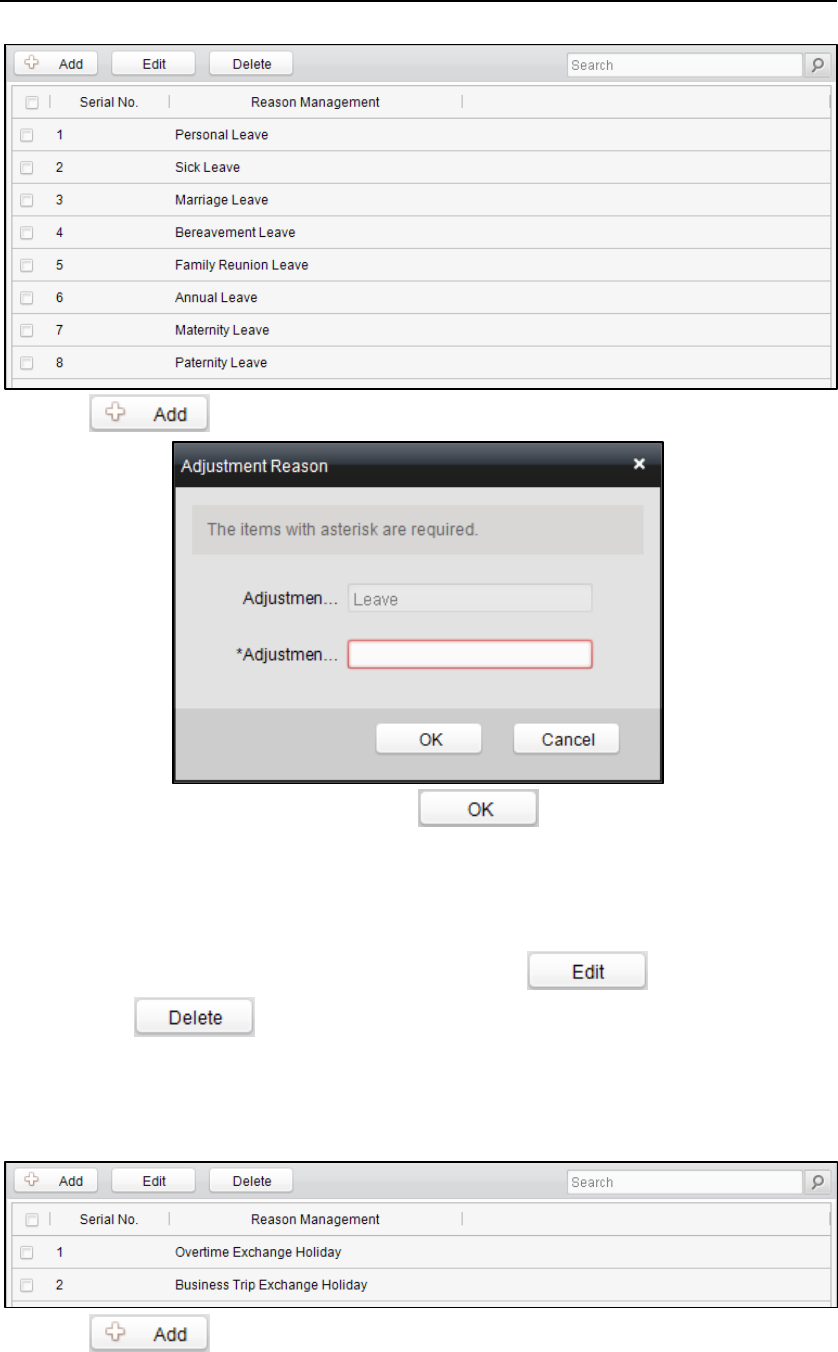
Fingerprint Time Attendance Terminal
95
2. Click to pop up the adjustment reason adding dialog box.
3. Enter the adjustment reason, and click to save the adding.
Notes:
The default adjustment reasons include leave for personal affairs, sick leave,
marriage leave, funeral leave, home leave, annual leave, maternity leave, and
paternity leave.
You can check the checkbox of a reason and click to edit the reason,
and click to delete the reason.
Leave in Lieu
Steps:
1. Click Leave in Lieu tab to enter the leave-in-lieu interface.
2. Click to pop up the adjustment reason adding dialog box.
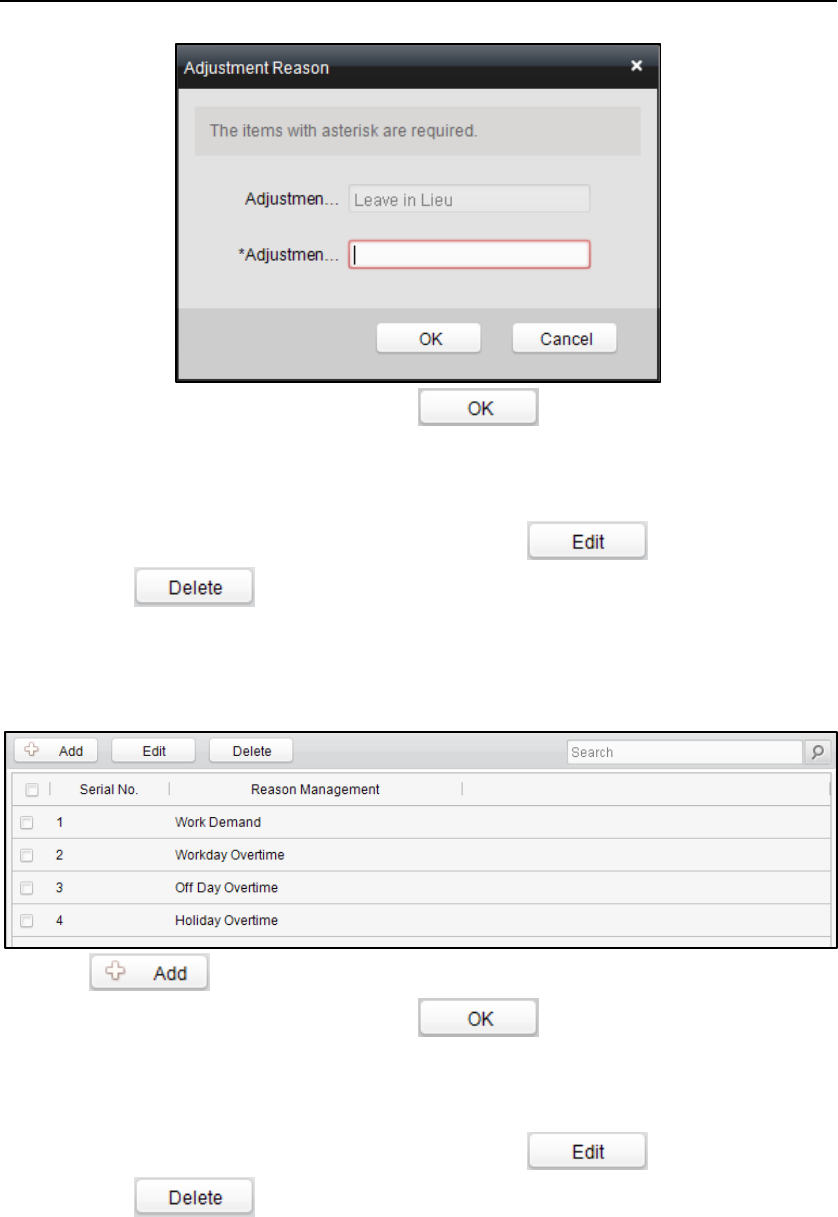
Fingerprint Time Attendance Terminal
96
3. Enter the adjustment reason, and click .
Notes:
The default adjustment reasons for leave in lieu include overtime, and business
trip.
You can check the checkbox of a reason and click to edit the reason,
and click to delete the reason.
Overtime
Steps:
1. Click the Overtime tab to enter the overtime interface.
2. Click to pop up the adjustment reason adding dialog box.
3. Enter the adjustment reason, and click .
Notes:
The default adjustment reasons for overtime include work requirement, working
day overtime, rest day overtime, and holiday overtime.
You can check the checkbox of a reason and click to edit the reason,
and click to delete the reason.
Card Replacement
Steps:
1. Click the Card Replacement tab to enter the following interface.
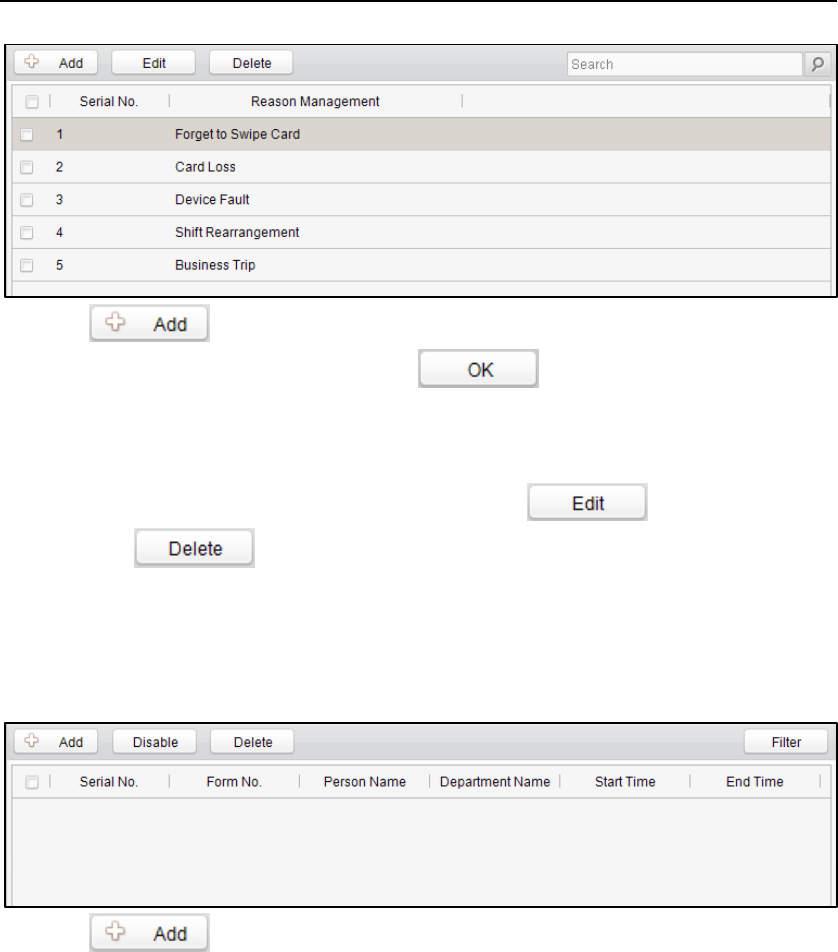
Fingerprint Time Attendance Terminal
97
2. Click to pop up the adjustment reason adding dialog box.
3. Enter the adjustment reason, and click .
Notes:
The default adjustment reasons for card replacing include forget to swipe card,
attendance card lost, device fault, shift adjustment, and business trip.
You can check the checkbox of a reason and click to edit the reason,
and click to delete the reason.
List Management
Enabled List
Steps:
1. Click Enabled List tab to enter the enabled list interface.
2. Click button to add an attendance management form.
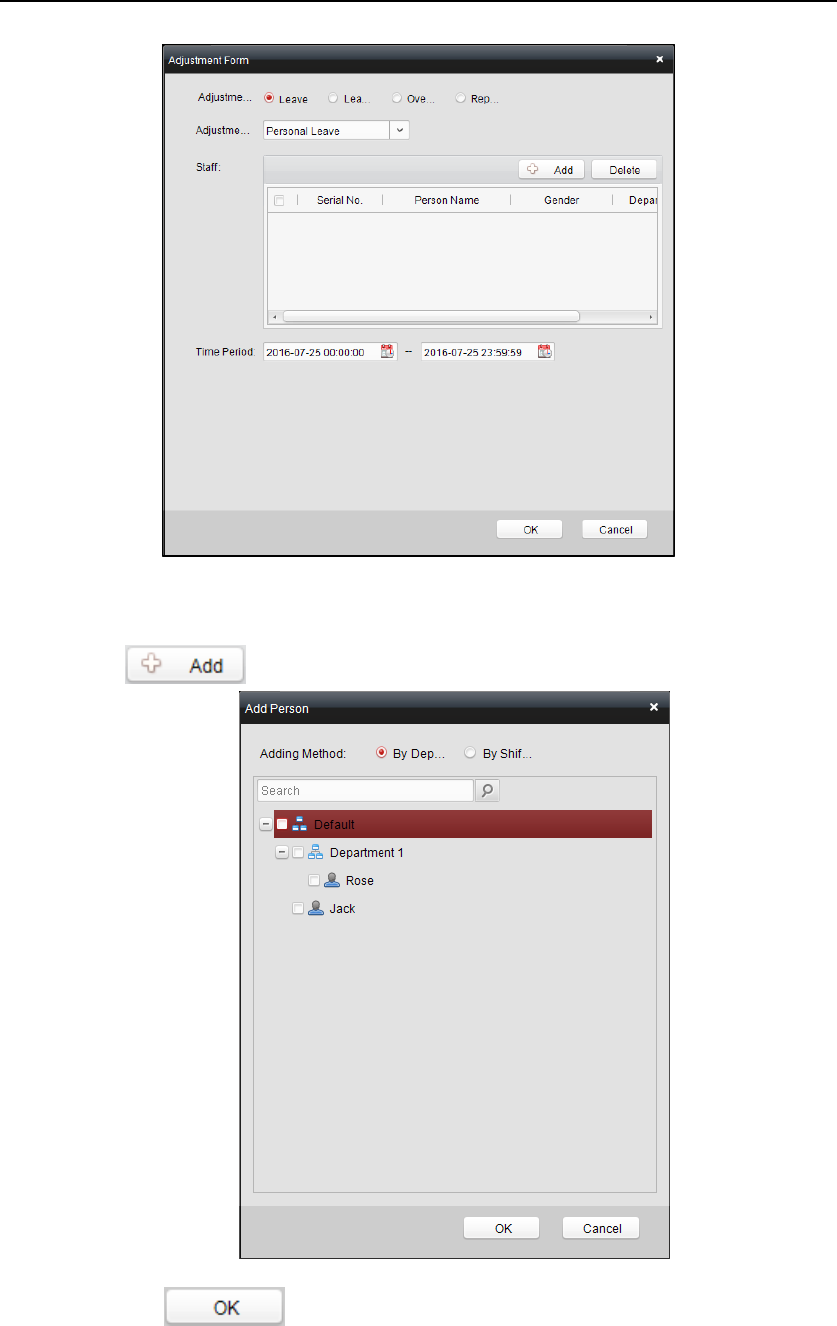
Fingerprint Time Attendance Terminal
98
3. Select the adjustment type: leave, leave in lieu, overtime, and card replacement.
Leave, Leave in Lieu, and Overtime
1) Select the adjustment reason from the drop-down list.
2) Click to pop up the person adding window.
3) Select the adding type as by department or by shift group. Select the person
and click .
4) Set the time duration.
Disabled List
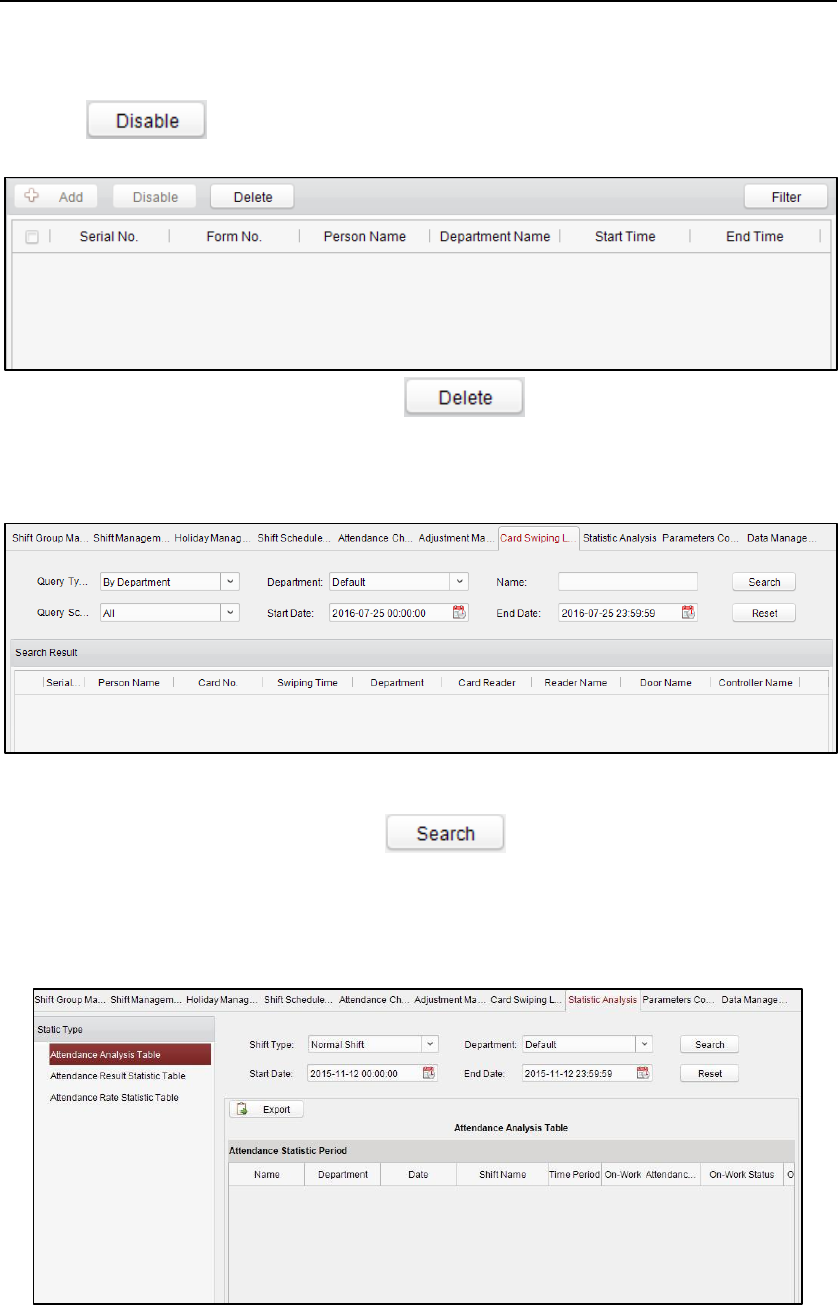
Fingerprint Time Attendance Terminal
99
Steps:
1. In the Enabled List interface, check the checkbox of a piece of enabled list and
click to disable the list.
2. Click Disabled tab and the disabled list will be listed on the disabled interface.
3. You can check the checkbox and click to delete the disabled list.
4.4.7 Card Swiping Log Query
Click Swiping Log tab to enter the card swiping log searching and viewing interface.
You can search the card swiping log by two query types: By Shift Group, and By
Department.
Input other search conditions and click to start query the card swiping
log.
4.4.8 Statistic Analysis
Press the Statistic Analysis tab to enter the statistic analysis interface.
On the statistic analysis interface, you can search the attendance analysis table,
attendance result statistic table, and attendance rate statistic table.
Attendance Analysis Table
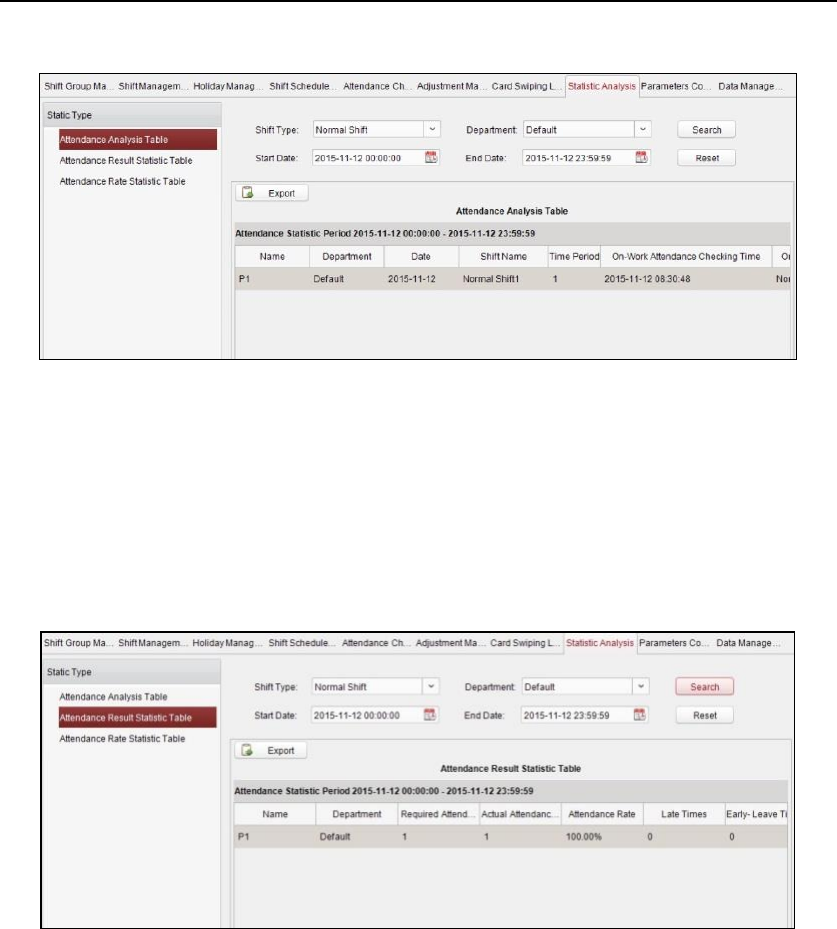
Fingerprint Time Attendance Terminal
100
Press the Attendance Analysis Table tab to enter the attendance analysis interface.
Notes:
• You can search the attendance statistics by different shift type: Normal
Shift, or Man-Hour Shift.
• You can search the attendance statistics by department.
• You can search the attendance statistics by start date and end date.
Attendance Result Statistic Table
Press the Attendance Result Statistic Table tab to enter the attendance result analysis
interface.
Notes:
• You can search the attendance result statistics by different shift type:
Normal Shift, or Man-Hour Shift.
• You can search the attendance result statistics by department.
• You can search the attendance result statistics by start date and end date.
Attendance Rate Statistic Table
Press the Attendance Rate Statistic Table tab to enter the attendance rate analysis
interface.
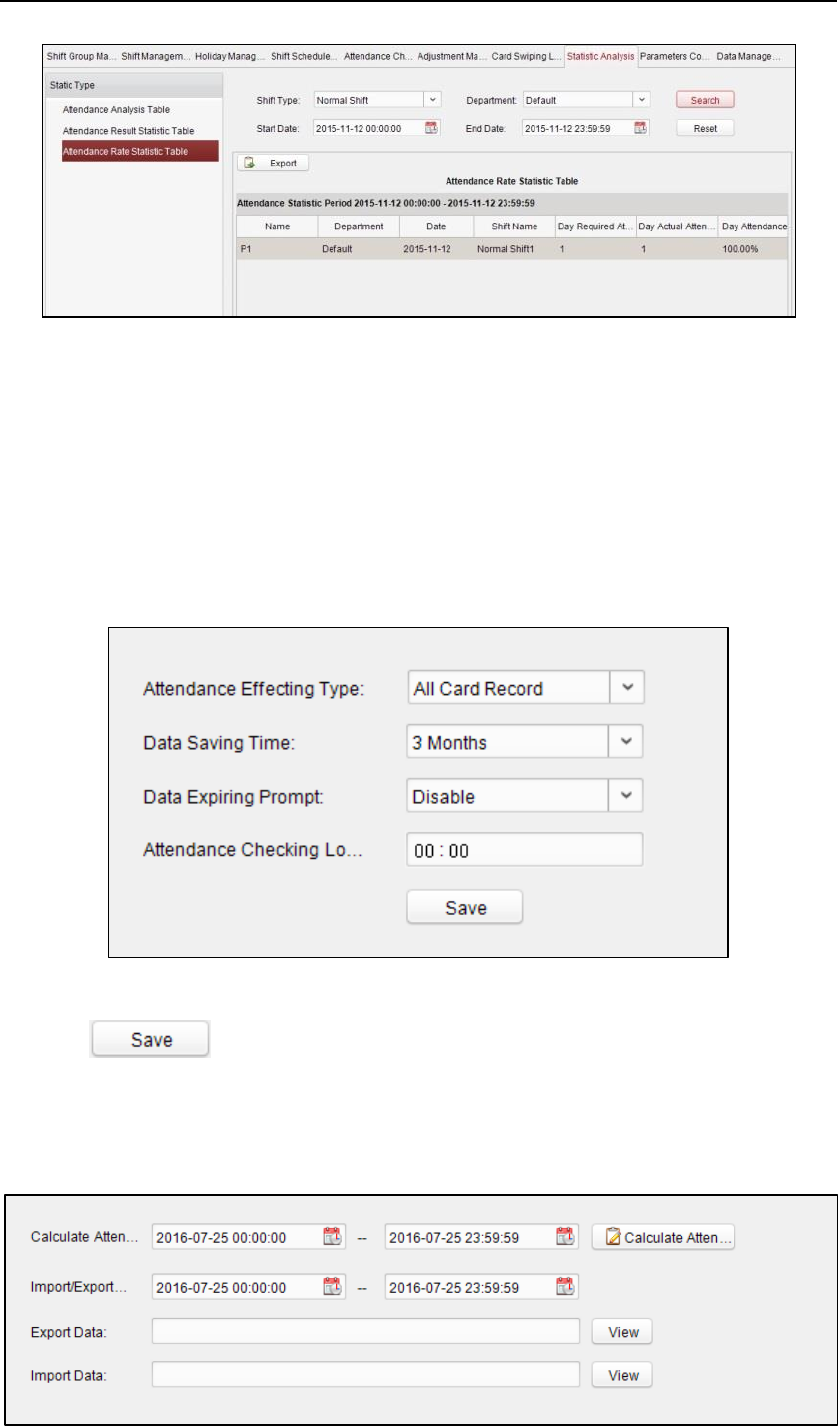
Fingerprint Time Attendance Terminal
101
Notes:
• You can search the attendance rate statistics by different shift type:
Normal Shift, or Man-Hour Shift.
• You can search the attendance rate statistics by department.
• You can search the attendance rate statistics by start date and end date.
4.4.9 Parameters Configuration
Steps:
1. Click the Parameters Configuration tab to enter the parameters configuration
interface.
2. Select the attendance effecting type, data saving time, data expiring prompt.
3. Set the attendance checking log clearing time.
4. Click to save the parameters.
4.4.10 Data Management
Steps:
1. Click the Data Management tab to enter the data management interface.
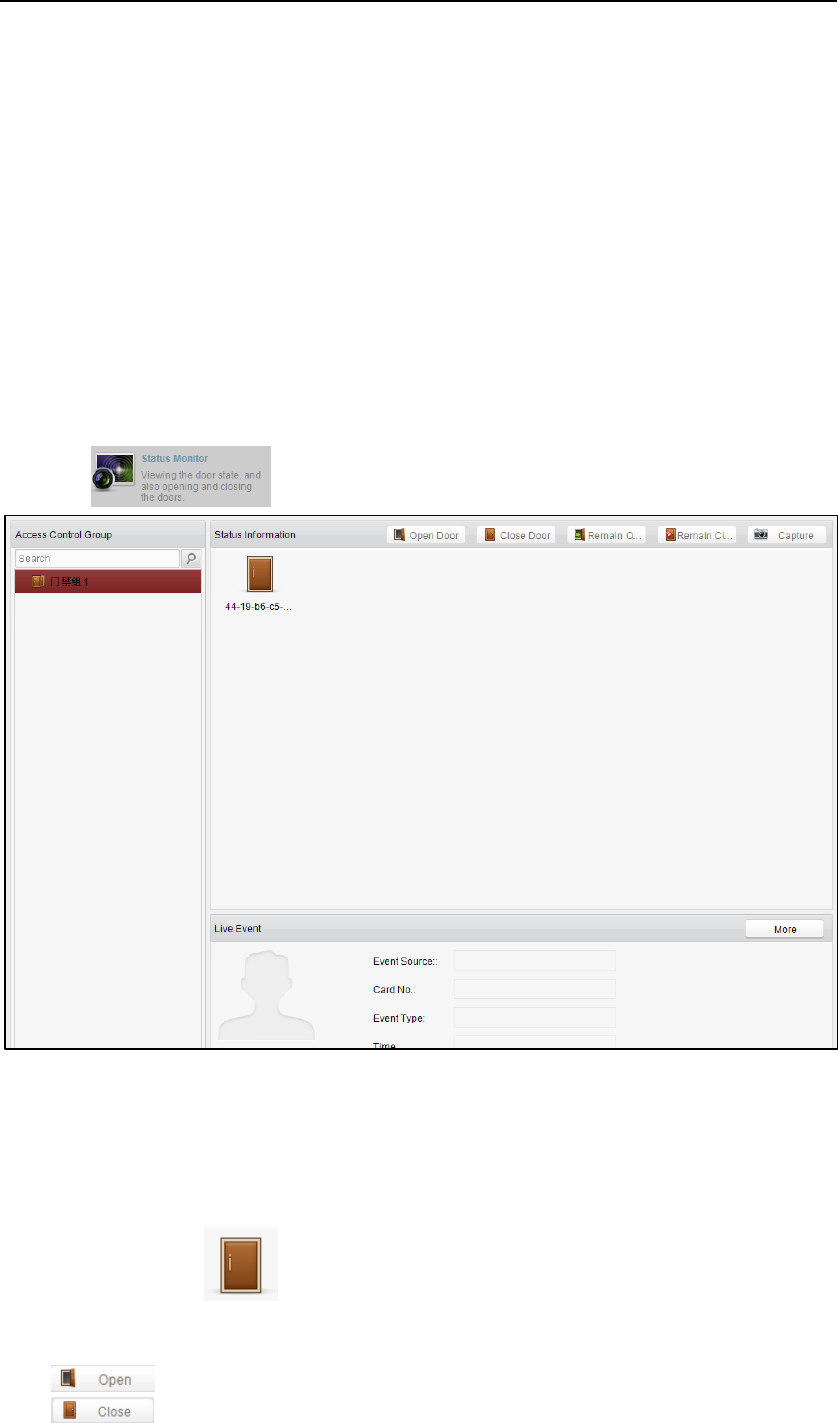
Fingerprint Time Attendance Terminal
102
2. Select the date and time period for calculation and click Calculate Attendance
Data to start calculating the attendance data.
3. After calculation, you can also export and import the attendance data.
4.5 Checking Status and Event
Purpose:
In this section, you are able to anti-control the status of the door and to check the
event report of the control point.
4.5.1 Status Monitor
Purpose:
You can anti-control the door status and check the real-time access event
information for the control point.
Click the icon on the control panel to enter the interface.
Access Anti-control
Purpose:
You can control the status for a single control point (a door) in this section.
Steps:
1. Enter the status monitor page.
2. Click on the icon on the Status Information panel to select a door.
3. Click on the button listed on the upper-left side of the Status Information panel
to select a door status for the door.
: Click on the button to open the door once.
: Click on the button to close the door once.
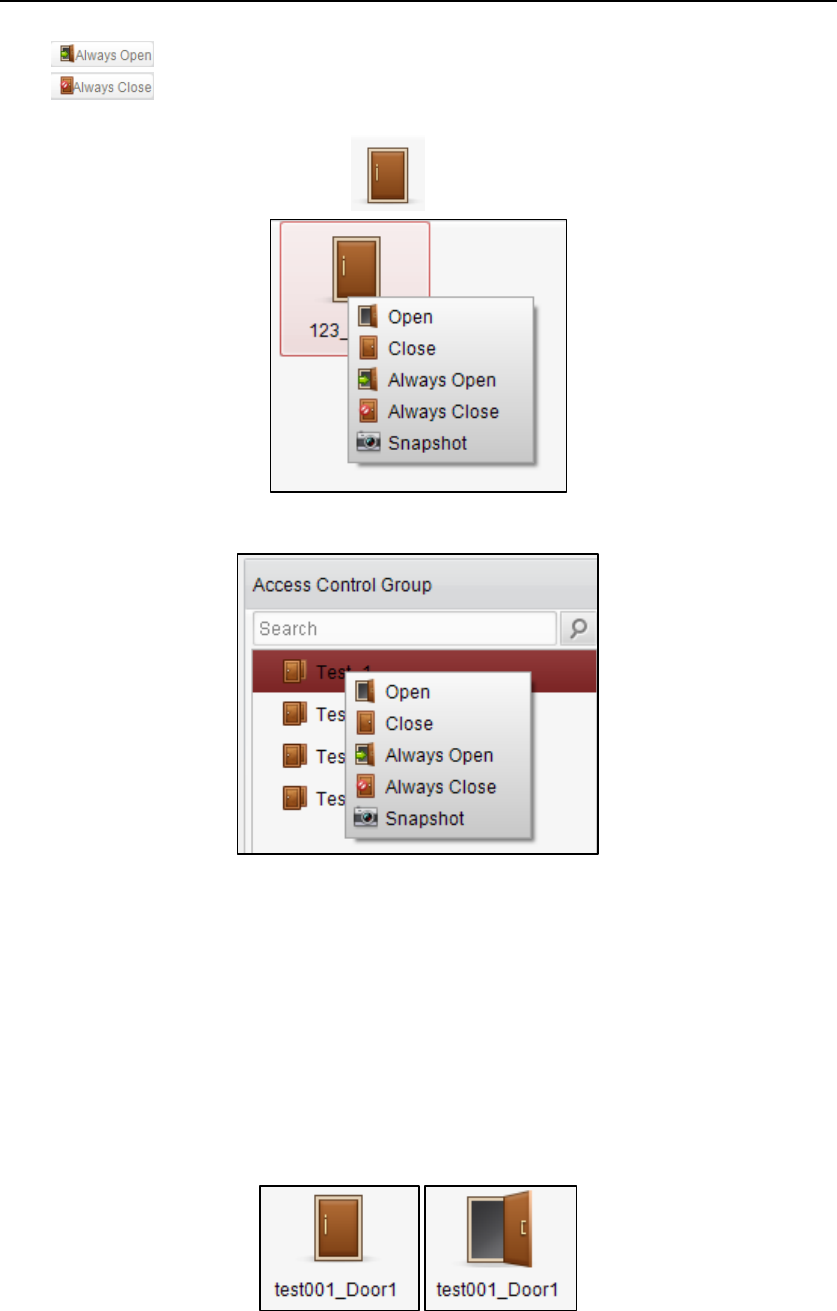
Fingerprint Time Attendance Terminal
103
: Click on the button to keep the door open.
: Click on the button to keep the door closed.
Note: Do not support the Capture function.
4. You can also right click the icon and to select a status for the door.
5. (Optional) Right click on a group in the Group list and to select a door status for
the group.
Notes:
If the status is selected as Remain Open/Remain Closed, the door will keep
open/ closed until a new anti-control command being made.
The function of picture capturing cannot be realized until the storage server is
installed.
Do not support the Capture function.
Access Status
The door status will be represented instantly by the change of icon on the Access
Information panel if the access event is triggered or an anti-control command is
made.
Note: The attendance device does not support the function.
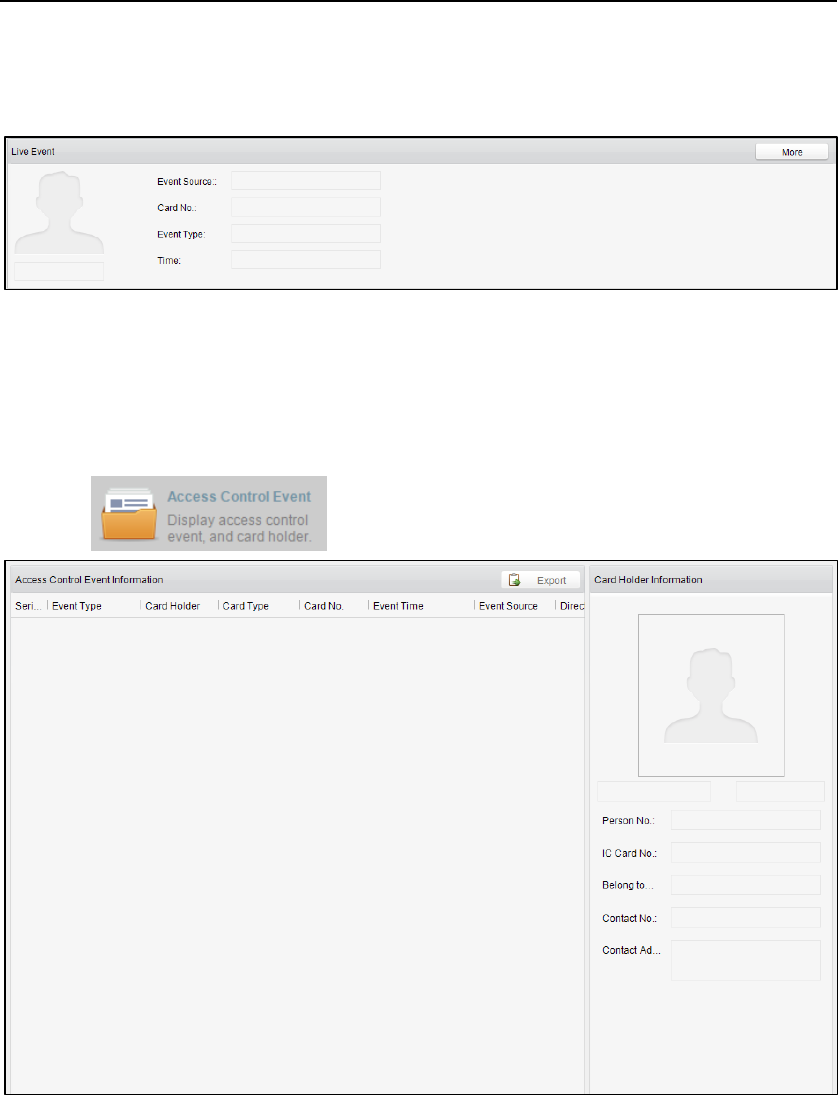
Fingerprint Time Attendance Terminal
104
Real-Time Event
You can check the Real-time information of the access event on this panel. Click
More to enter the Access Event page to view more event information.
4.5.2 Access Control Event
Purpose:
You can view real-time access event (such as swiping to open the door, unrecognized
card number, duration group error, etc.) information in this section.
Click the icon on the control panel to enter the interface.
Steps:
1. Enter the access event page.
2. View the event information in the event list.
3. Click on an event to view the information of the card holder on the Person
Information panel on the left side of the page.
4.5.3 Event Search
Purpose:
You can search historical access event according to the search criteria (such as event
type, name of the person, card No. or start/end time) in this section.
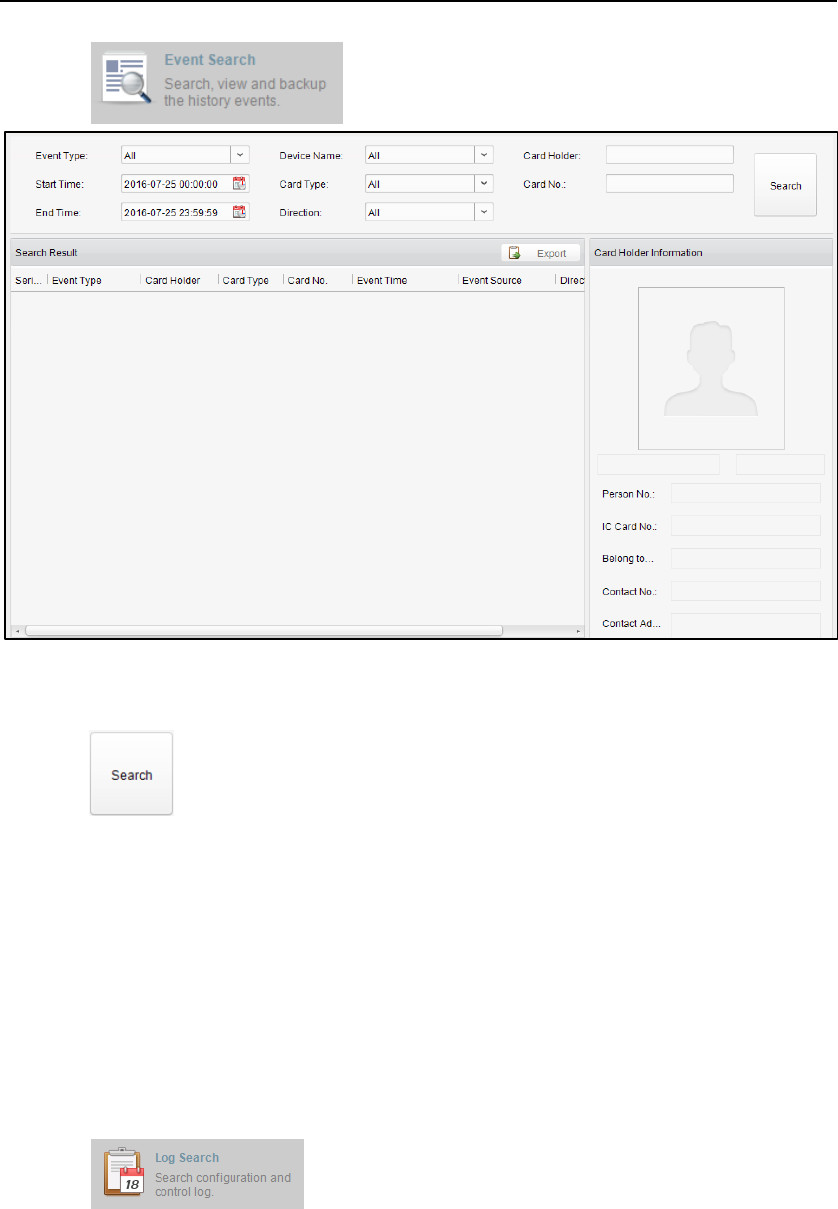
Fingerprint Time Attendance Terminal
105
Click the icon on the control panel to enter the interface.
Steps:
1. Enter the event search page.
2. Enter the search criteria (event type/ person name/ card No/ start &end time).
3. Click to get the search results.
4. View the event information in the event list.
5. Click on an event to view the information of the card holder on the Person
Information panel on the left side of the page.
4.6 System Maintenance
4.6.1 Log Management
Purpose:
The log files of the Access Control System and the devices that connected to the
Access Control System can be searched for checking.
Click the icon on the control panel to open the Log Search
page.
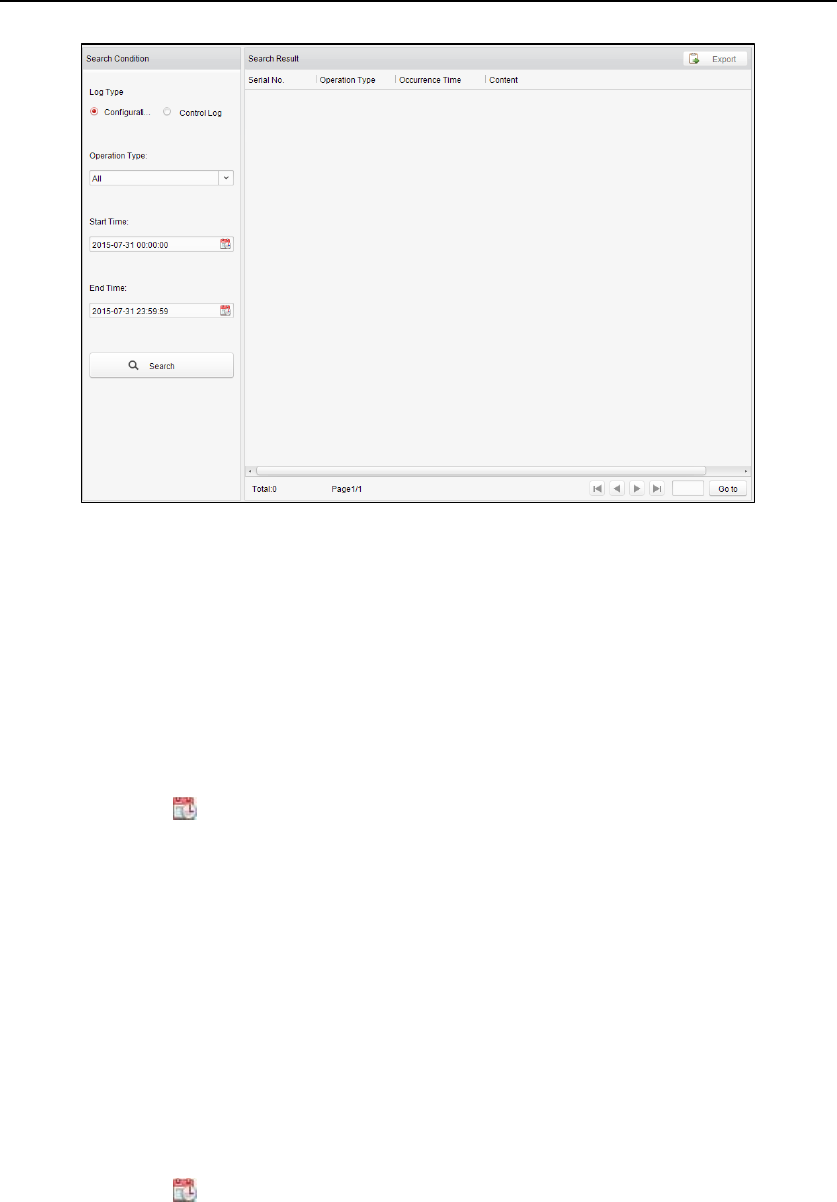
Fingerprint Time Attendance Terminal
106
Configuration Logs Searching
Purpose:
The Configuration Log files of the Access Control System can be searched by
time ,including One-card Configuration, Access Control Configuration, Downloading
Permission and System Configuration.
Steps:
1. Open the Log Search page.
2. Select the radio button of Configuration Logs.
3. Select the Operation Type of log files.
4. Click the icon to specify the start time and end time.
5. Click Search. The matched log files will display on the list.
You can check the operation time, log type and other information of the logs.
Note: Please narrow the search condition if there are too many log files.
Control Logs Searching
Purpose:
The Control Log files of the Access Control System can be searched by time ,including
Access Control and Log Search.
Steps:
1. Open the Log Search page.
2. Select the radio button of Control Logs.
3. Select the Operation Type of log files.
4. Click the icon to specify the start time and end time.
5. Click Search. The matched log files will display on the list.
You can check the operation time, log type and other information of the logs.
Note: Please narrow the search condition if there are too many log files.
Searching Configuration Log
Searching One-card Configuration Logs
Purpose:

Fingerprint Time Attendance Terminal
107
The One-card Configuration Log files include departments, persons and cards log
files. One-card Configuration of the Access Control System can be operated as
adding ,modifying and deleting logs.
Steps:
1. Open the Log Search page.
2. Select the radio button of Configuration Logs.
3. Select the operation type as One-card Configuration.
4. Click the icon to specify the start time and end time.
5. Click Search. The matched log files will display on the list.
You can check the operation time, log type and other information of the logs.
Note: Please narrow the search condition if there are too many log files.
Searching Access Control Configuration Logs
Purpose:
The Access Control Configuration Log files include Access Control devices log files.
Access Control Configuration of the Access Control System can be operated as
adding, modifying and deleting door groups or doors and access control device
permission operations.
Steps:
1. Open the Log Search page.
2. Select the radio button of Configuration Logs.
3. Select the operation type as Access Control Configuration.
4. Click the icon to specify the start time and end time.
5. Click Search. The matched log files will display on the list.
You can check the operation time, log type and other information of the logs.
Note: Please narrow the search condition if there are too many log files.
Searching Downloading Permission Logs
Purpose:
The Downloading Permission Log files include downloading permission log files, and
no record for downloading permission failure log files.
Steps:
1. Open the Log Search page.
2. Select the radio button of Configuration Logs.
3. Select the operation type as Downloading Permission.
4. Click the icon to specify the start time and end time.
5. Click Search. The matched log files will display on the list.
You can check the operation time, log type and other information of the logs.
Note: Please narrow the search condition if there are too many log files.
Searching System Configuration Logs
Purpose:
The System Configuration Log files of the Access Control System can be searched as
system configuration interface log files.
Steps:
1. Open the Log Search page.
2. Select the radio button of Configuration Logs.

Fingerprint Time Attendance Terminal
108
3. Select the operation type as System Configuration Logs.
4. Click the icon to specify the start time and end time.
5. Click Search. The matched log files will display on the list.
You can check the operation time, log type and other information of the logs.
Note: Please narrow the search condition if there are too many log files.
Searching Control Log
Searching Access Control Logs
Purpose:
The Access Control Log files of the Access Control System include door groups and
doors access control logs and door on/off control log files.
Steps:
1. Open the Log Search page.
2. Select the radio button of Control Logs.
3. Select the operation type as Access Control Logs.
4. Click the icon to specify the start time and end time.
5. Click Search. The matched log files will display on the list.
You can check the operation time, log type and other information of the logs.
Note: Please narrow the search condition if there are too many log files.
Log Search
Purpose:
The Log Search of the Access Control System include informations for configuration
log files and control log files.
Steps:
1. Open the Log Search page.
2. Select the radio button of Control Logs.
3. Select the operation type as Log Search.
4. Click the icon to specify the start time and end time.
5. Click Search. The matched log files will display on the list.
You can check the operation time, log type and other information of the logs.
Note: Please narrow the search condition if there are too many log files.
4.6.2 System Configuration
Purpose:
The general parameters, Auto Time Adjustment and Card Reader of the Access
Control System can be configured.
Click the icon on the control panel to open the System
Configuration page.
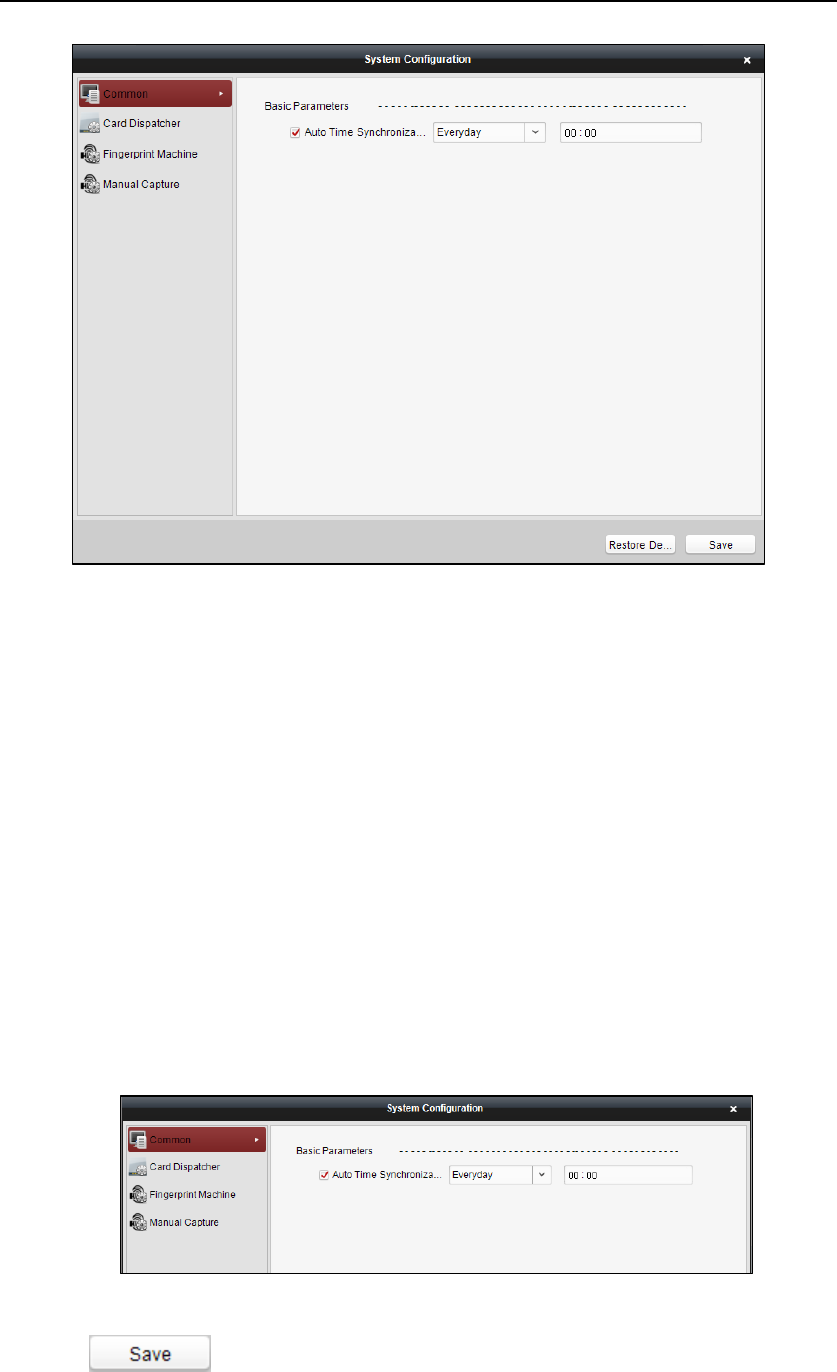
Fingerprint Time Attendance Terminal
109
Auto Time Synchronization
The Auto Time Synchronization of the Access Control System can operate auto time
adjustment to all access control devices of the Access Control System according to
specified period and time.
Card Reader Configuration
The Card Reader Configuration is for Access Control System to read the card by
setting Card Reader parameters. For now D8E-U-A-III and DS-K1F100-M card reader
types are supported.
Fingerprint Machine
The Fingerprint Machine is for Access Control system to collect fingerprints.
Manual Capture Configuration
The Manual Capture Configuration is for Access Control system to take photos
remotely.
Auto Time Synchronization
Steps:
1. Open the System Configuration page.
2. Click the Common tab to enter the Common Settings interface.
3. Tick the checkbox to enable Auto Time Synchronization.
4. Select the matched day and input the time to operate the time adjustment.
5. Click to save the settings.
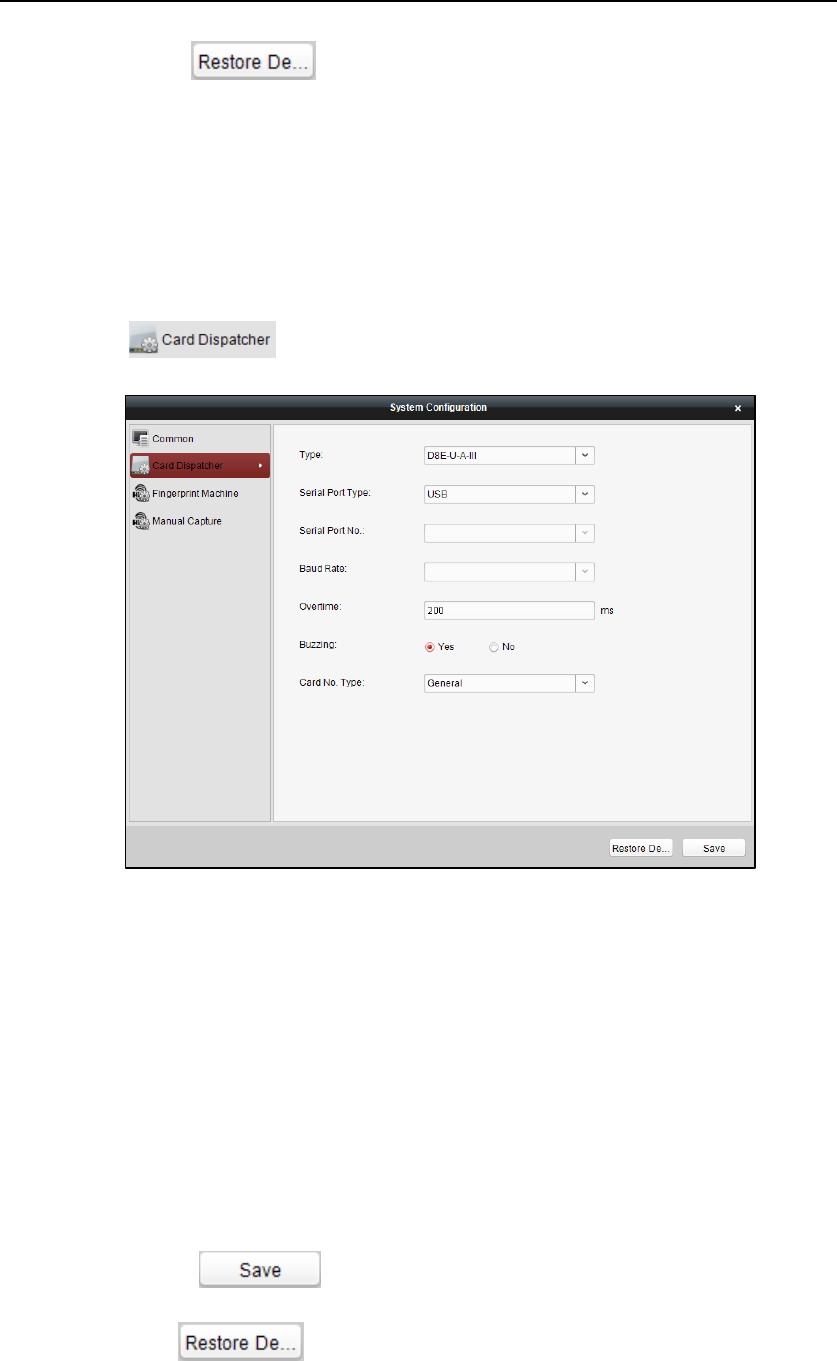
Fingerprint Time Attendance Terminal
110
Note: You can click (Restore Default Value) to restore the defaults of all
the local configurations.
Card Dispenser Configuration
Purpose:
The Card Reader Configuration of the Access Control System can configure device
type, connection mode, serial port, baud rate and other parameters of the Card
Reader Configuration.
Steps:
1. Click the icon on the System Configuration interface to open the
Card Dispatcher Configuration page.
2. Select the device type, serial port type, serial port, baud rate, and other
parameters of the Card Dispatcher.
3. Click the save button to save the settings.
Note:
Configuration Instruction
DS-K1F100-M: select Serial Port Mode as accessing mode (currently only support
serial port mode), the serial port NO. is the COM port NO. of the computer. Set
other parameters as default.
D8E-U-A-III: select USB Mode as accessing mode (currently only support USB
mode). Set other parameters as default.
It is supported using card type as regular and Wiegand.
When the BEEP is selected as “YES”, the audio will be off when you click the
“SAVE” if the Card Reader Configuration is set wrong; the audio will be on when
you click the and when you insert the card reader if the
configuration is set correct.
You can click (Restore Default Value) to restore the defaults of all
the local configuration.
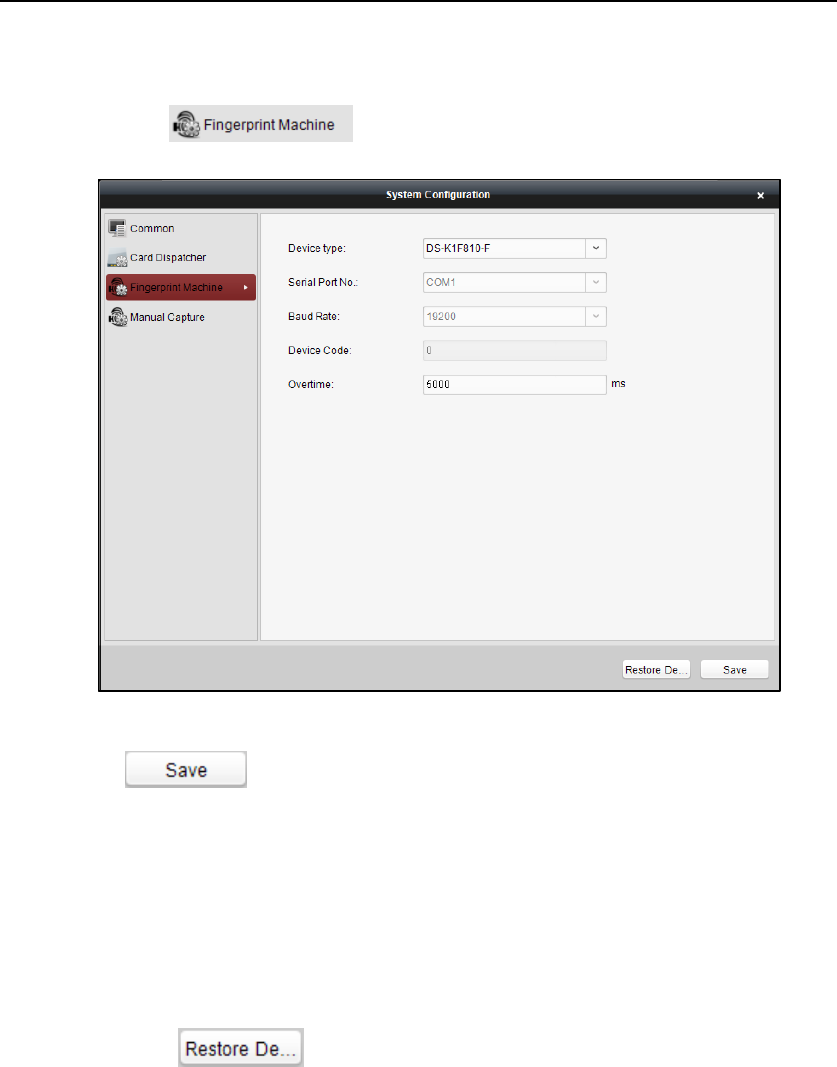
Fingerprint Time Attendance Terminal
111
Fingerprint Machine Configuration
Steps:
1. Click the icon on the System Configuration interface to
open the Fingerprint Machine Configuration page.
2. Select the device type, serial port number, baud rate, device code, and
overtime parameters of the fingerprint machine.
3. Click to save the settings.
Note:
It is supported using device type as Optical Fingerprint Collecting Instrument.
The serial port number should correspond to the serial port number of PC.
The baud rate should be called according to the external fingerprint card
dispatcher. The default value is 19200.
Overtime refers to the valid fingerprint collecting time. If the user does not input
a fingerprint or inputs a fingerprint unsuccessfully, the device will indicate that
the fingerprint collecting is over.
You can click (Restore Default Value) to restore the defaults of all
local settings.
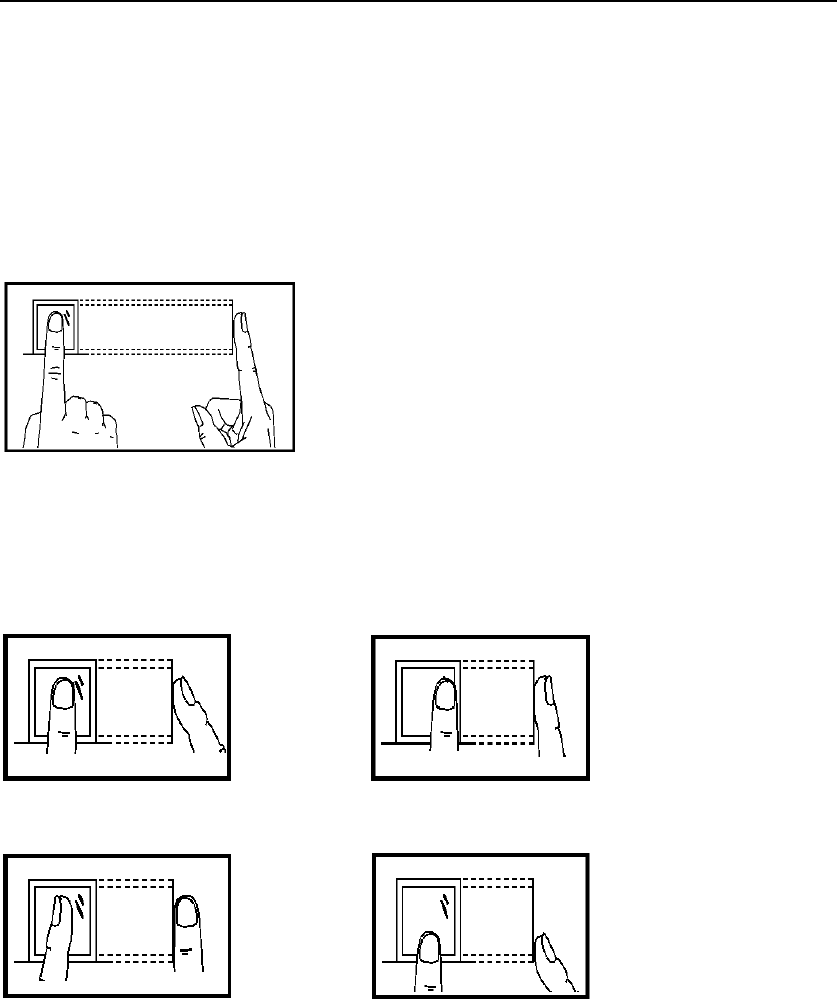
Fingerprint Time Attendance Terminal
112
Chapter 5 Appendix
5.1 Tips for Scanning Fingerprint
Recommended Finger
Forefinger, middle finger or the third finger.
Correct Scanning
The figure displayed below is the correct way to scan your finger:
You should press your finger on the scanner horizontally. The center of your scanned
finger should align with the scanner center.
Incorrect Scanning
The figures of scanning fingerprint displayed below are wrong:
Environment
The scanner should avoid direct high light, high temperature, humid conditions and
rain.
When it is dry, the scanner may not recognize your fingerprint successfully. You can
blow your finger and scan again after drying the finger.
Others
If your fingerprint is shallow, or it is hard to scan your fingerprint, we recommend you
to use other authentication methods.
If you have injuries on the scanned finger, the scanner may not recognize. You can
change another finger and try again.
Side
Edge II
Vertical
Edge I

Fingerprint Time Attendance Terminal
113
5.2 Attendance Record Delete Rule
5.2.1 Enabling Record Delete
You are able to configure the percentage of the attendance record over threshold
prompt.
1) When the record reaches the threshold, an alarm of the attendance record
over limit value will be displayed on device screen. The alarm information is:
Log will be full, export the report. Card authentication is available. The
interface will be back to the alarm interface after authenticating.
2) When the record is full, an alarm of the attendance record over limit value
will be displayed on the device screen. The alarm information is: Log is full,
export the report. Card authentication is available. And the first 3000
attendance records will be deleted automatically. The interface will be back to
the alarm interface after authenticating.
3) Deleting by time and deleting all are available when deleting the attendance
records.
5.2.2 Disabling Record Delete
You are able to configure the percentage of the attendance record over threshold
prompt.
1) When the record reaches the threshold, an alarm of the attendance record
over limit value will be displayed on device screen. The alarm information is:
Log will be full, export the report. Card authentication is available. The
interface will be back to the alarm interface after authenticating.
2) When the record is full, an alarm of the attendance record over limit value
will be displayed on the device screen. The alarm information is: Log is full,
export the report. Card authentication is available. And there will be no new
attendance records added. The interface will be back to the alarm interface
after authenticating.
3) Deleting by time and deleting all are available when deleting the attendance
records.
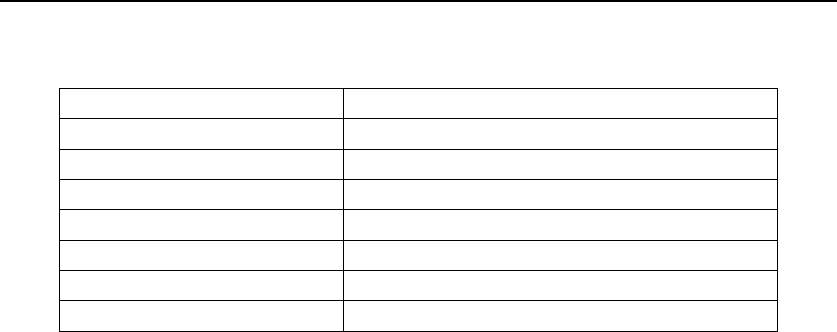
Fingerprint Time Attendance Terminal
114
5.3 Attendance Performance
Content
Maximum Configurable Parameters
Department
32
Normal Shift
32
Man-Hour Shift
32
Holiday
32
Holiday Group
64
Schedule by Department
32
Schedule by Individual
32
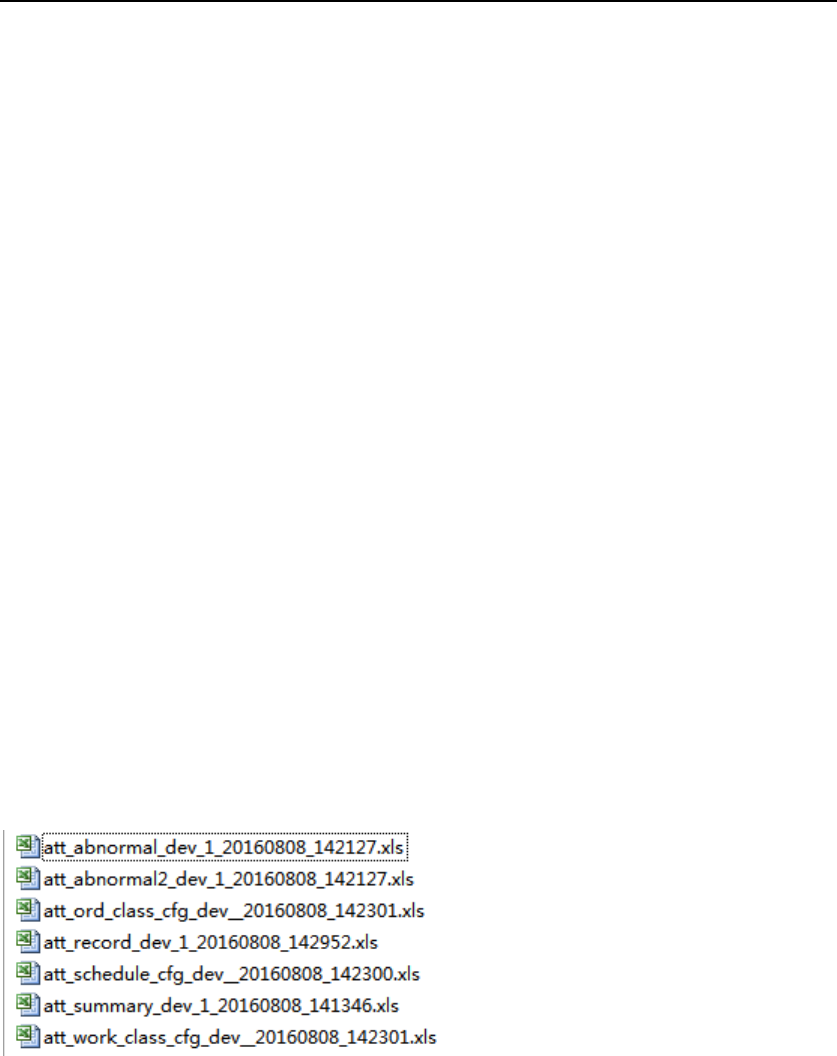
Fingerprint Time Attendance Terminal
115
5.4 Attendance Report Table
5.4.1 Description of Attendance Report File Name
File Name Rule
att_Report Type_dev_Device No._Date_Time.xls
Report Type
abnormal: The Abnormal Attendance Record table.
abnormal2: When the row of the Abnormal Attendance Record table is more than
65000, the record will be export in two tables. Here abnormal2 refers to the second
table.
summary: The Attendance Report table.
record: The Attendance Record table.
schedule_cfg: The shift schedule configuration table.
ord_class: The normal shift configuration table.
work_class: The man-hour shift configuration table.
Device No.
A serial of numbers from 0 to 8.
Date
YYYYMMDD
Time
HHMMSS
Example
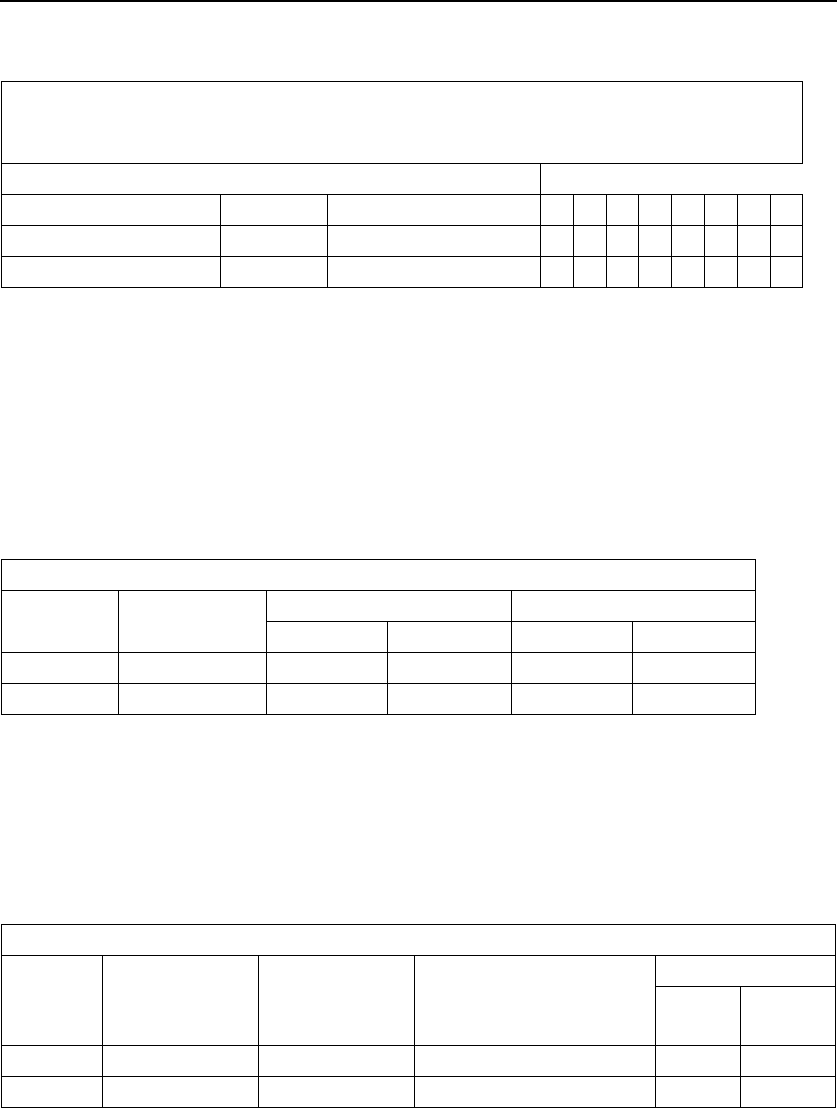
Fingerprint Time Attendance Terminal
116
5.4.2 Attendance Report Table Description
Shift Settings Table
Special Shift:1-1 Normal Shift1 2-1 Man-Hour Shift1 0 No Shift 3Holiday
Date
2016/4/10
Employee ID
Name
Department
1
2
3
4
5
6
7
8
Shift Settings Table: All users shift schedule information for a period will be displayed
in this table. You are able to set the shift information and the holiday (No attendance
recorded during the holiday) in shift schedule configuration.
1. ID No.: The user's ID No.
2. Name: The user's name.
3. Department: The department of the user.
4. Header: The number from 1 to 31 refers to the shift schedule days. For example: If
entering 2016.8.26 to 2016.9.15, header 1 refers to the shift schedule information in
2016.8.26.
Normal Shift Schedule
Shift No.
Shift Name
Period 1
Period 2
On Work
Off Work
On Work
Off Work
Normal Shift Table: Up to 4 periods can be configured in normal shift
configuration. You are able to take attendance according to the configured
period.
For example: If set Period 1 to 9:00 (On Work) and 17:00 (Off Work), it is effective
for the user to take attendance between 9:00 and 17:00.
Combining with the attendance rule, you are able to set multiple attendance
types.
Man-Hour Shift Schedule
Shift No.
Shift Name
Duration
Latest On-Work Time
Break Period 1
Start
End
Man-Hour Shift Table: Set the Man-Hour Shift working duration. If set the Latest On-Work
Time to 0, all users are attendant. If set the Latest On-Work Time to more than 0, the user
will be absent by taking attendance after the configured time. The Break Period will not be
configured in the man-hour shift.
For example: If set the working duration to 6 hours, the on-work time to 09:00, the off-
work time to 17:00 and the break period 1 to 12:00 to 13:00, the user actual working hour
is 17:00 - 09:00 - (13:00 - 12:00).

Fingerprint Time Attendance Terminal
117
Abnormal Attendance Record
Date:2016/04/01 ~2016/04/30
Employee ID
Name
Department
Date
Period 1
Period 2
On Work
Off Work
On Work
Abnormal Attendance Record Table: Calculate the abnormal attendance according to the
attendance records and the shift schedule configuration.
1. Employee ID: The user's ID No.
2. Name: The user's name.
3. Department: The department of the user.
4. Date: the date of the data generated.
5. Period 1 to Period 4: Up to 4 periods can be configured. It records the attendance time
of each user every day.
6. Late (Minute): The on-work attendance time is later than the normal on-work time.
7. Early Leaving (Minute): The off-work attendance time is earlier than the normal off-
work time.
8. Absence (Minute): No normal working hour.
9. Total: The normal working hour of the day.
Attendance Record
Attendance Checking Time:2016/04/01~2016/04/30 Tabulation Time:2016/04/30
1
2
3
4
5
6
7
8
9
10
#
Employee ID:1 Name:111 Department:aaa
Employee ID:2 Name:222 Department:
bbb
Attendance Record Table: Input the start time and the end time to export the effective
attendance data during the configured duration.
1. Hearder: The number from 1 to 31 refers to the shift schedule days.
For example: If entering 2016.8.26 to 2016.9.15, header 1 refers to the shift schedule
information in 2016.8.26.
2. Employee ID: The user's ID No.
3. Name: The user's name.
4. Department: The user's department.
Attendance Report
Counting Date:2016/04/01 ~2016/04/30
Employee ID
Name
Department
Duration
(Hour:Munite)
Late
Standard
Actual
Frequency
Minute
1
111
aaa
12:00
11:00
1
20

Fingerprint Time Attendance Terminal
118
2
222
bbb
12:00
11:00
1
30
Attendance Report Table: Enter the start time and the end time to calculate the user
attendance information via the shift information and the holiday information according
to the shift schedule configuration.
1. Emplayee ID: The user's ID No.
2. The user's name.
3. Department: The user's department.
4. Duration:
Standard: Total standard working hours in the duration.
Actual: Total actural working hours in the duration.
Actural Hours = Standard Value - Late Hours - Early Leaving Hours
5. Late: The on-work attendance time is later than the normal on-work time.
Frequency: Late arriving for no more than once every day.
Minute: All late arriving minutes in the duration.
6. Early Leaving: The off-work attendance time is earlier than the normal off-work time.
Frequency: Early leaving for no more than once every day.
Minute: All early leaving minutes in the duration.
7. Over Time: No records.
8. Attendance Days:
Standard: Standard attendance days in a duration, exculding the holidays and the
days without shift schedule.
Actual: Actual attendance days in a duration. Actural Days = Standard Days - Absent
Days
9. Business: No records.
10. Absence: Do not take attendance in the normal working days.
11. Leave: No records.
1000001060829
